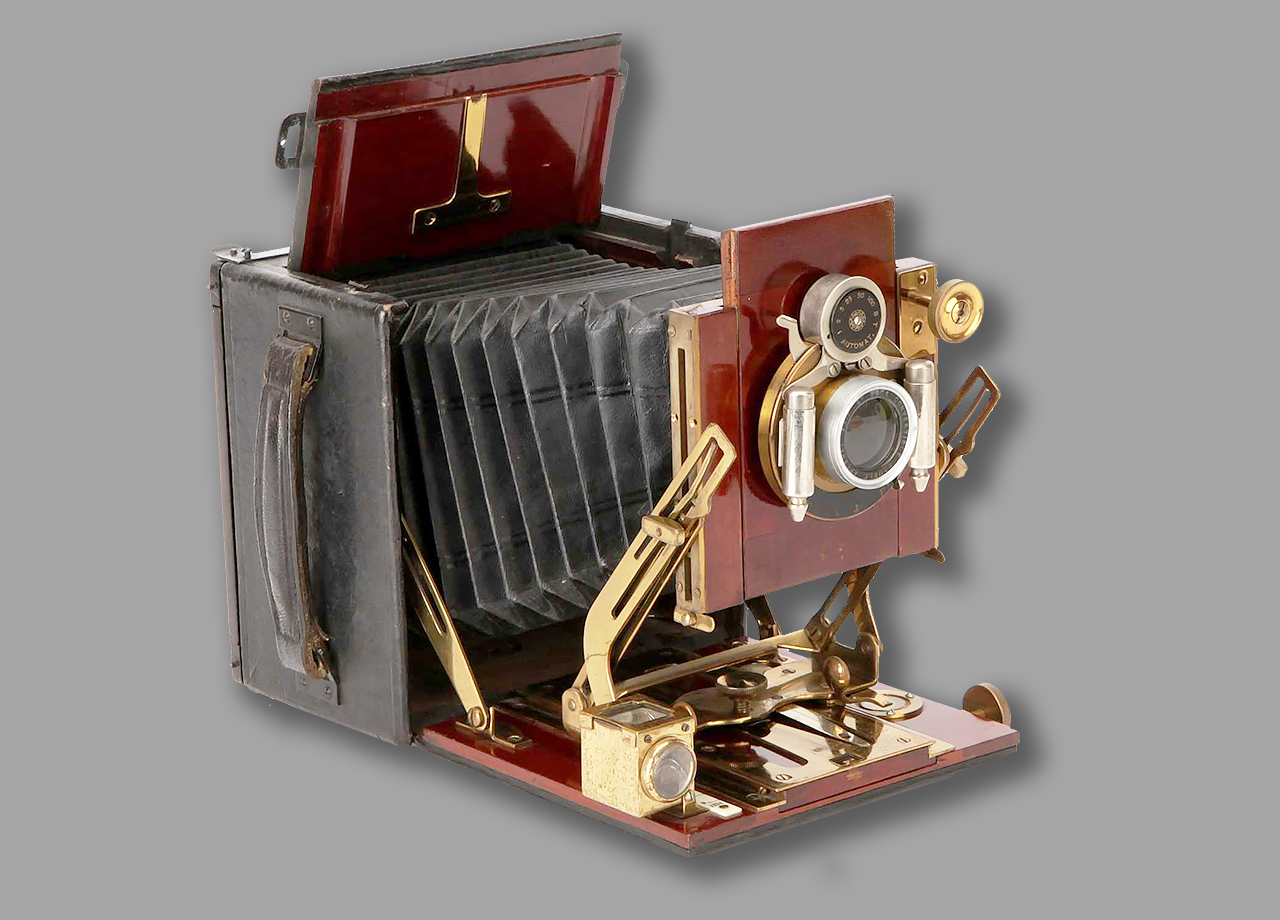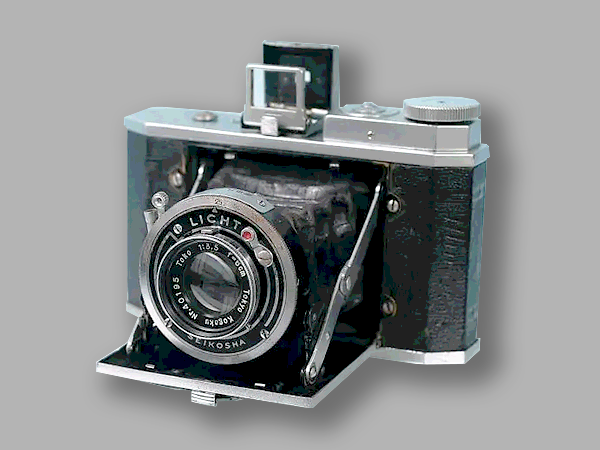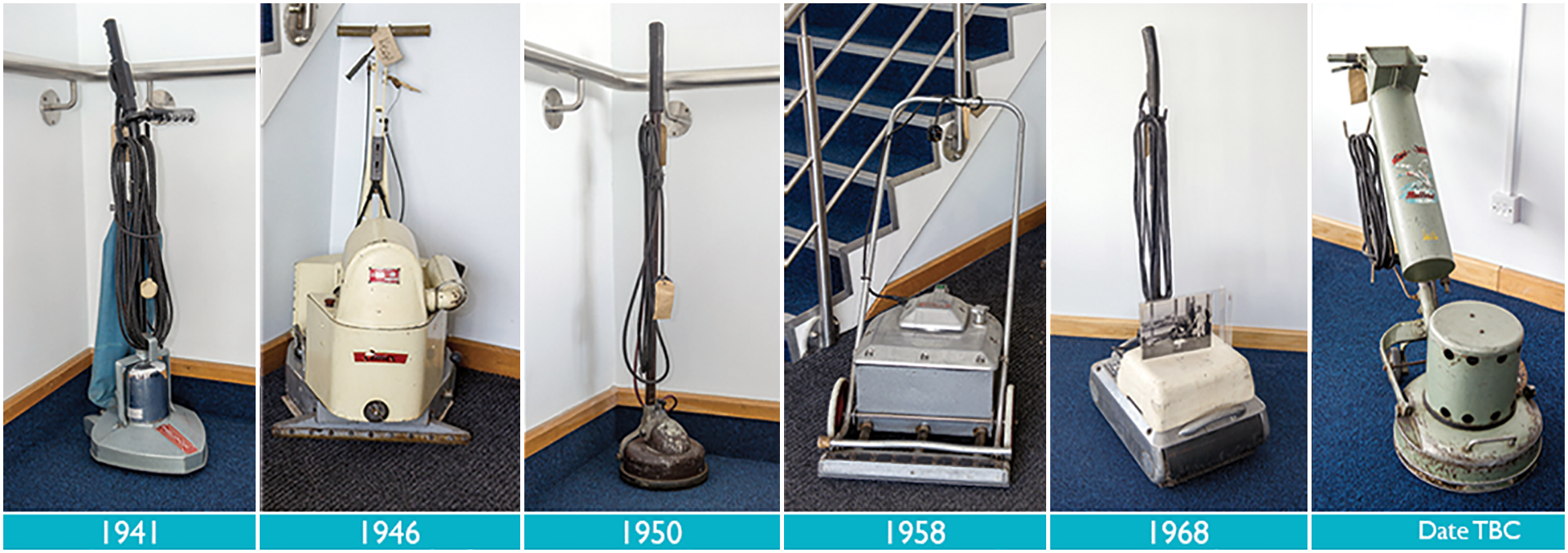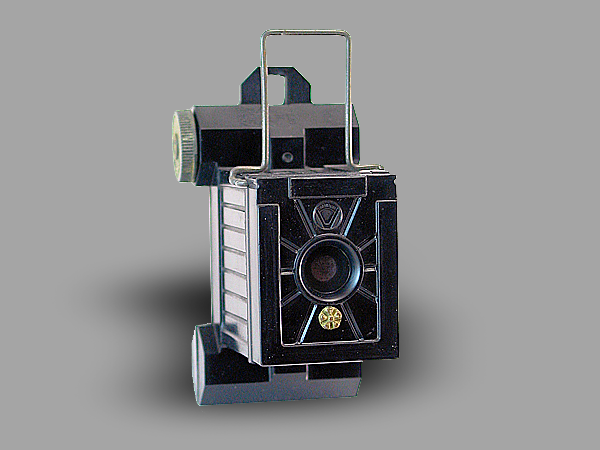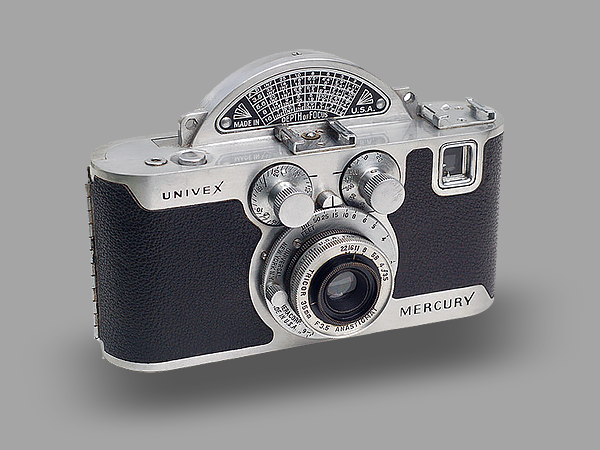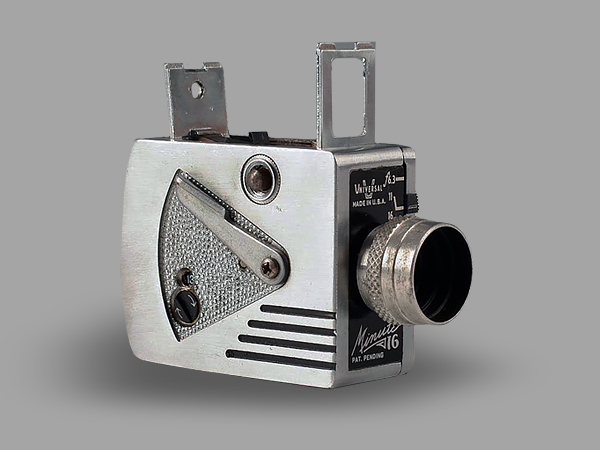Some of the following companies that manufacture(d) photographic material have already passed by in other parts of the site. Here you will find an overview of companies that marketed photographic material in the nineteenth and twentieth centuries. More is usually known about the best known or the most influential companies than about the lesser known ones; therefore they will be discussed more extensively than others.
The emphasis in this part of the site is more on the ups and downs of the company as such, while in other chapters the emphasis was on the product or on the man or woman who founded the company. The order of all companies is alphabetical.
Below are the names of the companies as will be discussed in this or any other chapter. By clicking on a name (so not on the bullet in front of it), you go directly to that part on this page where the manufacturer in question is located. Scrolling is also possible of course, but this service helps you to get to the desired manufacturer in question much faster.
Due to the fact that this introductory page has become much longer than originally planned and desirable due to the large number of manufacturers, we strongly advise you to use the name service below to go to the manufacturer of your choice on this or any subsequent page.
- General Introduction
- ADOX
- Agfa (see also Gevaert)
- Altissa
- Amaloco
- Ansco Camera Co (see also GAF)
- APM/APeM (see also Soho)
Amalgamated Photographic Manufacturers Ltd - Argus Camera Co, Ann Arbor Michigan
- Arsenal (see Kiev-Arsenal)
- Artima Export Ltd (see also Truvox)
- Asahi Pentax
- Bencini
- BOLCo and E Elliott Ltd
(abbrev. for The British Optical Lens Company) - Carl Braun Kamera-Werk
- Canon Inc.
- J.T. Chapman, Manchester
- The Chicago Cluster of Companies
(consisting of 56 companies ) - Chinon
- Concord Camera Corp.
- K.G. Corfield & K.G. Corfield (Sales) Ltd.
- Coronet Camera Company
- Cosina Company, Ltd.
- Dacora
- Dixons
- Durst
- EHO-Altissa company (See Altissa)
- E Elliott Ltd and BOLCo
(abbrev. forThe British Optical Lens Company) - Ellison Kamra
(see also QRS Devry Kamra Company) - ELOP
- Ensign Ltd. (distribution Company of Houghton-Butcher)
- Ernemann-Kamerawerke AG
- Expo Camera Company
- The FED Company
- Ferrania
- Fisher-Price
- Fodor
- Foitzik-Kamerawerke
- C.F. Foth
- Fototecnica
- Franka Kamerawerk
- Fujica (Camera Division of Fujifilm)
- Fujifilm (brief history)
- Futura
- GAF (see also ANSCO)
(abbrev. for General Aniline & Film) - Louis Gandolfi
- Herbert George Company
- Gevaert Photo-Producten N.V. (see also AGFA)
- Girard et Cie
- GNOME
- GOERZ
- GOMZ (LOMO)
- Graflex (Folmer & Schwing)
- Great Wall Plastics Co
- W. Haking Enterprises Ltd.
- Hanimex
- Hasselblad
- Healthways
- Houghton–Butcher Manufacturing Co (See also Ensign Ltd. and Ross-Ensign Ltd.)
- R.F. Hunter Ltd.
- ICA AG
- Ihagee (Exakta)
- Ilford
- Imperial Camera Corporation
(see the Herbert George Company story ) - Jos-Pe
- Kamera-Werkstätten Guthe & Thorsch
- Keystone
- Kiev Arsenal
- KMZ
- Kochmann
- Kodak USA (incl. Australia, Canada, France, Germany & the UK)
- Konica-Minolta (Konishiroku)
(see also Minolta) - Kowa
- Krügener
- Kürbi & Niggeloh (Bilora)
- Kyocera (Yashica, Contax)
- Lancaster
- Leitz
- Lensless Camera Manufacturing Company
- Linhof
- Lipca (see also Richter-Tharandt)
- LOMO (see GOMZ)
- Loreo
- Mamiya
- Meopta Optotechnica
- Mimosa AG
- Minolta (see also Konica-Minolta)
- Minox Company
- Miranda (Orion)
- MMZ-BeLomo
- Motodori (Condor)
- Dr. August Nagel Kamera Werke
- Neidig Kamerawerk
- Nemrod-Metzeler (See Healthways)
- Nettel
- Nikon Company
- Nimslo Corporation (see also Nishika)
- Nishika Optical Systems (see also Nimslo)
- Noblex (See also K-W Guthe & Thorsch)
- Olympus Company
- ORION (see Miranda)
- ORWO
- Ottico Meccanica Italiana (OMI)
- Paterson Products Ltd.
- VEB Pentacon Dresden
- Pentax (See Asahi Pentax)
- Petri
- Photavit (Bolta)
- Plaubel
- Polaroid
- Photo Porst
- Karl Pouva – VEB Fototechnik Freital (see also Woldemar Beier)
- Purma Cameras Ltd.
- QRS Devry Kamra Company (see also Ellison Kamra)
- Foto-Quelle
- Rectaflex
- VEB Rheinmetall Büromaschinenwerk
- Richter-Tharandt (see also Lipca)
- Ricoh
- Rollei Germany
- Rollei Singapore
- Ross-Ensign (continuation from Ensign Ltd.)
- Ro-To Company
- Sea&Sea-Sunpak
- Shanghai Seagull
- Sida-Fotofex
- Sigma
- Soho Ltd (see also APM)
- Standard Cameras
- Steinheil
- Stenopeika
- Thornton-Pickard
- Topcon (Tōkyō Kōgaku)
- Tougodo Company
- Traid Corporation
- TRUVOX (see also Artima Export)
- Tura AG
- Universal Camera Corp.
- Vivitar
- Voigtländer
- Vredeborch
- Welta
- Werra (C. Zeiss Jena)
- Wirgin
- Kamera-Fabrik Woldemar Beier (see also Karl Pouva)
- Hermann Wolf GmbH
- Wünsche
- Yashica (see also Kyocera)
- Zeiss Ikon AG
- Zion
- Zunow (Teikoku Kōgaku)
FOUNDER: John Edward Thornton
COMPANY NAMES:
1886 – ± 1887: J.E. Thornton; ± 1887 – 1888: Thornton Manufacturing Co.; 1888 – 1897: Thornton-Pickard Manufacturing Co.; 1897 – : Thornton-Pickard Manufacturing Co. Ltd.; 19??: Thornton-Pickard Manufacturing Company Ltd. Photographic Apparatus; The company remained as a maker of quality cameras until its end in 1939.
COMPANY ADDRESSES:
1886: 3 New Lorne St., Moss Side, Manchester; ± 1887: 54 King St. West, Manchester; ± 1887 – 1891: St Mary’s St., Deansgate, Manchester; 1891 – : Broadheath, Altrincham , Cheshire (later moving to Greater Manchester), UK.
Thornton-Pickard was one of Britain’s largest photographic companies established in 1888 and closed in 1939 which had its heydays from the 1890s to 1918. The company was based in Altrincham, near Manchester, and was an early pioneer in the development of the camera industry.
 From 1880 to 1886 John Edward Thornton (1865-1940) was in an apprenticehip at the renowned printing company George Faulkner & Sons. There he began to work on a new camera (the Jubilee) and the Time roller blind shutter.
From 1880 to 1886 John Edward Thornton (1865-1940) was in an apprenticehip at the renowned printing company George Faulkner & Sons. There he began to work on a new camera (the Jubilee) and the Time roller blind shutter.
In 1886 he founded a trading company that sold cameras and shutters. Among these items were those on which he had received patents. They were produced by others. The Jubilee for example was made by Billcliff of Manchester.
Advertisements for his earliest camera – the Jubilee – show it to have Billcliff’s patented revolving back, a year later cameras are fitted with Thornton’s revolving back. This may indicate that Thornton was now making or assembling cameras.
By 1887 Thornton could present a whole palette of products in a Royal Jubilee Exhibition. At the same time, he launched his Thornton Manufacturing Company to take over the production of his shutters and cameras. At the end of that year he held 12 patents.
He won engineer and business manager Edgar Pickard as a partner with whom he re-launched his company as Thornton-Pickard Manufacturing Company Ltd. in 1888. They focused on the production of shutters which were highly in demand, and added the camera model Artist to their other products.
Some years later they moved from Manchester to Altrincham. Until then George Pickard, the father of Edgar Pickard, had helped financially to launch the business. For a while they reduced camera production to making only their newest model, the Ruby camera, later adding the Amber.
Thornton kisses his company goodbye
E. Thornton’s relations with Edgar Pickard were troublesome, however things became worse for the company when Edgar Pickard died in March 1897 at the age of 35. Edgar Pickard’s oldest brother George Arthur Pickard, a business manager, took over the leading role at Thornton-Pickard shortly after its re-launch as public limited company.
Thornton now found himself in a company dominated by the Pickard family, who he disliked intensely, and shortly afterwards he left. In 1899, he formed a new business partnership with Charles Rothwell, a chemist who shared Thornton’s interest in photography. The company was called the Thornton Film Company.
Thornton’s engineering talent wasn’t limited to cameras and shutters and he made several new attempts in entrepreneurship. One attempt was to patent a film pack, called ‘Daypack’. Rochester Optical Co. expressed interest in this, which resulted in a treaty with Thornton. After Kodak took over Rochester Optical Co. in 1903, Thornton continued to receive royalties for the film pack.
In May that year George Arthur Pickard could announce to the company’s shareholders’ first general assembly a rapid increase of camera sales. The shutter maker had been successfully transformed into a camera maker.
Nonetheless J. E. Thornton and G. A. Pickard were in frequent disagreement so that Thornton’s departure was announced in an extraordinary general meeting in 1898. G. A. Pickard led the company until his death in 1919.
Camera LIst
- Jubilee
- Cyclum
- Tourist

- Artist
- Ruby
- Amber
- Royal Ruby stereo camera
- Tribune
- Imperial double- or triple-extension
- Imperial Focal Plane
- Automan
- Totator
- Wafer
- Weenie
- Snappa
- Clipper
- Limit
- Royal Ruby
- Imperial Perfecta
- Nimrod Automan hand camera
- Folding Ruby hand camera
- New Folding Ruby No.2
- Focal-Plane Folding Ruby Tropical camera
- Stereo Unit Folding Ruby camera
- Special Ruby
- Vest Pocket Minim
- Imperial Pocket No. 2
- Safety Magazine camera
- Ruby Reflex
- College
- Praetor
- Filma (2¼x3¼ box camera)
- Special Ruby Reflex
- Type “A” Aero Camera
- Type “C” Aero Camera
- Type “E” Aero Camera
- III Hythe Camera Gun
- Imperial Portrait Camera
- Rubyette
- Victory Reflex
- Overseas
- Sports Reflex
- All Weather Press Camera
- Junior Special Reflex similar to Junior Special Ruby Reflex
- Portrait Puck
- Puck box camera
- Stereo Puck
- Rollfilm Ruby
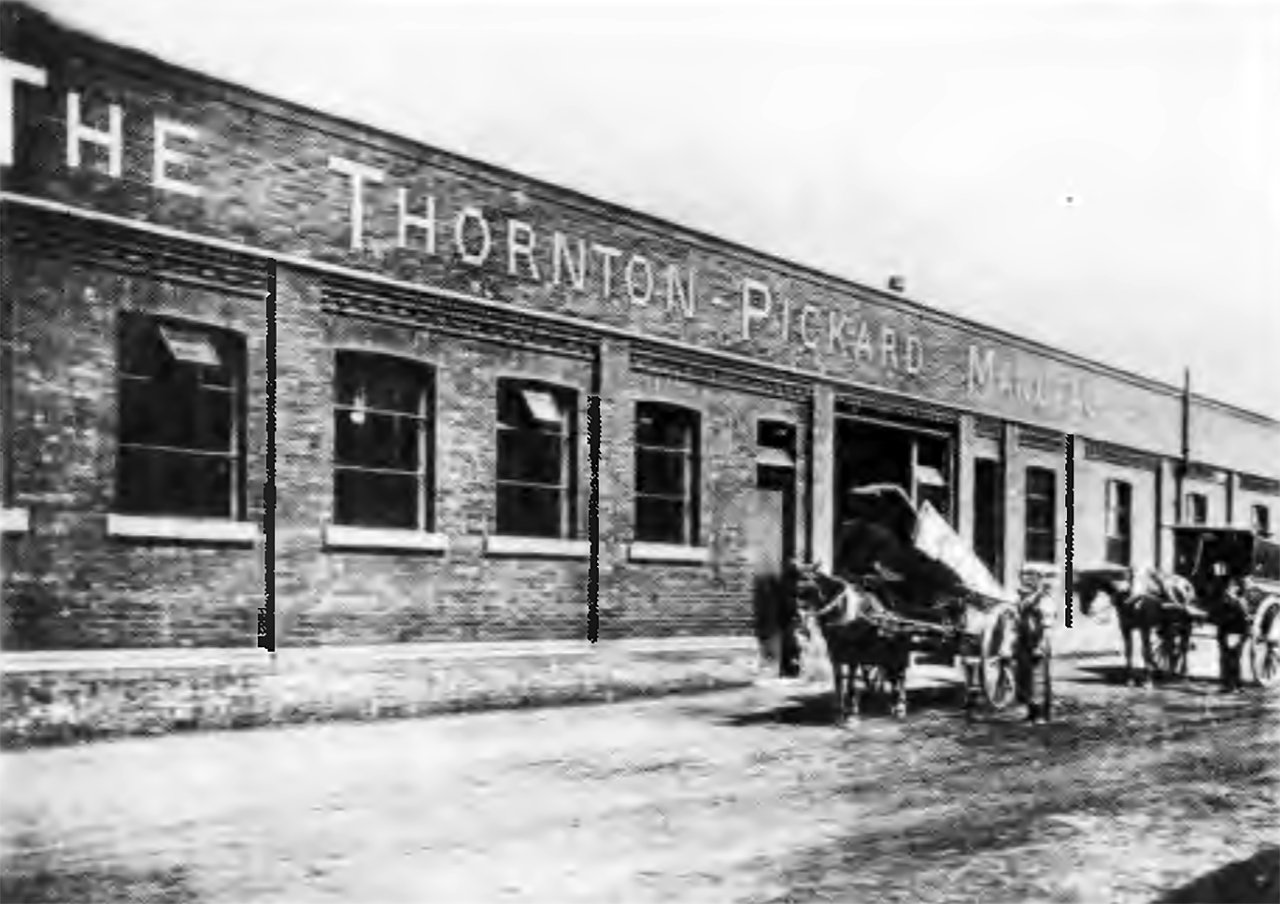
The Thornton-Pickard works c.1895
Heydays of the company
Despite of the loss of its two founders the Thornton-Pickard Manufacturing Company Ltd. Photographic Apparatus flourished under G. A. Pickard, becoming a leading British camera maker. With modern machines it could achieve cost reductions in some areas so that some budget camera models could be offered.
For example, the Imperial Triple Extension Camera was sold as the 17-Shilling-Set. It was introduced in 1913 and continued in production until the 1930s. And the Tribune was offered for a guinea as camera for beginners.
Later a series of cheap snapshot cameras was added: Snappa, Clipper, and Limit. On the other hand, Thornton-Pickard’s new flagship series was born: The Ruby Reflex SLRs.
Around 1913 Thornton-Pickard acquired the business of the Midland Camera Co. Ltd. (M.C.C.) and continued to produce M.C.C. enlargers.
Also in 1913, Thornton emigrated to the United States and went on to patent a three-colour cine film that was manufactured under license by Eastman Kodak. Thornton eventually returned to England, and died some years later in 1940.
The demise of the company
During the First World War, the company produced a number of cameras for military use, including the Mark III Hythe gun camera. After the First World War there was a hopeful restart when wartime security policies concerning photography ended. After G.A. Pickard’s death Arthur Gray Pickard took over the lead. Besides new cameras the company launched the Picabrik construction kit for children.
However, the 1920s started with a trade depression that turned the company’s hopeful restart into its slow decline. In 1921, the company merged with several others to form Amalgamated Photographic Manufacturers. Throughout the 1920s and 1930s, the company found it increasingly difficult to compete with cheaper imported cameras, and ceased trading in 1939.
Throughout the 1920s and 1930s, the company found it increasingly difficult to compete with cheaper imported cameras, and ceased trading in 1939. A repair service was kept alive until ca. 1960.
a few examples of Thornton-Pickard cameras
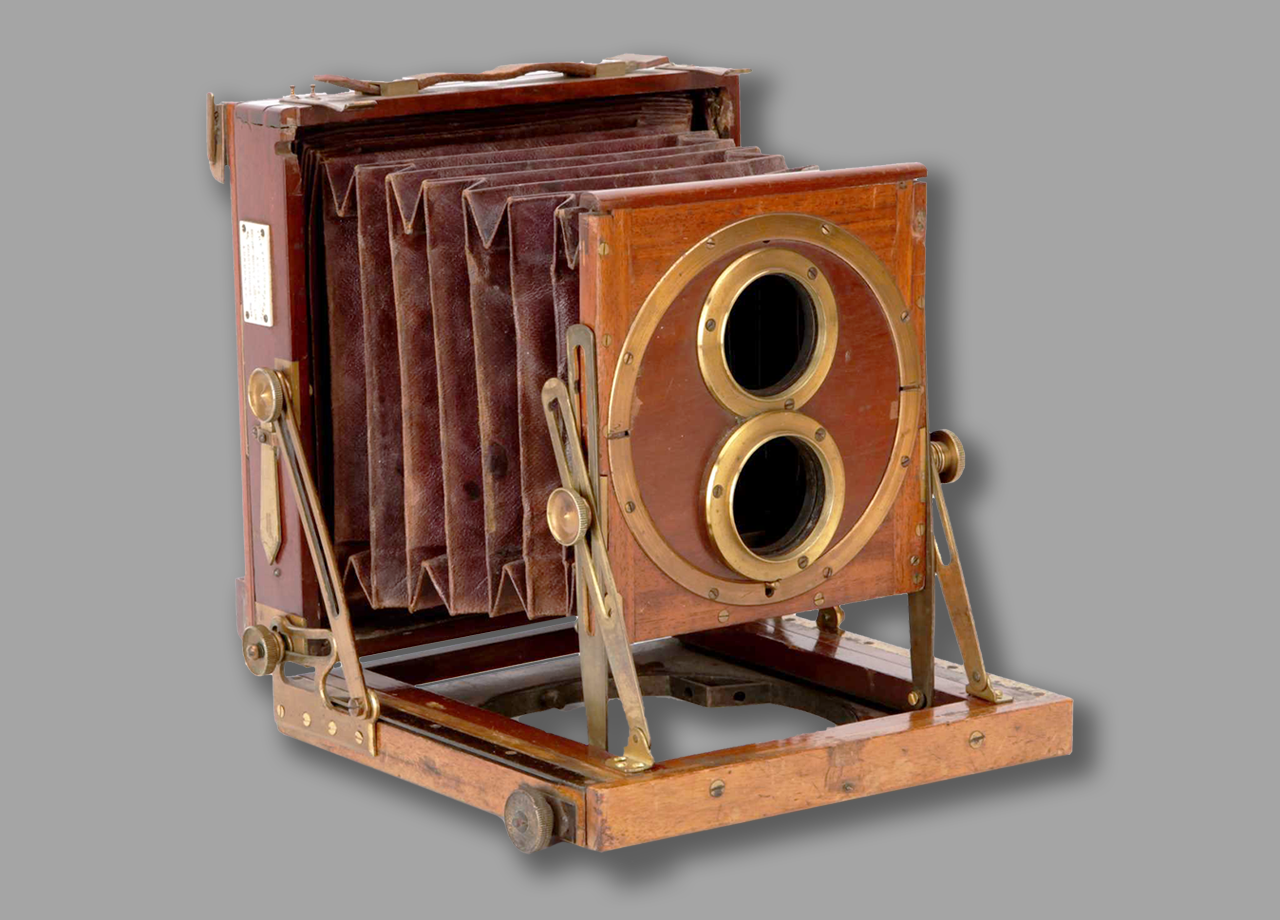
A Thornton-Pickard Patent ‘Tourist’ Half Plate Mahogany Camera with double rotating lens mount, 1887. This is the earliest model of Thornton’s “Patent Tourist” Camera, made a year after Thornton’s first camera, the 1886 “Jubilee”. It has a distinctive circular front panel, to take two lenses.
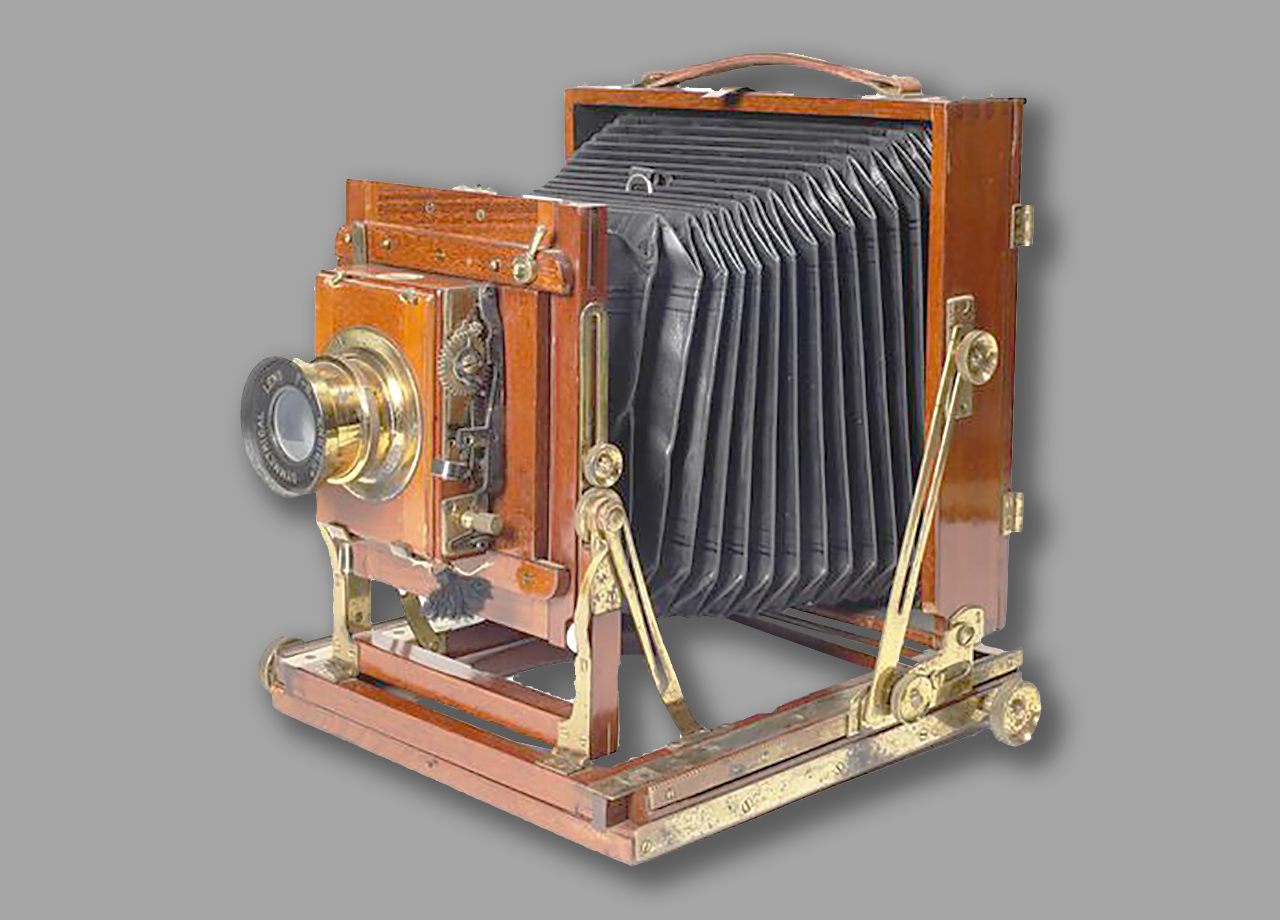
A Thornton-Pickard Imperial Whole Plate Mahogany Field Camera 1904-1910, with Taylor Rapid Rectilinear 13″ lens.
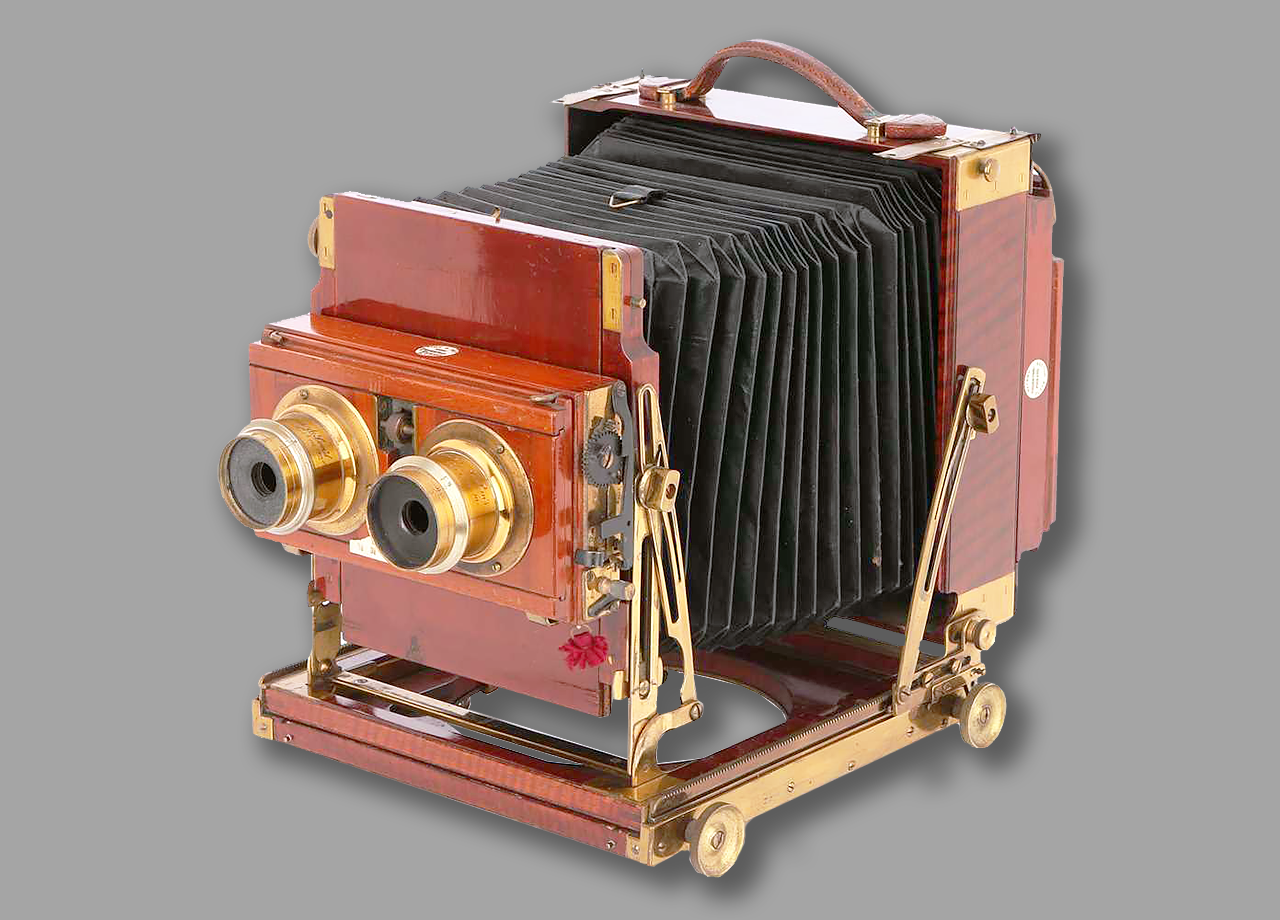
A Thornton Pickard Royal Ruby Triple Extension Stereo Half Plate Mahogany Field Camera 1900, with J. Lancaster & Sons f/10 brass lenses.
FOUNDING DATE: 1932
FOUNDER: Merger of Seikōsha and Katsuma Kōgaku Kikai Seisakusho
COMPANY NAMES:
1932: Tokyo Kogaku Kikai Kabushikikaisha, or Tokyo Optical Co. Ltd.; 1989: Topcon Corporation.
COMPANY ADDRESSES:
1933: 180, Shimura-motohasunuma-cho, Itabashi-ku, Tokyo.
Topcon Corporation is one of the world’s leading manufacturers of optics-based instruments, and is also the world’s leading producer of positioning systems. Here we are mainly concerned with the cameras and lenses that Topcon developed during its existence.
 Topcon Corporation’s roots lie in the period leading up to World War II, and the efforts by the Japanese military government to develop the country’s industrial and technological independence.
Topcon Corporation’s roots lie in the period leading up to World War II, and the efforts by the Japanese military government to develop the country’s industrial and technological independence.
In 1932, K. Hattori and Co., the future Seiko Corporation, agreed to a request from the Japanese Ministry of War to merge its surveying instruments operations with the lens production business of Kogaaku Kikkai Co. Limited. The resulting company was named Tokyo Kogaku Kikai Kabushikikaisha, or Tokyo Optical Co. Ltd.
Tokyo Optical was charged with developing and producing optical instruments, including binoculars, cameras, surveying instruments, and optics-based weaponry for the Japanese army. It would also be a third party supplier to other companies but wouldn’t market it’s products directly to the public, at least not at first. Its earliest products were three and four element lenses known as the State, Toko, and Simlar.
The company also became an important producer of camera lenses for the fast-growing Japanese camera market, launching production of its first lenses in 1933. In that year, as well, the company moved to its permanent headquarters, at Shimura-motohasunuma-cho, Itabashi-ku, in Tokyo.
Backed by ever-increasing orders from the Japanese government, Tokyo Optical quickly grew into Japan’s leading optics company, helping to drive the rapid increase in lens and optics technology made by the country during that period. The company’s development of highly precise lenses played a prominent role in the country’s post-war dominance of the global camera industry.
The Lord, Topcon’s first camera
In 1937, a camera called the Lord was released, a solid bodied 6×4.5 medium format rangefinder with a collapsible lens, which was not a big success. It is estimated that only 50 were ever made between 1937 and 1938 and that production was halted due to an outbreak of war between Japan and China. Some historians believe this to be only part of the reason, as the Lord was known to be poorly built and unreliable.
This 1937 Lord camera should not be confused with another Lord series of cameras made in the mid 1950s by Okaya Kogaku who was also a child company of Seikosha. Apparently, they liked the name “Lord” so it was re-used on this completely unrelated camera.
The only other camera made by Tokyo Kogaku prior to the war was the Minion, a horizontally folding strut camera that took 4x 5cm images on 127 film. The Minion was much more successful than the Lord as it was made until 1943 and then again shortly after the war.
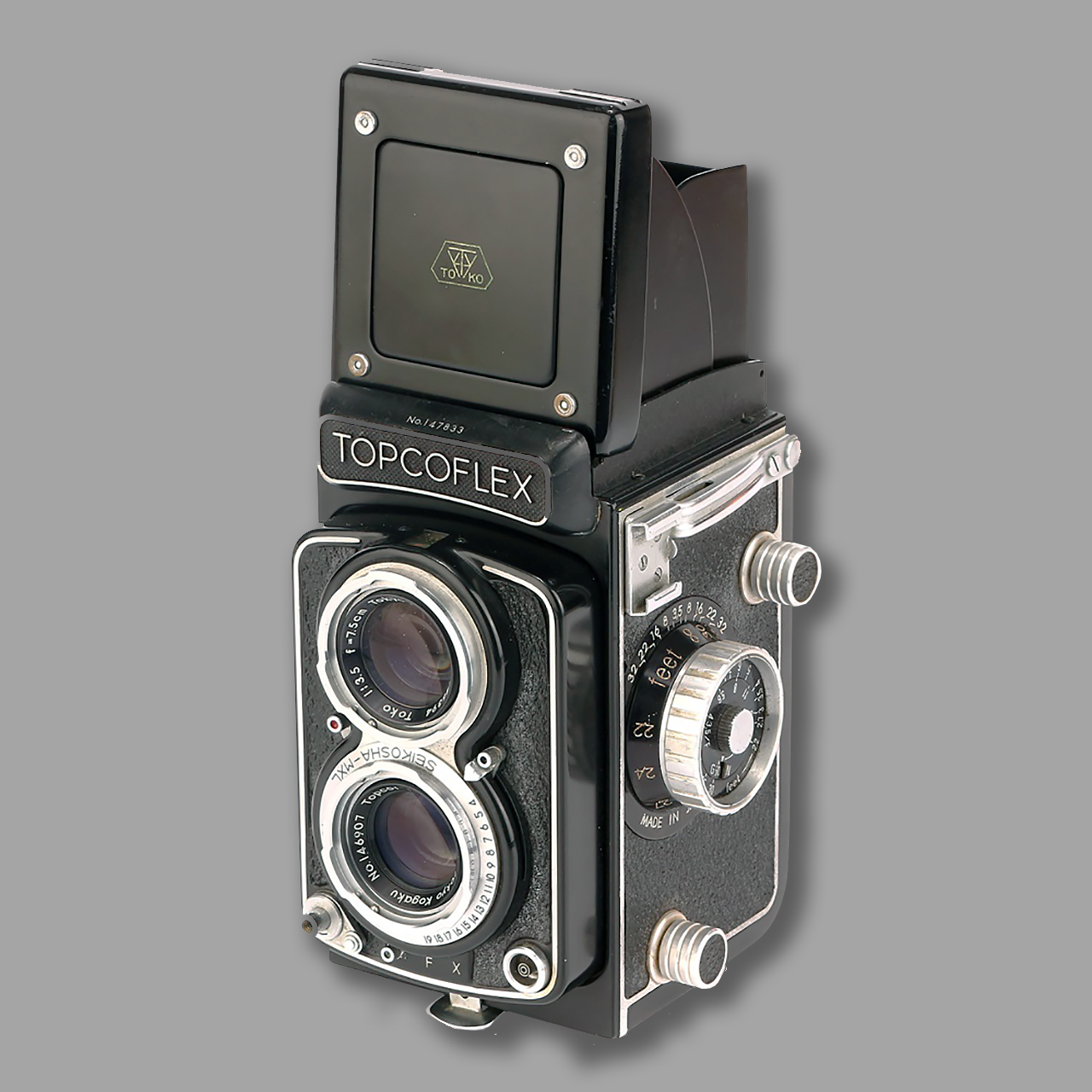
Tokyo Kogaku: Topcoflex; c1951. 120 film, 6x6cm exposures, TLR camera. Same as Primoflex and Laurelflex.
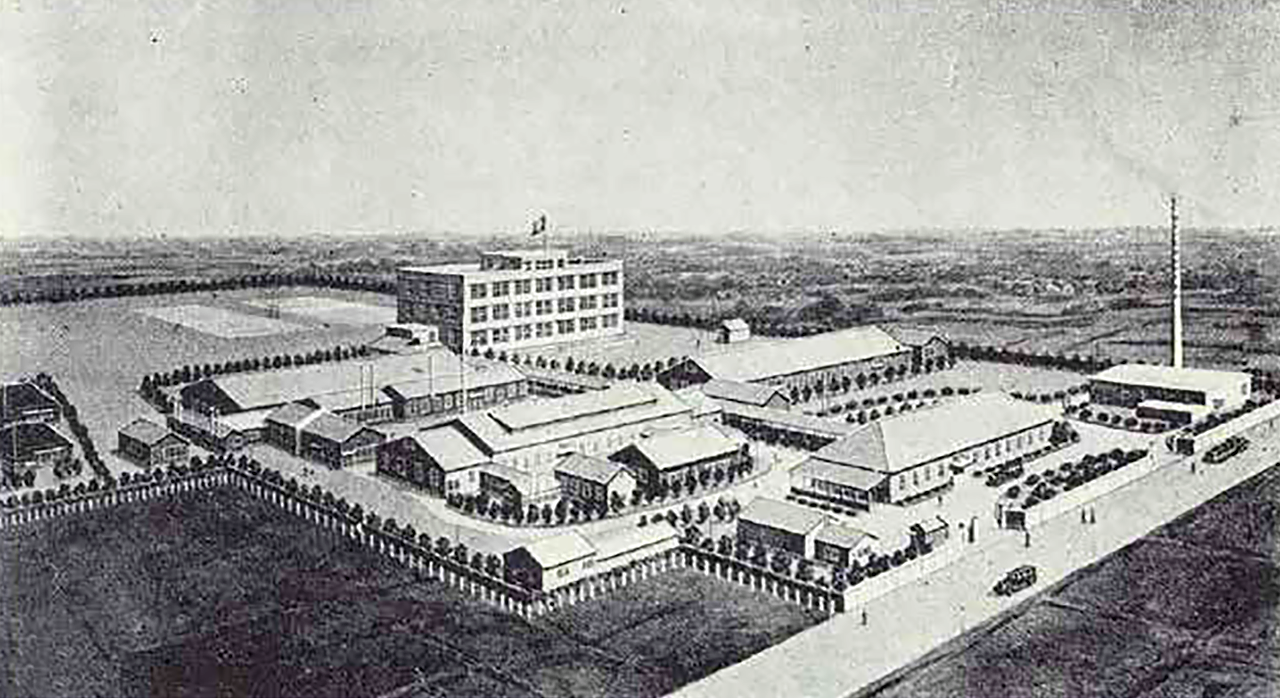
Topcon Headquarters in Tokyo circa 1933
Japan post-war
Following the Japanese surrender in 1945, Tokyo Optical was forced to shut down its operations. By the end of that year, however, the company had negotiated the right to resume business and focused on developing products for the civil sector.
 The company then launched production of binoculars, as well as other surveying instruments. At this time, the United States became the company’s most important market, and by the end of the 1950s, Topcon had helped establish Japan as the dominant maker of binoculars in the United States.
The company then launched production of binoculars, as well as other surveying instruments. At this time, the United States became the company’s most important market, and by the end of the 1950s, Topcon had helped establish Japan as the dominant maker of binoculars in the United States.
Tokyo Optical also entered the market for ophthalmic and medical instruments, creating a dedicated division for these products in 1947. In that year, as well, the company began producing light meters for the photography market.
This led the company to begin developing its own camera line, starting in 1948 with the production of 35mm cameras with the Minion 35 and of 6×6 TLR cameras in 1950 with the Topcoflex, mainly distributed as the Primoflex and Laurelflex. It was the first appearance of the “Topco” name, probably from Tokyo Optical Company.
The Topcon brand name appeared in 1953 on the Topcon 35A, successor of the Minion 35 series, and the Topcor lens name appeared in 1954, soon replacing all the previous lens names. (Topcon and Topcor were obviously modelled after Nikon and Nikkor.)
By then, the company had gone public, listing on the Tokyo and Osaka Stock Exchanges in 1949.
Topcon SLRs
Perhaps in an effort to stand out from the crowded medium format and 35mm rangefinder market in Japan, in the mid 1950s Tokyo Kogaku would begin work on their own 35mm SLR camera. The new camera would be released in 1957 and called the Topcon R. It was unique among Japanese cameras in that it used the Exakta Bayonet mount used on Ihagee Exakta cameras.
Tokyo Kogaku likely wanted to aim for the top of the market with their new SLR as the Exakta was the preferred SLR choice for professional photographers of that era. There was an abundance of Exakta mount lenses already available for it, allowing for an easy transition from someone who already had an Exakta system and was curious about a Japanese model.
 All three versions of the Topcon R were exported to North America where the original version was sold as the Beseler Topcon B and both the RII and RIII Automatics as the Beseler Topcon C.
All three versions of the Topcon R were exported to North America where the original version was sold as the Beseler Topcon B and both the RII and RIII Automatics as the Beseler Topcon C.
When it sold in the United States as the Beseler Topcon B, it had a retail price with the 50mm f/1.8 or 35mm f/2.8 Auto-Topcors of $295, which when adjusted for inflation, compares to $2780 today which was quite a high price for a first camera by a company that at the time was not well known to Western photographers.
Some models were marked Hanimex when imported in the Commonwealth.
The Topcon R was a robust and heavy camera that was significantly larger than competing models. Like the Exakta SLR, it used a cloth focal plane shutter, a front mounted shutter release, and had interchangeable viewfinders. The camera was such a success that the company would cease production of all other cameras, and would focus solely on 35mm SLRs from that point.
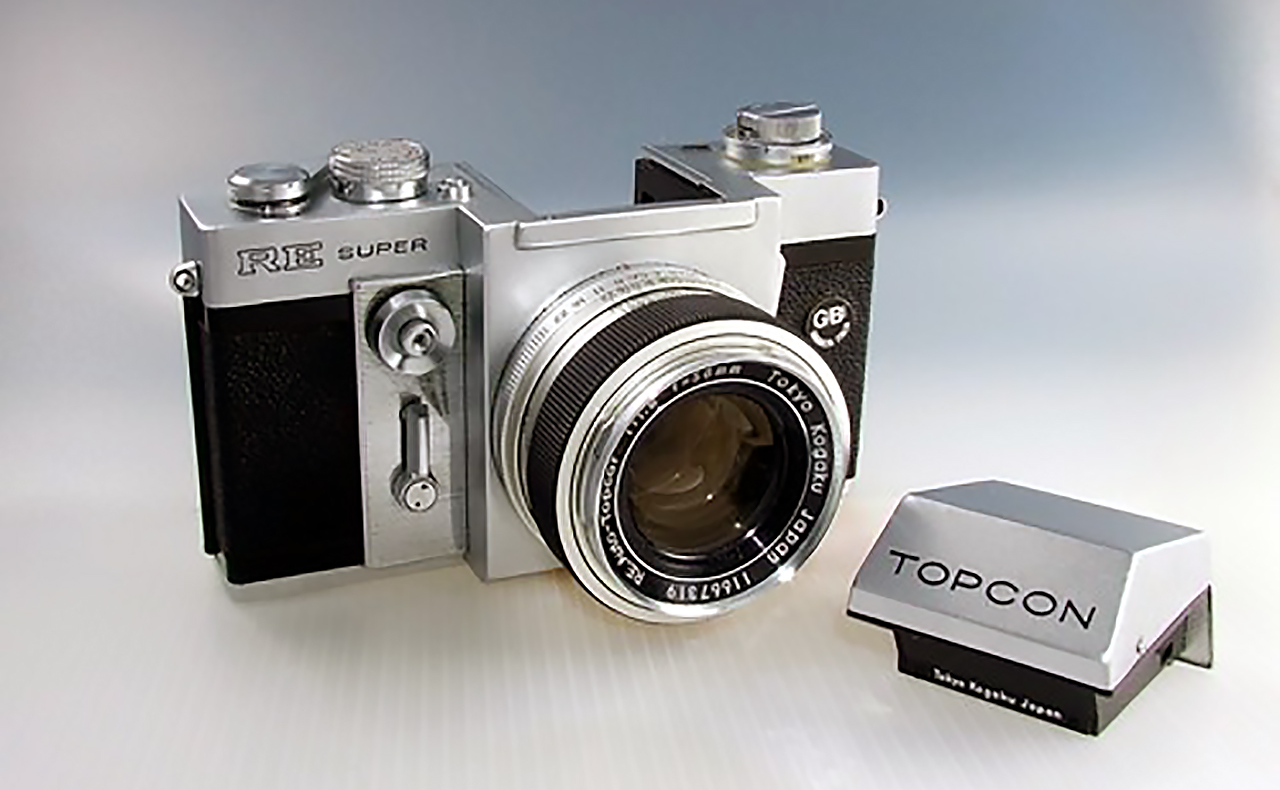
Topcon RE Super with interchangeable finders
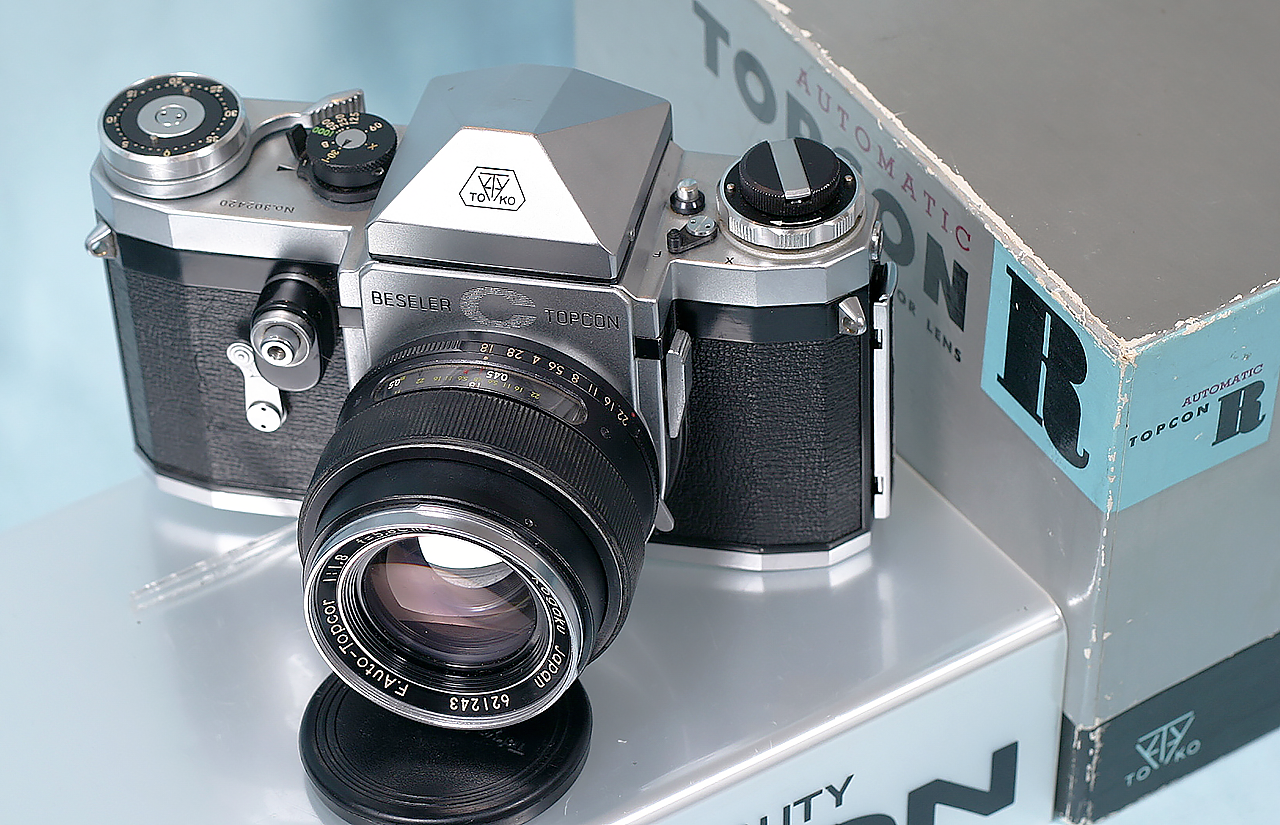
The Beseler C also known as the Topcon RII. c. 1960; Size 24 x 36mm on 135 film; original prize $ 295,- Production about 3.500/4.000 pcs;
International expansion in the seventies
 After the success of the Topcon R, the company continued building its camera technology, launching the Topcon RS in 1962, followed by the launch of the Topcon RE Super at the Photokina in 1963. Building on the success of the RIII Automatic, the RE Super received a redesigned body and an innovative behind the mirror exposure meter.
After the success of the Topcon R, the company continued building its camera technology, launching the Topcon RS in 1962, followed by the launch of the Topcon RE Super at the Photokina in 1963. Building on the success of the RIII Automatic, the RE Super received a redesigned body and an innovative behind the mirror exposure meter.
That model became the first in the world to feature the TTL full-aperture metering system, and it became a global success for the company.
By then, Tokyo Optical had become affiliated with Toshiba Corporation (still called Tokyo Shibaura Electric Co. at the time), which acquired nearly 41 percent of Topcon’s stock in 1960. Backing from Toshiba enabled the company to develop new measuring instruments and more sophisticated optics-based technologies.
By the end of the 1960s, demand for the company’s products forced it to expand its production capacity, and in 1969 the company opened a new factory in Fukushima. That subsidiary later became known as Optonexus Co.
The increased capacity, coupled with growing international demand, then encouraged the company to establish its first overseas offices. The company added a European presence in the Netherlands in 1970, which was shortly followed by a U.S. subsidiary, Topcon Instrument Corporation (later Topcon Medical Systems Inc.).
New subsidaries
In Japan, meanwhile, the group strengthened its operations through the creation of a number of subsidiaries, including a dedicated sales subsidiary for its surveying instruments, a new subsidiary for its developing medical instruments sales, and a subsidiary focusing on repairs. Also during the 1970s, the company launched the production of glass lenses.
Tokyo Kogaku would attempt to modernize the RE Super in 1977 with two newer models called the RE 200 and RE 300, but it was too little too late. Quality control became an issue, and their reputation as a slow to innovate company basically killed any attempt at a resurgence. Tokyo Kogaku would stop sales of new cameras in December 1980, but would continue to produce a few models rebadged under different names.
Today, most collectors are aware of the excellence of the RE Super and it’s variants, but not so much the earlier cameras. Perhaps not enough is written about the similarities between the R and RE Super as the only major difference (aside from cosmetics) is the lack of a meter. Both cameras share the same large body with great build quality and even more excellent lenses.

- Topcon America Corporation (United States);
- Topcon (Beijing) Opto-Electronics Corporation;
- Topcon (Great Britain) Ltd.;
- Topcon Deutschland GmbH (Germany);
- Topcon Espana S.A.; Topcon Europe B.V.;
- Topcon Europe Medical B.V. (Brussels);
- Topcon Europe Positioning B.V. (Brussels);
- Topcon Instruments (Malaysia) Sdn. Bhd.;
- Topcon Instruments (Thailand) Co., Ltd.;
- Topcon Korea Corporation;
- Topcon Medical Systems, Inc.;
- Topcon Optical (Dongguan) Technology Ltd. (China);
- Topcon Optical (H.K.) Ltd.;
- Topcon Positioning Systems, Inc. (United States);
- Topcon S.A. R.L. (France);
- Topcon Scandinavia AB (Sweden);
- Topcon South Asia Pte. Ltd. (Singapore).
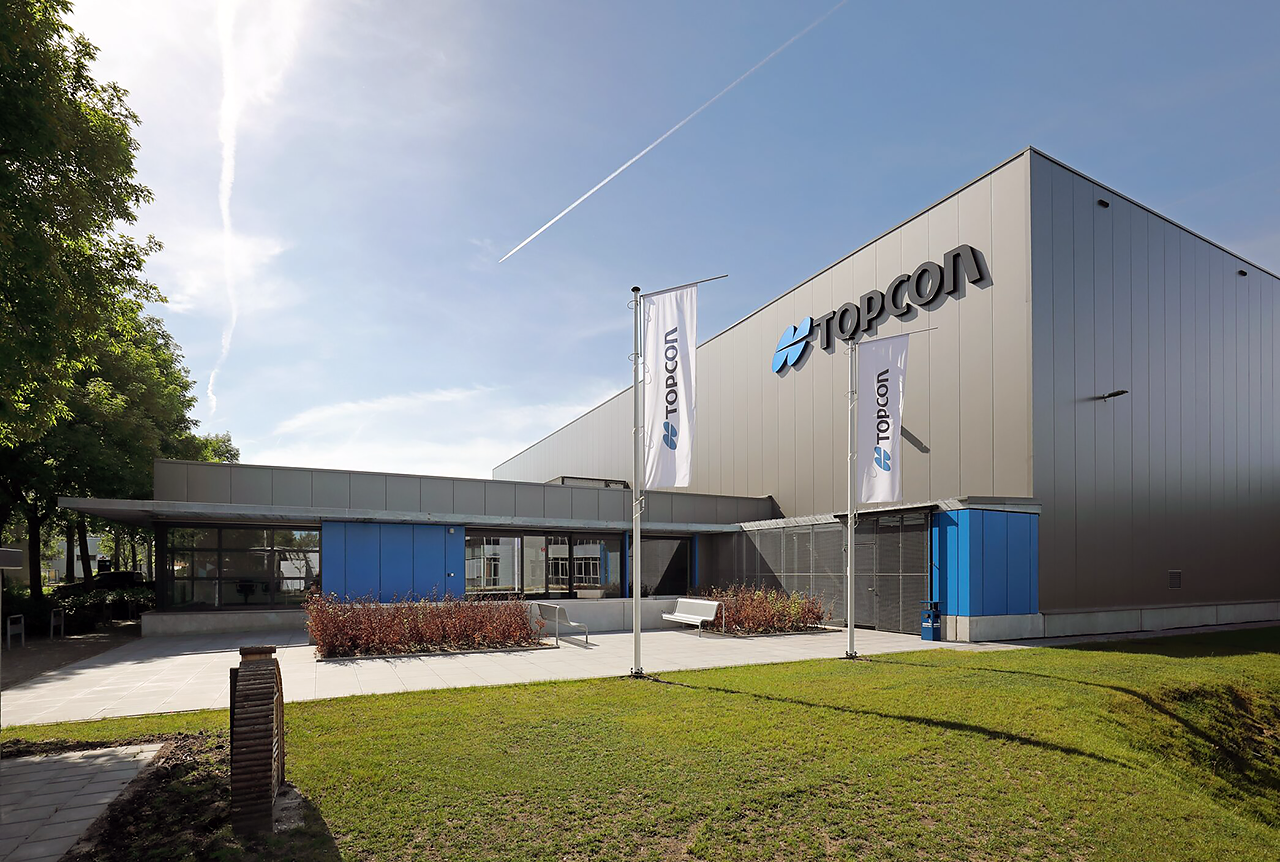
This is the new headquarters of Topcon Europe Positioning on the Werner von Siemensstraat in Zoetermeer
End of camera production
Tōkyō Kōgaku ended sales of 35mm cameras in December 1980, but production of the Horseman VH and VH-R 6×9 models continued, including the development of the Horseman ER-1 based on orders from Komamura. It thereafter concentrated on making specialist optical equipment of no direct relation to photography, and in 1989 took the name K.K. Topcon.
Today the better Topcon models are eagerly collected in Japan. In 2003 Cosina designed and marketed an “Auto-Topcor” 58/1.4 lens (in Nikon F and M42 mounts) that externally resembles the genuine Tōkyō Kōgaku item and is even marked Tokyo Kogaku; it also created a variant of its M42-mount Bessaflex SLR whose distinctive pentaprism housing resembles that of the Topcon RE Super.
TRADEMARKS
Topcoflex was registered as a trademark in the United States on 3 October 1953 by Tokyo Optical Company, Ltd, whose address at that time was 180 Hon-Hasunuma-Cho, Shimura Itabashi-ku, Tokyo, Japan. Later, 1 November, 1957, the same trademark was registered in Canada.
Topconette was registered in the United States on 21 December 1961. The company still listed the same address as on the 1953 filing at this time.
Unirex was registered as a trademark in the US on 2 March, 1970. Even at this late date, the registration continues to show the name Tokyo Optical Company, Ltd. and the same address as previous filing.
survey of Topcon cameras and lenses

35mm film SLR
Exakta lens mount
- Topcon R = Beseler B Topcon (1957-1960)
- Topcon RII = Beseler C Topcon (1960-1961)
- Topcon R III Automatic (1961-1963)
- Topcon RS (1963), rare variant of the RE Super with no meter
- Topcon RE Super = Beseler Topcon Super D (1963-1972)
- Topcon RE-2 = Beseler Topcon D-1 = Hanimex Topcon RE-2 (1965-1969)
- Topcon Super D = Beseler Topcon Super D (1971-1973)
- Topcon Super DM (1973-1976)
- Topcon RE 200 = Exakta EDX2 = Carena KS1 (1977-)
- Topcon RE 300 = Exakta EDX3 = Carena KS2
- Topcon T message register camera
All of these cameras take Exakta lenses.
35mm film SLR
Pentax K mount
- Topcon RM 300, the same body with minor modifications was sold under the names of Quantaray Delta 2-RZ, Carena KSM1, Exakta KE4 and Exakta KE5
- Topcon AM-1, never sold, released in 1983 by Cima as Cimko LS-1 and, in the US, as the Lindenblatt KL-2[13] (sold by Cambridge Camera Exchange, Inc, whose chairman was George Lindenblatt).
All of these cameras take Pentax K lenses.
35mm film SLR
Topcon UV lens mount
- Topcon Wink Mirror S (1963-1964)
- Topcon Uni = Beseler Topcon Auto 100 = Hanimex Topcon RE Auto (1964-1969)
- Topcon Unirex = Beseler Topcon Unirex (1969-1973)
- Topcon Unirex EE (1972-1974)
- Topcon IC-1 Auto (1974-1976)
- Topcon New IC-1 Auto (1976-1978)
The cameras with UV lens mount are a unique series which comprises both leaf shutter and focal plane shutter SLR bodies. All of these take Topcon UV lenses.
Subminiature
The Mascot subminiature was produced by Shimura on behalf of Tōkyō Kōgaku.
35mm film CAMERA
Fixed lens
- Topcon PR (1959-1960)
- Topcon PR II = DeJur Dekon-SR (1960)
- Topcon Wink Mirror (1960-1961)
- Topcon Wink Mirror E = Beseler Topconette (1961-1963)
All of these cameras had front element optical complements available.
35mm film
Viewfinder CAMERA
- Minion 35A (24×32)
- Minion 35B (24×32)
- Minion 35C (24×36)
- Topcon 35A
- Topcon 135EE (rebranded Haking Autoflash 35)
35mm film
RANGEfinder CAMERA
- Topcon 35B
- Topcon 35-S
- Topcon 35-L
- Topcon-JL
120 film 6×6 TLR
- Topcoflex
- Primoflex
- Sunflex IV
120 film 4.5×6 telescopic
- Lord
127 film 4×4 TLR
- Primo Jr
- Primo Jr with exposure meter
- Sawyer’s Mark IV, name variant of the Primo Jr
127 film 4×5 folding
- Minion
Press camera
- Topcon Horseman Press
Lenses
Interchangeable
- Seagull FCL810-A
- Seagull HZX45-IIA
- Seagull HZX57-IIAT
- Seagull 202
- Seagull 203 (6×6 + 4.5×6 rangefinder)
- Seagull 203-I (6×6 + 4.5×6 rangefinder)
- Seagull 203-H (6×6 + 4.5×6 rangefinder)
Lenses
MISCELLANEOUS
Barrel lenses:
- Simlar 18cm f/4.5
- Simlar 21cm f/4.5 (c.1937)
Regular military lenses:
- Simlar 7.5cm f/3.5 (c.1940) used in the Army Type 99 Ultra Small Aerial Camera (GSK-99)
- Simlar 180mm f/4.5 (c.1940) for the SK-100 aerial camera
- Simlar 300/4.5
- Tele-Simlar 40cm f/5, for aerial cameras
Wide aperture lenses, for military or other use:
- Simlar 50/0.7 (c.1941–4)
- Simlar 5cm f/0.7 (c.1951)
- Simlar 50mm f/1.5 (c.1940)
- Simlar 13cm f/1 (c.1940) used in the Japanese night camera
- Simlar-F 180mm f/1.5 (c.1942)
Enlarging lenses:
- Topcor 50/3.5 (sold at ¥4,500 in 1955)
- Toko 7.5cm f/4.5
- Toko 7.5cm f/3.5 (sold at ¥3,500 in 1955),[16] at least two variations
- Simlar 75/3.5
Military Kaitenkei spy camera
- Army Type 99 Ultra Small Aerial Camera (GSK-99) (part of the production)
OTHER PRODUCTS
- Minion enlarger
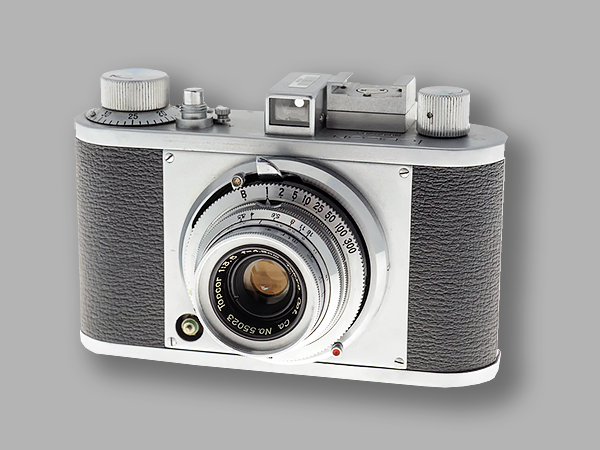
The Topcon 35A and Topcon 35B are 35mm cameras with an interchangeable lens, made between 1953 and 1956 and successors of the Minion 35 series.The Topcon 35 has a rounded body, shaped like the Minion 35 but higher. The back is removable together with the bottom plate for film loading.
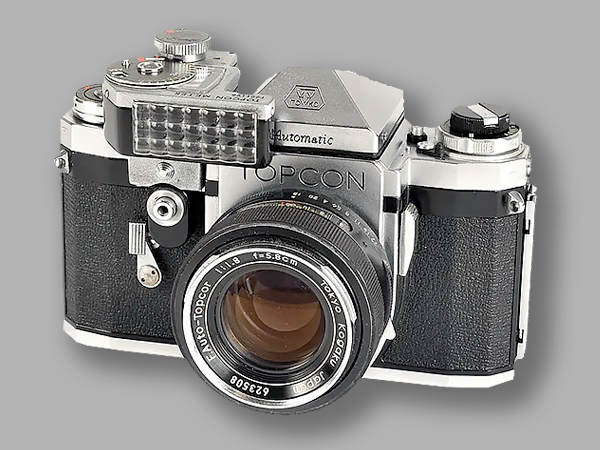
The Topcon RIII adds a small revision to the Topcon RII. Here Tōkyō Kōgaku has combined all shutter speeds onto a single dial with even spacing; and added an accessory port for a clip-on selenium meter coupled to this dial. Sources may refer to this Topcon RIII as the Topcon R3 automatic.
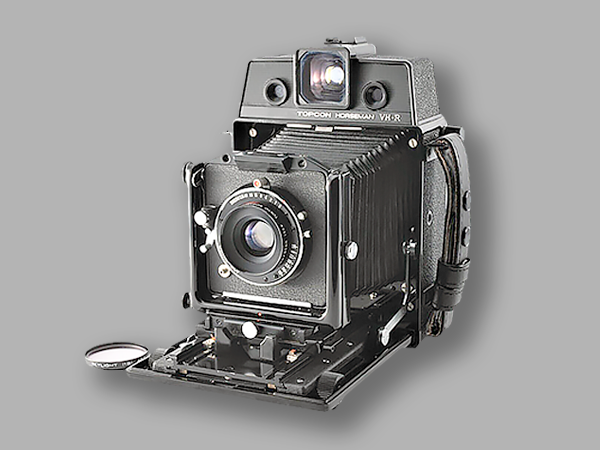
The Topcon Horseman Press is a 4x5inch press camera with big rangefinder. The Horseman represents a series of 2-1/4″ x 3-1/4″ format technical cameras dating to 1960. The 960 was introduced in 1960, the 970 in 1963, followed by the 980, 986, and VH and VHR (rangefinder) models.
FOUNDERS: Nagatsuka Masanori, Tanaka Kōichi and Toyota Yoshio
COMPANY NAMES:
1930: Tōgōdō; 1935: Tōgōdō Shashin Kōgyō-sha; 1945: dissolving of the Tougodo company;
1946: Toyohashi restart; 1949: Tōgōdō Seisakusho; 1952: Tōgōdō Sangyō Y.K.; 1957: Tōgōdō Kōki K.K.; 19??: Daishin Seiki; 1965: stopped making cameras.
1946: Yamanashi restart; 1953: K.K. Tōgōdō; 1954: also had an associated sales company called Tōgōdō Shōji K.K.; 1955: camera production failed; 1971: New company Meikai Sangyō.
COMPANY ADDRESSES:
1930: Omote-Jinbōchō, in the ward of Kanda, Tokyo; 1935-1940: Tachō 2–9, Kanda, Tokyo; 1942: a plant in Toyohashi in the Aichi Prefecture and a plant in the Yamanashi Prefecture.
1946: Toyohashi restart; 1949: Chiyoda-ku Kanda Tsukasamachi 1–9; 1952: Komoguchi, Toyohashi.
Tougodo was a Japanese camera maker, active from 1930 to the Second World War, and was revived as two companies after the War. The better known of these (Yamanashi) remained active until the early 1960s.
SUMMARY
The Tougodo company was founded in 1930, in Japan, and functioned fully until 1945, when the main factory was destroyed in the February 1944 air strikes. Two of the company’s other manufacturing sites survived, and began to produce cameras at a later date.
The first, Toyohashi, began production in 1947 and its offerings included the HIT, Hobix, Hobiflex and Toyoca cameras. Yamanashi, the other site, produced the Mekai, Muse, and Semi Rabbit cameras from the later 1940s onward.
Toyohashi ceased its camera manufacturing in 1960, while Yamanashi evolved first into the Meikōsha company, and then into Meikai Sangyō, and produced a number of cameras, including Meisupii and Meikai EL. Until the 1980s traces of this company could still be found.
Pre-war period
Nagatsuka Masanori, Tanaka Kōichi and Toyota Yoshio, three brothers-in-law, founded the company in 1930. The headquarters and factory were in Omote-Jinbōchō, in the ward of Kanda, Tokyo.
 Nagatsuka was born in the city of Kagoshima, and named the Tougodo Company, Tōgōdō, meaning “Tōgō firm” and the Tougo (Tōgō) cameras after Admiral Tōgō Heihachirō, who defeated the Russian fleet at the battle of Tsushima in 1905 and was born in Kagoshima too.
Nagatsuka was born in the city of Kagoshima, and named the Tougodo Company, Tōgōdō, meaning “Tōgō firm” and the Tougo (Tōgō) cameras after Admiral Tōgō Heihachirō, who defeated the Russian fleet at the battle of Tsushima in 1905 and was born in Kagoshima too.
The cameras used the no-need-darkroom process, an idea that was bought by Nagatsuka to an unknown individual. The It camera released by Murakami is the first camera known to use this process, and advertisements for it mention a patent; there is a possibility that Nagatsuka actually bought that patent.
Camera distributors were approached, but refused to sell the Tougo cameras, which was considered as mere toys, so the company bought various shops in the country to run direct sales. The company also used toy, clock or radio shops as authorized dealers as well.
The Navy soon asked the company to drop using Tōgō’s name. Nagatsuka felt that a name change would be dramatic for the sales, and went with others of the company officials to visit the admiral at his own home, asking him the permission directly. Tōgō granted his permission, and his secretary Ogasawara Naganari, himself another admiral of the Navy, wrote a license and even a “Tougodo” signboard for the company.
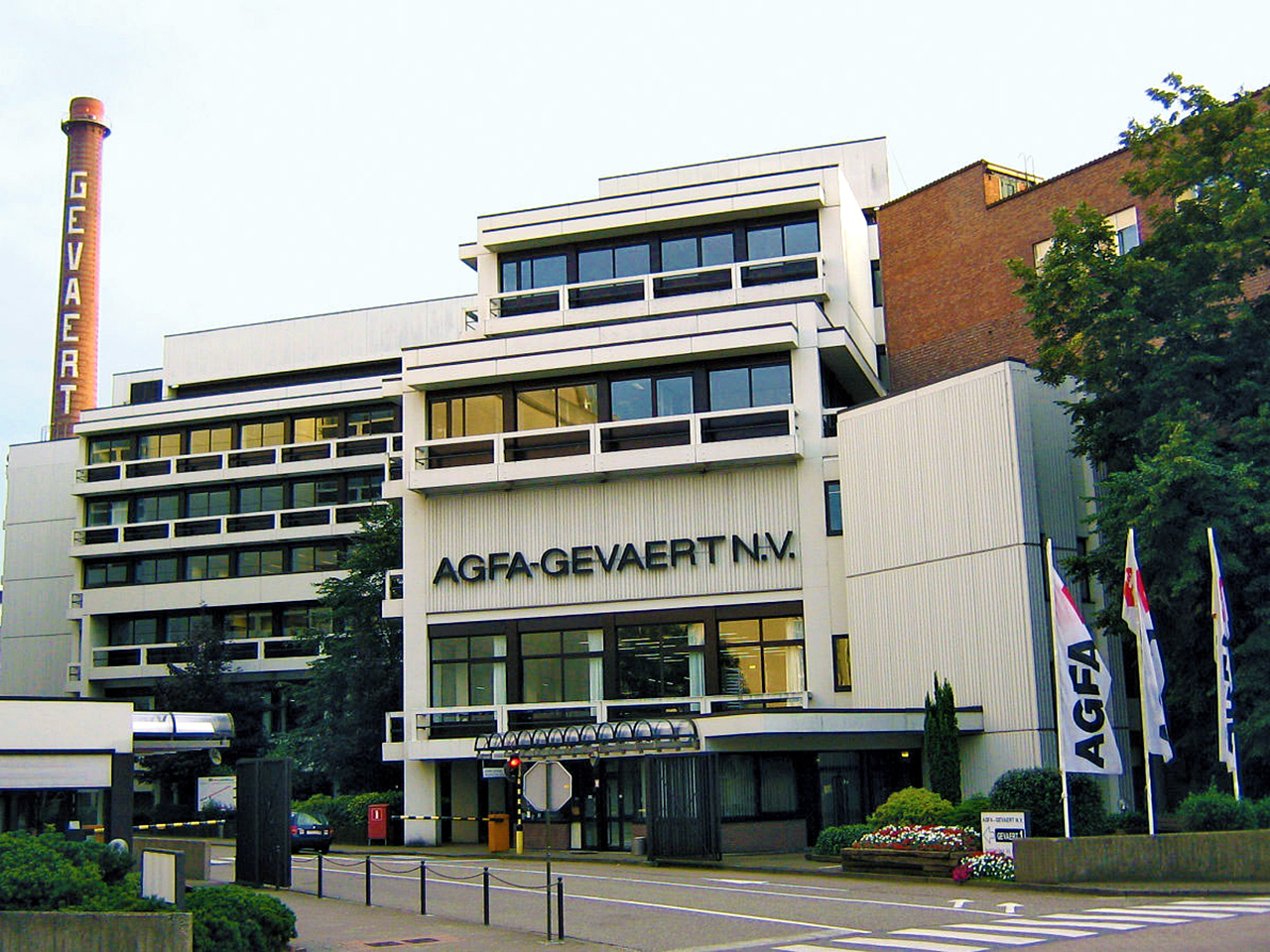
The Manufacturing Facility Agfa-Gevaert NV in Mortsel Belgium took care of the supply of the required film.
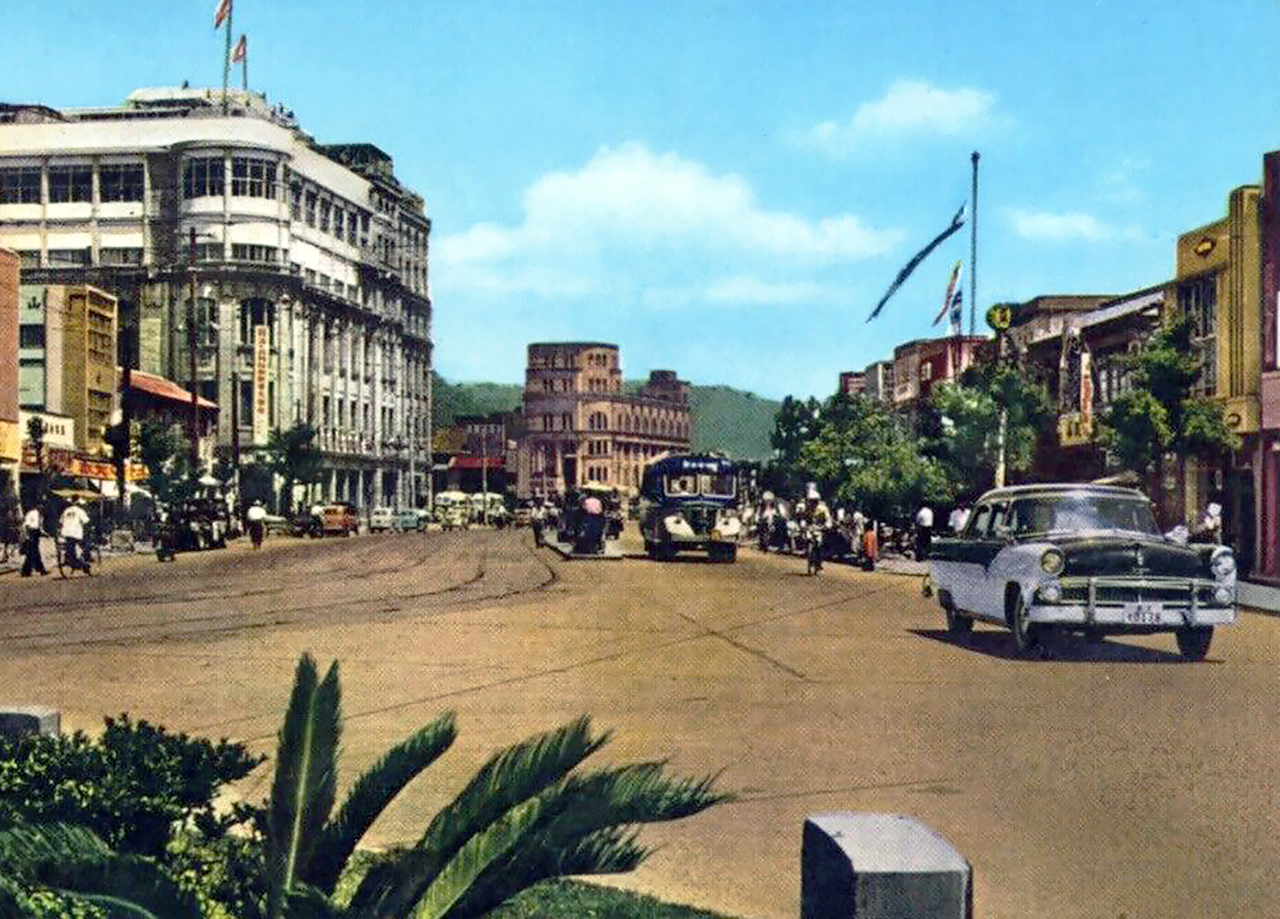
Old Postcard of the center of Kagoshima City, Japan.
Film supply
The supply of film was another problem: the company first wanted to get film from Konishiroku but this did not come out for some reason, perhaps for the same reasons that deterred the camera distributors from handling the camera.
Film was imported from Gevaert in Belgium, then Fuji cine film was used after imports became difficult because of the international situation. This cine film was cut and mounted in paper sheaths in the Kanda factory, and it seems that the chemicals were produced there too.
Tanaka Kōichi said in the 1950s that back in the 1930s the cine film supplied by Fuji was of poor quality, and could hardly be enlarged.
From the mid-1930s to the early 1940s, the company was called Tōgōdō Shashin Kōgyō-sha or Tōgōdō Shashin Kōgyō K.K. Its address was Tachō 2–9, still in Kanda. In 1933, it launched a monthly magazine titled Shumi or Camera Shumi (Camera), that would be published for more than six years.
In 1935, the company released the Meiko series of folding cameras using the Meiko film pack, containing various sheets of no-need-darkroom film. From c.1937, the Meiko range was gradually replaced by the Meisupi and Meiritto using 2.8×4cm C-size sheet film, certainly cut from Fuji’s cine film.
The more expensive Meisupi models had a novel side-by-side TLR configuration. The Meikai viewfinder and side-by-side TLR models were released a few years later; they allowed to take both C-size sheet film and a special type of paper backed rollfilm.
During the war, the company was requested to produce war material, such as parts for aircraft transmission devices. At some time, part of the production was evacuated to two dispersal plants, one in Toyohashi, in Aichi Prefecture, ruled by Tanaka Kōichi, and the other in the Yamanashi Prefecture, ruled by Toyota Yoshio. Nagatsuka Masanori stayed in the Kanda factory, which was completely destroyed by an air raid in February 1944. The three brothers-in-law joined in 1945 and decided to dissolve the Tougodo company. Nagatsuka altogether abandoned camera production, and was ruling a framework shop in Ginza in 1955; whereas his two brothers-in-law perseverated.
At some time after 1945, the younger brother Toyota Yoshio restarted camera manufacture in the former dispersal plant he was ruling in the Yamanashi prefecture. This other Tōgōdō camera maker was called K.K. Tōgōdō in 1953–4. Advertisements known so far sometimes mention that the plant was in the Prefecture of Yamanashi, without giving its precise location.
This company revived the Meikai brand name for the Meikaiflex pseudo TLR, and made the Muse Flex TLR and Shinkoh Rabbit or Semi Rabbit folder, distributed by Shinkō Shōji. It also had an associated sales company called Tōgōdō Shōji K.K. in 1954, whose address was Chiyoda-ku Kanda Sakuma-chō 3–21 in Tokyo, and which also advertised the Muse Flex. These attempts at camera production had failed by June 1955, but Toyota was working on settling his business again.
Toyota’s attempts were successful, and a newer Yamanashi company emerged, perhaps called Meikōsha. It again revived brand names used by the former Tougodo company in the late 1930s, and notably made a series of cameras called Meisupii. It is said that the company became Meikai Sangyō in 1971 and was still producing the Meikai EL camera in the 1980s.

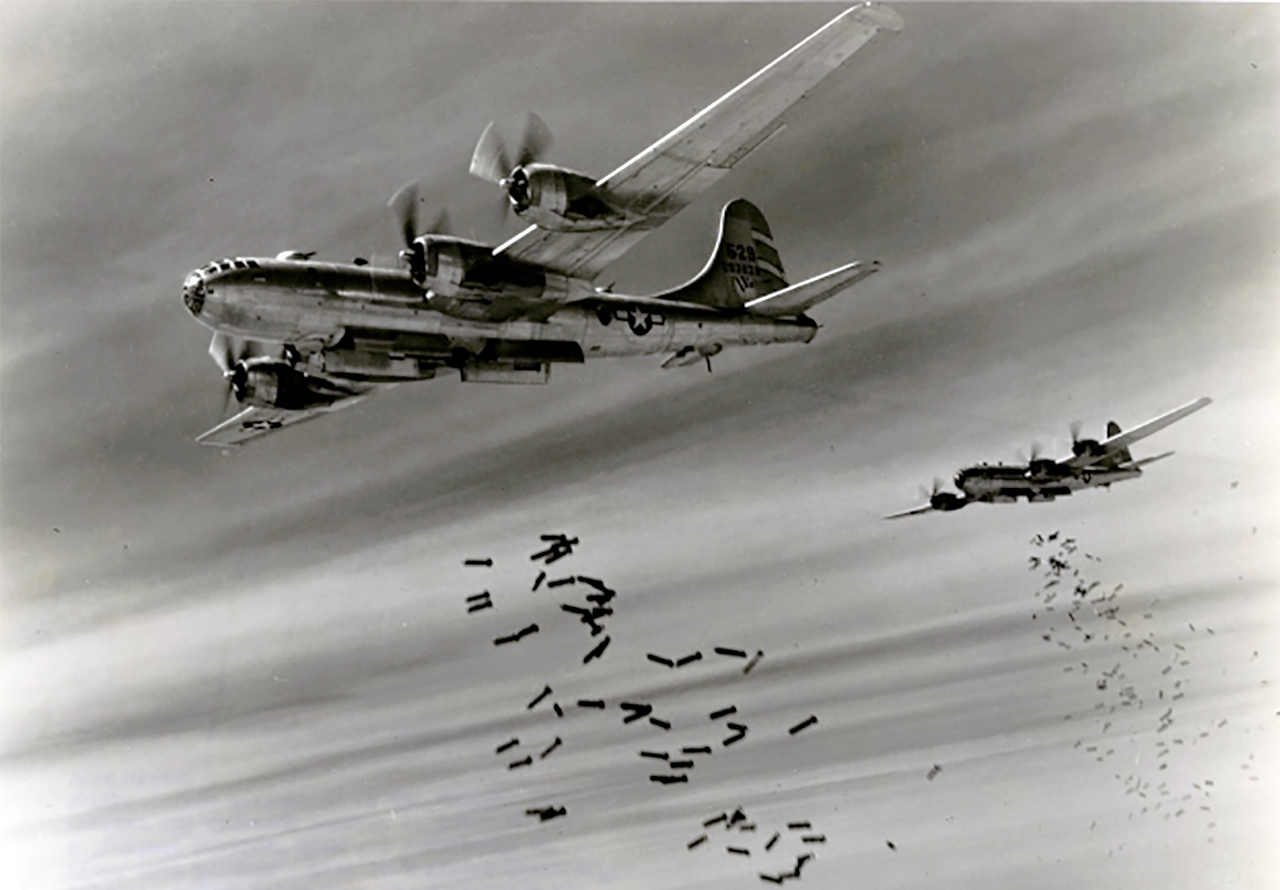
B-29’s dropping conventional bombs over Japan. Note that the bombs are being scattered by the wind, a common occurrence which made precision bombing difficult.
Two different Tougodo companies were revived after the war, from the two dispersal plants; the best-known company is that in Toyohashi.
The factory ruled by Tanaka Kōichi managed to survive, making lighters or cigarette cases. Around 1947, Tanaka decided to start camera production again; he wanted to use the same methods of direct sales again, but faced a number of problems.
He could not find enough suitable buildings to setup shops, he was not allowed by the occupant to organize public demonstrations in the streets, and huge inflation made labour and advertisement costs prohibitive. He thus decided to operate as an ordinary camera maker, selling the products through distributors, both inside the country and for export.
The Hit sub-miniature camera was a big success, notably on export markets, and the Hobix-camera using Bolta film followed soon in 1948.
In 1949, the company was called Tōgōdō Seisakusho, and was using an address in Tokyo: Chiyoda-ku Kanda Tsukasamachi 1–9, perhaps some office building only. Around that time, the company was using a logo made of the letters “T” and “G” (the “G” is inside a fat “T”) above the schema of a cemented doublet lens.
The company name was Tōgōdō Sangyō Y.K. in 1952–5, sometimes given as Y.K. Tōgōdō or simply Tōgōdō, and sometimes preceded by the city name Toyohashi. The address was in Komoguchi, in the city of Toyohashi. The name had become Tōgōdō Kōki K.K. in mid-1957.
The Toyohashi Tōgōdō company mainly used the brands Hit, Hobix, Hobiflex and Toyoca for the Japanese market. (Toyoca is certainly the contraction of Toyohashi Camera.) Many of the Tougodo products were also sold under various names for export, and the Toyocaflex 6×6 TLRs is notably known for its seemingly endless list of name variants.
The Toyohashi-based company became Daishin Seiki at some time. It floundered as the demand for Hit-type novelty cameras decreased sharply and other Japanese camera manufacturers were overtaking the company as they came out with newer and more innovative models. Camera production ceased in the 1960s and the company itself seems to have gone under sometime after the 1980s as a subcontractor for Pioneer Corporation.
comprehensive Camera & Film list
120 film
- Semi Hobix (4.5×6 telescopic)
- Hobiflex (6×6 TLR)
- Haco-LM (6×6 TLR, built-in selenium meter)
- Toyocaflex (6×6 TLR) and its numerous name variants made for various distributors
- Accuraflex
- Crownflex
- Daflex
- Deitzflex
- Europaflex
- Hacoflex
- Hilkaflex
- Kinoflex
- Lionflex
- Metarflex
- Metascoflex
- Miloflex
- Mirroflex
- Novelties
- Prince Junior (late version with capital letters)
- Proskar
- Rippaflex
- Skyflex
- Starflex (postwar)
- Trioflex
- Zenoflex
127 film
- Stereo Hit (3×4 stereo)
- Toyoca-44, Haco-44, Kino-44, Laqon-44, Tower 44 (4×4 TLR)

35mm film folding
- Toyoca B35, viewfinder only
- Chest 35, name variant of the latter, distributed by Super Shashin-yōhin
- Pigeon 35 V, rangefinder version of the Toyoca B35, distributed by Endō Shashin-yōhin
- Pigeon 35 5B, as the latter with a bright-frame finder, distributed by Endō Shashin-yōhin
35mm film stereo
- Stereo Leader and Windsor Stereo
35mm film TLR
- Toyoca 35, Haco 35 and Hulda 35
35mm film viewfinder
- Meica 35
- Meika 35
- Meikai HC35
- Meikai C35C
- Meikai EL, Meikai ELX, Meikai EL 204, Meikai EL 304
- Meikai FC
- Meikai GT
- Meikai SL
- Meikai ST
- Meisupii HALF
- Power EL
- Strato 35
- Toyoca 35-S
- Toyoca 35-SA
17.5mm film
- Hit and many name variants, including a Toyoca
- Baby-Max and name variants
- Colly
- Toyoca Ace
- Hit-II
- Toyoca 16, Kute and Saga 16
- Sweet 16
No-need-darkroom
Tougodo box-shaped cameras
- Tougo A, Tougo No.1, Mikasa-Go (box, 3.5×5.5cm)
- Tougo B, Tougo No.2, Speed-Go, Hit-Go (box, 3.5×5.5cm)
- Tougo C, Tougo No.3, Light-Go (TLR, 3.5×5.5cm)
- B Light-Go (TLR, 3.5×5.5cm)
- Pocket-Go (box, 24×38mm)
- Speed-Go Reflex (SLR, 28×40mm)
Tougodo folding cameras
- Nice-Go (3.5×5.5cm)
- Yuuhi-Go (3.5×5.5cm)
- Lead-Go (5×7cm)
- Hero-Go (5×7cm)
- Meiko A (3.5×5.5cm)
- Meiko B (3.5×5.5cm)
- Meiko C, E, F, K (5×7cm)
- Meiko No.1 (3.5×5.5cm)
- Meiritto (viewfinder)
- Meisupi (viewfinder)
- Meisupi (side-by-side TLR)
Special rollfilm
- Meisupi (viewfinder)
- Meikai Special (viewfinder)
- Meikai and Meikai Ref (side-by-side TLR)
Bolta (35mm unperforated rollfilm)
- Meisupii 1a
OTHER PRODUCTS
Tougodo enlargers (incomplete list)
- P-Go (c.1934), for meishi prints
- superior (c.1934), for tefuda prints
- 3-stage special (c.1934), for meishi, tefuda or kyabine prints
a few examples of TOUGODO cameras
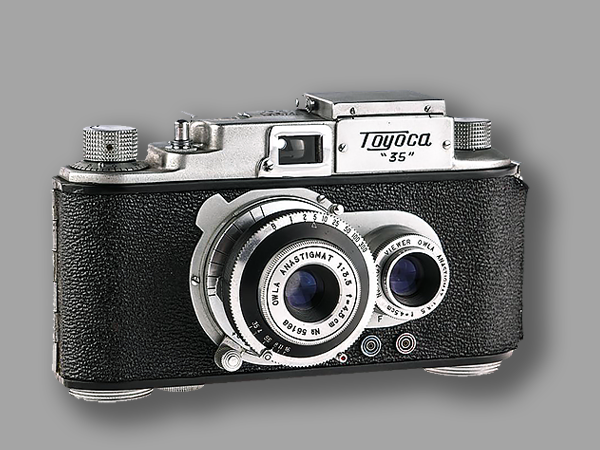
The very rare Toyoca 35 TLR, sometimes called “Toyocaflex 35”, is a Japanese 35mm side-by-side TLR made by Tougodo from 1955 to 1957. The Haco 35 and Hulda 35 are name variants. The Toyoca 35 TLR is shaped as a conventional 35mm camera with a mirror box and viewing lens grafted on one side of the taking lens.The total production can be estimated at about 2,500 units.
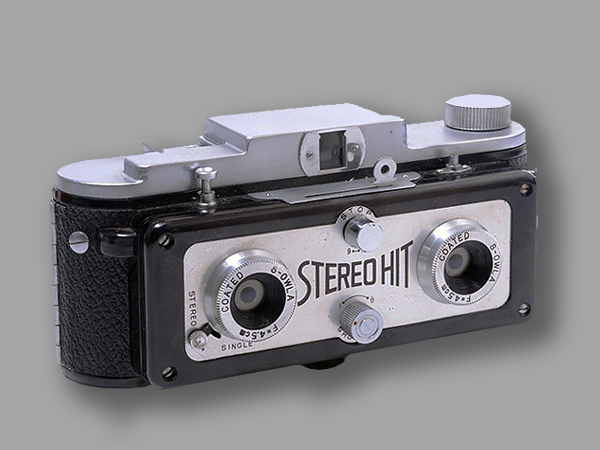
The Stereo Hit is a Japanese camera taking pairs of 3×4cm exposures on 127 film, made by Tougodo from 1955. It has a body made of plastic, looking very similar to contemporary models using 35mm film. The top housing covers the whole length of the body. It shows no engraving, contains the viewfinder in the middle and has an accessory shoe on the right.
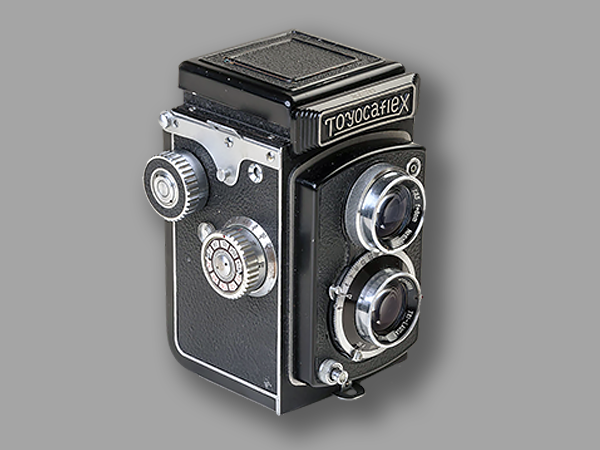
The Toyocaflex is a 6×6 TLR camera produced by Tougodo from early 1955. It is based on the Rolleicord and so is very similar to other Rolleicord copies, like the Yashica-D.
So similar in fact, that many Japanese TLRs, such as the Starflex and Skyflex are considered to be rebadged versions of the Toyocaflex.
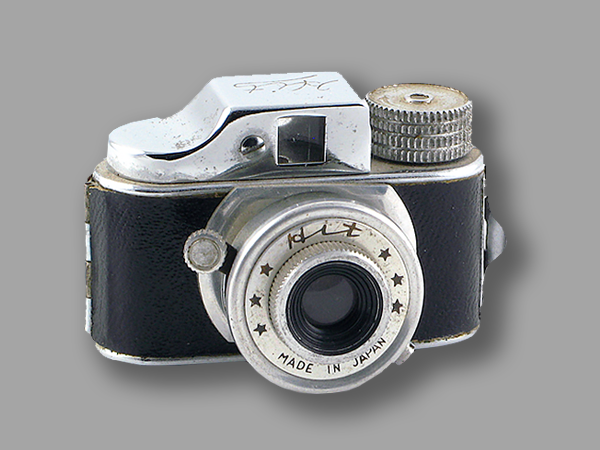
The Hit Camera was manufactured in circa 1946. A gold tone metal version was available in the 1950s. The camera was made with a silver metal face-plate with the name HIT imprinted in black on the top, with three stars on each side and “MADE IN JAPAN” printed on the bottom. The camera took 14×14mm exposures on narrow paper-backed 17.5mm film.
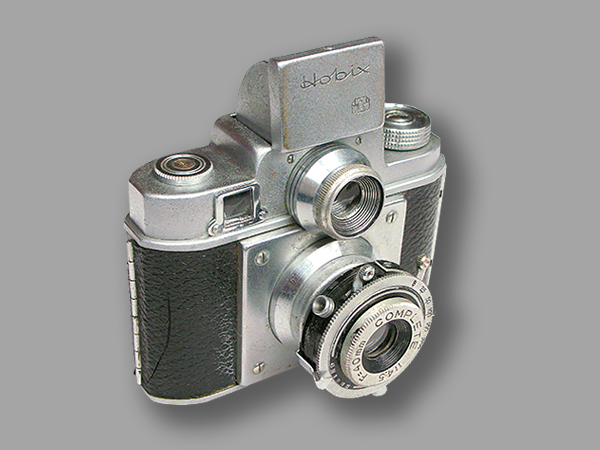
The Hobix is a series of fixed-focus cameras using Bolta film, made by Tougodo in the 1950s. Shown is a Hobix S III Camera; c. 1954. It takes size 30×30 mm images on special Bolta size –film. viewfinder camera. Eye-level and reflex finders. f4.5 lens.This is the last model in the Hobix series.
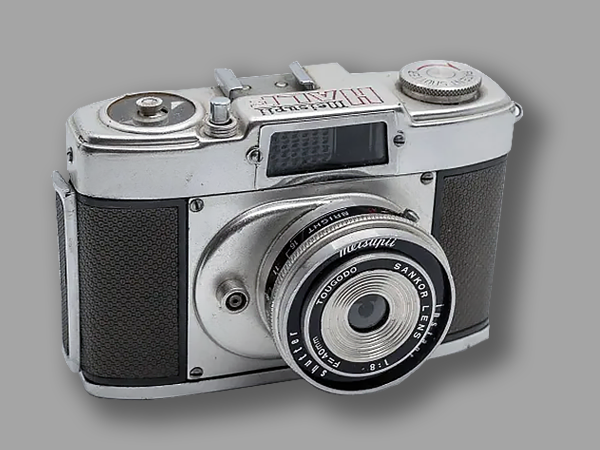
The Mei-Half is a cheap 35mm half-frame camera, manufactured by Tougodo around 1962. It has a fixed-focus single-element 40mm f/8 lens, and just one timed shutter speed, marked ‘I’ for ‘instantaneous’, although it also has a ‘B’ setting. The part next to the viewfinder that looks like a selenium light-meter, is just for decoration.
FOUNDER: Unknown
COMPANY NAMES:
1962: Traid Corporation; 1972: went out of business.
COMPANY ADDRESS:
1962: Glendale, California, USA.
The Traid Corporation might be the company which gave birth to the Fotron, the worst camera ever made. The Fotron was sold primarily by door to door salesmen and through back of magazine ads, using questionable sales tactics at prices from $150 upwards, way beyond what the camera was worth. The true value was closer to $40.
 The Fotron was a camera produced by the Traid Corporation of Glendale, California between 1962 and 1971 and mainly sold door to door. It had a highly unorthodox design and boasted several firsts for a consumer camera, including a built-in electronic flash, built-in motor drive, and drop-in film loading (beating Kodak’s popular Instamatic to the market).
The Fotron was a camera produced by the Traid Corporation of Glendale, California between 1962 and 1971 and mainly sold door to door. It had a highly unorthodox design and boasted several firsts for a consumer camera, including a built-in electronic flash, built-in motor drive, and drop-in film loading (beating Kodak’s popular Instamatic to the market).
Other unusual features included push-button exposure and focus controls and an integrated rechargeable battery. The camera used 828 film which was a standard film format at the time, but instead of using the standard packaging of this film on rolls, it loaded the film into proprietary cartridges which had to be returned to the Traid Corporation for processing and reloading. Each cartridge held only ten 1×1-inch frames. It was aimed mainly at women, marketed as a “goof-proof” alternative to traditional cameras.
Although innovative, the Fotron was also extremely expensive, unwieldy, and reportedly suffered from poor optical quality. Introduced at a list price of $139.95, by 1971 the camera was selling for $520 (equivalent to $3,758 in 2022), plus $3.98 per 10-exposure roll for film and processing (equivalent to $29 in 2022). Despite this, Traid claimed the cameras were sold at a loss and only the film processing operation was able to turn a profit.
Due to the high price, vendor lock-in of film and processing, and aggressive direct selling techniques used to market the camera, it is often regarded as something of a scam. Traid faced multiple class-action lawsuits brought by Fotron customers and stopped selling the camera in 1971.
Models
The Fotron was a large and heavy plastic camera, similar in size to a folded Polaroid Land Camera of the same era. Much of the bulk came from the built-in flash unit and rechargeable battery.
Exposure was set by pushing one of two buttons, marked “indoors” and “outdoors” respectively. This also served to turn on the flash circuitry in preparation for taking a picture.
The exposure would then be made by choosing from a second set of buttons, labelled with various camera-to-subject distances. This would set the focus accordingly and then trip the shutter and the flash, which fired with every exposure. The film would then be automatically advanced to the next frame.
The camera batteries had to be charged for 18 hours to shoot just one 10-exposure cartridge, and 72 hours for more than one!
Traid produced three Fotron models, all of which were essentially the same. The original model was simply marked “Fotron” and had a grey plastic housing.
The second model, introduced around 1965, had a black housing and a different style of frame counter. The final model was the Fotron III, which was introduced around 1966. It was also black and had a slightly simplified design with two focus buttons instead of three and a different exterior treatment for the flash unit.
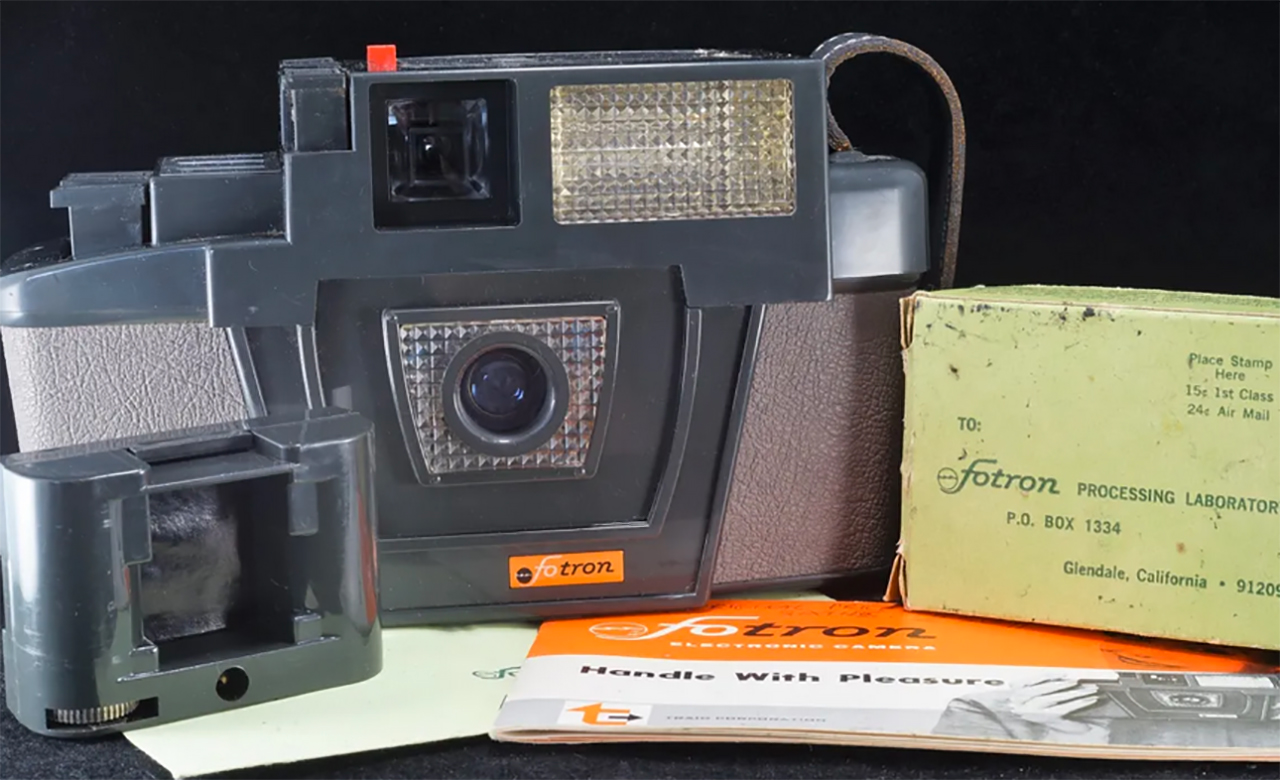
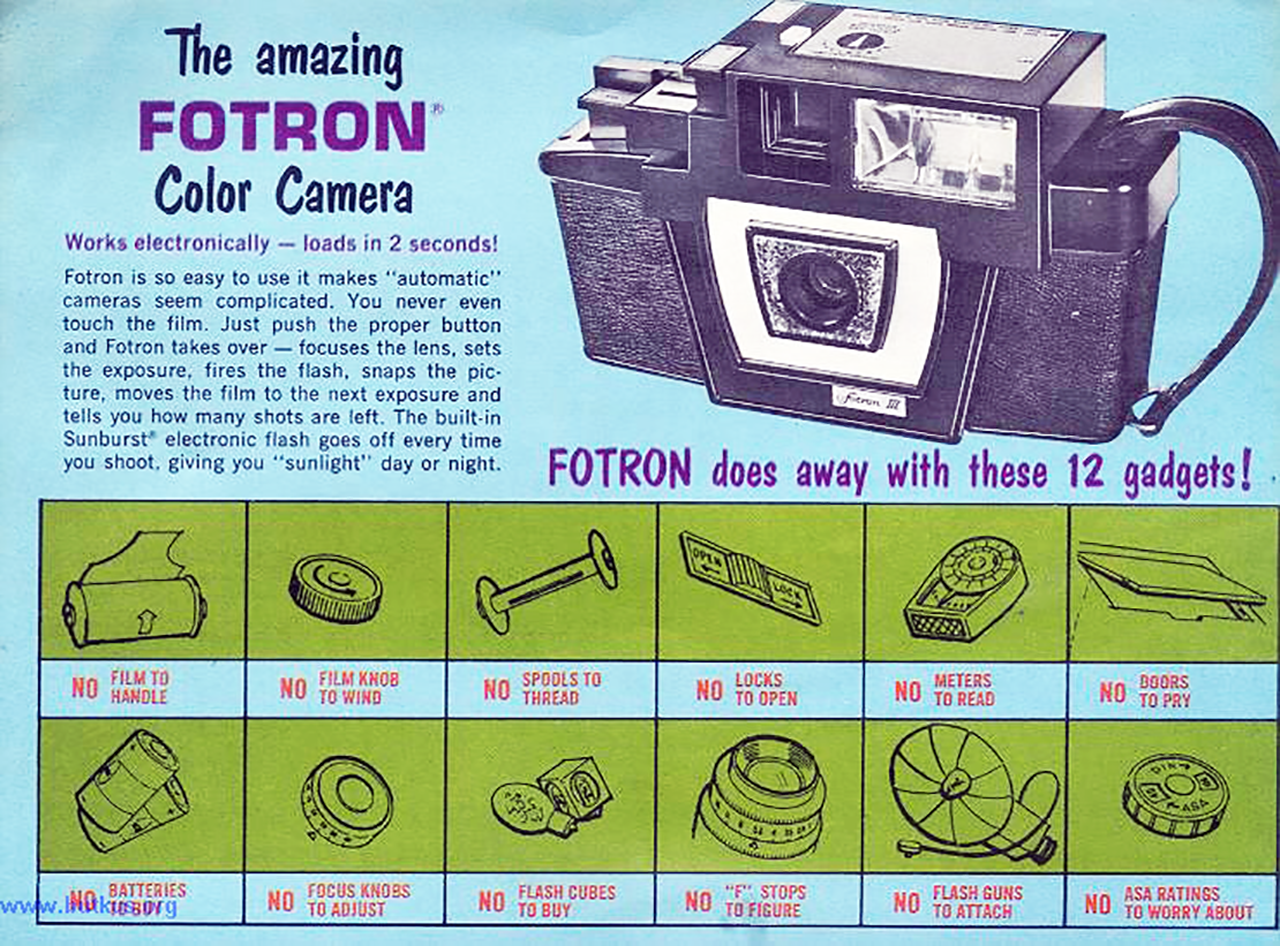
An example of one of the many Fotron ads.
Fraud allegations
The Fotron camera is in nearly every way a monstrosity — an enormous plastic brick that could just as effectively be used to club muggers over the head or to break a window in case of an emergency. Counting in its favour, however, are the pioneering built-in flash, an electric exposure counter, motorized film advancement, and a rather cute system of buttons for selecting the exposure and focus.
The Traid Corporation was the subject of a class action lawsuit in 1972 and went out of business shortly thereafter. The plaintiffs alleged that the Fotron cameras they had purchased was a heap of junk that took crappy photos, but also that they’d been sold for $491.60 a camera that was actually only worth about $40. Furthermore, that Traid had misrepresented the product both implicitly and in writing. The outcome of this case is uncertain.
FOUNDING DATE: 1936
FOUNDER: Daniel Dan Prenn
COMPANY NAMES:
1936: Truvox Engineering Ltd.
COMPANY ADDRESSES:
1936: Exhibition Grounds, Wembley, Middlesex.
The strange story how a top ten tennis player, with the help of a plastic camera (the Wembley), through various types of sound equipment, eventually developed into a leading producer of “floorcare” products.
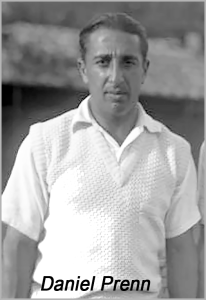 Truvox established as private company founded by Daniel Dan Prenn. Prenn was a Jewish Russian-born German, Polish, and British tennis player. He was ranked the World No. 6 for 1932 by A. Wallis Myers, and the European No. 1 by “American Lawn Tennis” magazine. He was a runner-up for the mixed doubles title of Wimbledon in 1930.
Truvox established as private company founded by Daniel Dan Prenn. Prenn was a Jewish Russian-born German, Polish, and British tennis player. He was ranked the World No. 6 for 1932 by A. Wallis Myers, and the European No. 1 by “American Lawn Tennis” magazine. He was a runner-up for the mixed doubles title of Wimbledon in 1930.
When the Nazis came to power in Germany in 1933, they barred him from playing because he was Jewish. He emigrated from Germany to England, and became a successful businessman.
Truvox pioneered plastic extrusions during WW2 and through the 1950s, with items such as gramophone pick-ups and loudspeaker housings, electrical appliances as well as this brief venture into simple moulded cameras, which from 1950 to 1956 included the Bakelite Wembley Sports Camera. It was named after Truvox’s address at Wembley, London.
The Wembley Sports was launched at the British Industries Fair in 1950 and takes eight 6x9cm images on 120 film. It sold at an introductory price of £4 17s and 6d.
The Wembley Sports Camera
The Wembley Sports Camera was very similar to the Arti-Six and French Labelled Grand Manitou which were produced by Truvox for Artima Export Ltd. The two cameras have different lens apertures, but little else is different, apart from the embossed names and the Wembley Sports lacking a strap-lug which is present on the Arti-Six.
Focussing of the Wembley Sports Camera is achieved by turning the whole lens unit which screws in and out of the body (helical focussing) with click-stops marked on the camera body at 4ft, 6ft, 13ft and infinity. The lens screws into the body when not in use. It has a curved film plane which allows sharper focussing in the corners of the frame.
The lens is an 85mm f/11 London Sportar, stopping down to f/16 and f/22. The B/I shutter covers speeds of 1/25s, 1/50s and 1/100s. It has a reverse Galilean viewfinder. It is a fairly robust camera weighing in at 418g.
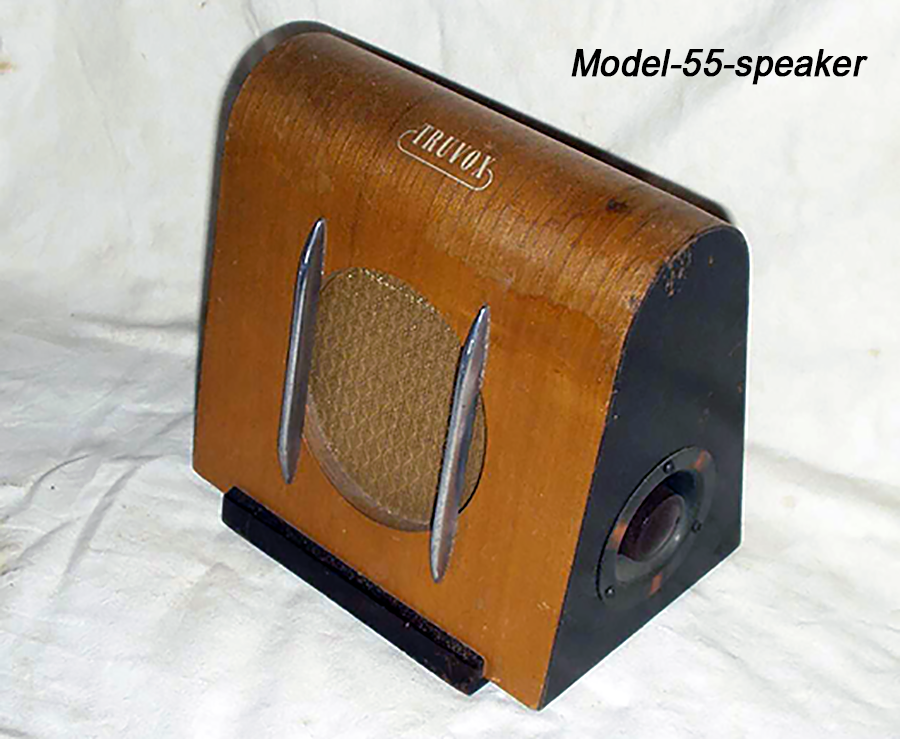

Further development of Truvox
 In 1948-1950 production of Arti-Six cameras came to an end. Truvox continued from 1950 to 1956 with the Wembley Sports using moulds and tooling from the production of the Arti-Six. Both these 120 rollfilm cameras bear a close resemblance to the smaller Artima Photo-Magic which takes 127 size film.
In 1948-1950 production of Arti-Six cameras came to an end. Truvox continued from 1950 to 1956 with the Wembley Sports using moulds and tooling from the production of the Arti-Six. Both these 120 rollfilm cameras bear a close resemblance to the smaller Artima Photo-Magic which takes 127 size film.
After the short six-year period in which Truvox itself was involved in manufacturing and marketing this Wembley camera, the company’s focus turned to the production of sound reproduction equipment including one of the earliest portable reel to reel tape recorders and industrial floor polishing machines and vacuum cleaners.
Today, as Truvox International, it still occupies a prominent position on both the UK and the world market with the last two products.
FOUNDING DATE: 1901
FOUNDER: Unknown
COMPANY NAMES:
1901: Bergmann & Co.; 1946: Turaphot;
COMPANY ADDRESSES:
1901: Wernigerode/Harz; 1948: Düren.
 Tura AG was a German distributor and manufacturer of film and paper products. The factory was established as Bergmann & Co. in 1901. Located in the western part of Germany in the town of Düren.
Tura AG was a German distributor and manufacturer of film and paper products. The factory was established as Bergmann & Co. in 1901. Located in the western part of Germany in the town of Düren.
It was renamed Turaphot after the second world war. They are mostly known for being a private label manufacturer. They would often repackage photo products from leading companies like Ilford and Agfa. They would work with small and large companies to make their house film and paper, with custom packaging and labelling.
In 1999, CPAC Inc., of Leicester, New York joins in a partnership that allows photographic chemicals to be distributed under the Tura name. In 2004-2005, Tura’s main film and paper suppliers AgfaPhoto and Ilford both went bankrupt.
During the reorganizations of both companies, Tura was unable to obtain the necessary credit to acquire materials, leading to problems fulfilling orders. During this period Agfa started expanding their own private label business and Ilford now under Harman Technology stopped their private label programme, not allowing others to used their products.
With its focus on predominantly analogue products (slide and negative films, photographic paper), the company was no longer able to compete with the competition. Photo Star currently (2012) has the rights to the Tura brand.
B&W Film
- Tura C-41 black and white BW400 film
- Tura Professional P100 black and white film
- Tura Professional P150 black and white film
- Tura Professional P400 black and white film
Paper
- TURA Profiline RA4 color roll paper
- TURA Vario paper
Colour Film
- Tura Life Premium 100 (35mm in 8, 12, 15, 24 and 35 exp)
- Tura Life Premium 200 (35mm in 8, 12, 15, 24 and 35 exp)
- Tura Life Premium 400 (35mm in 8, 12, 15, 24 and 35 exp)
- Tura Life Premium 800 (35mm in 36 exp)
Colour slide Film
FOUNDING DATE: 1932
FOUNDERS: Otto W. Githens and Jacob J. Shapiro
COMPANY NAMES:
1932: Universal Camera Corporation.
COMPANY ADDRESSES:
1932: 521 South Avenue, New York City and later 28 West 23rd street, New York, USA.
Universal Camera Corporation manufactured cameras, film rolls, movie cameras, binoculars, etc. until 1952, when the company declared bankruptcy.
The Universal Camera Corporation was founded in 1932 with sheer ambition. Otto W. Githens, a fledgling businessman with a couple of failed ventures under his belt, and Jacob J. Shapiro, experienced in public relations and sales.
Otto W. Githens was the president of the company. He was born in Philadelphia in 1893. His previous work experience included sales, financier, and taxi-fleet operator. Jack Shapiro’s early years are unknown, but his previous work experience was as an insurance broker. Neither gentlemen had camera manufacturing experience so the two approached Carl H. Whitlock of the Norton Company of Lockport, New York with a request to design a camera to address the need for an affordable camera utilizing the emerging moulded plastic industry. They were sure that it should be possible to produce a still camera cheaper than Kodak’s own Brownie No. 0, priced at just $1.50.
However, difficulties arose between the two companies near the end of manufacturing setup and Norton went forward with producing the camera on their own. Githens and Shapiro decided to develop a similar camera on their own and were able to bring it to market earlier than Norton.
It was called the Univex A which sold for 0.39 cents and required Univex film on a uniquely designed spool. The camera distribution was handled by New York Merchandise company, a sub-company under Universal. The UniveX Model A became a massive success.
The camera was originally marketed as a premium or giveaway in connection with other merchandise. Norton introduced their version of the same camera in 1934 and priced it at 0.50 cent. Since it was more expensive and late to market compared to the Univex, it did not get the same marketing support as the Univex. Universal was already producing just short of 1000 cameras a day in 1933 and produced well over a million in 1934. In 1937 the company sold over 22 million rolls of specialty no. 00 Univex roll film helping to strengthen the new company financially. In 1936 the company ventured into movie camera manufacturing with the affordable Univex Cine-8 for just $9.95. It was designed by George Kende, Universals Chief engineer.
A new market: movie cameras
It wouldn’t be until 1936 that Universal sought to continue their low-budget, mass market strategy in the movie camera market. With a cunning designer on board, George Kende, Universal would manufacture the UniveX Model A-8 Ciné Camera and P-8 Projector. Listed for a mere $9.95, the camera was a runaway success, even forcing Universal to postpone an extensive holiday advertising campaign in order to fill demand. The UniveX Model C-8, a close descendent of their initial A-8, featured below in the collection, was introduced at the 1939-40 World’s Fair, advertised as the “World’s Fair Ciné 8 Camera.”
Just before WWII Universal introduced their Cinémaster line, including the D-8 “Standard,” E-8 “Special,” and F-8 “Jewel.” With the on sought of WWII starting in Europe, film shortages were impacting the business in 1941. However, WWII meant Universal, like many other amateur cinema companies, would convert their production lines to support the war effort, and on January 1, 1942, Universal secured a contract to provide binoculars to U.S. and Allied forces.
They produced over $6 million in binoculars, gun-sights and other optics to support the war fighting effort, utilizing 99% of the factory for essential war work. Universal was awarded the Army-Navy “E” Award, or World War II Production Award, for achieving “Excellence in Production” of war equipment.
With the end of WWII Universal sought to jump back into the market quickly and refresh their Cinémaster line with minor modifications from pre-war models. The Cinémaster II Model G-8 is one such camera. It was essentially the pre-war F-8 model with minor modifications and new branding.
Also after WWII George Kende designed the Universal Mercury 35mm half-frame Camera. A very successful camera. The Universal Camera Company would typically procure the camera parts from various local manufacturers in New York and New Jersey and then perform final assembly and packaging.
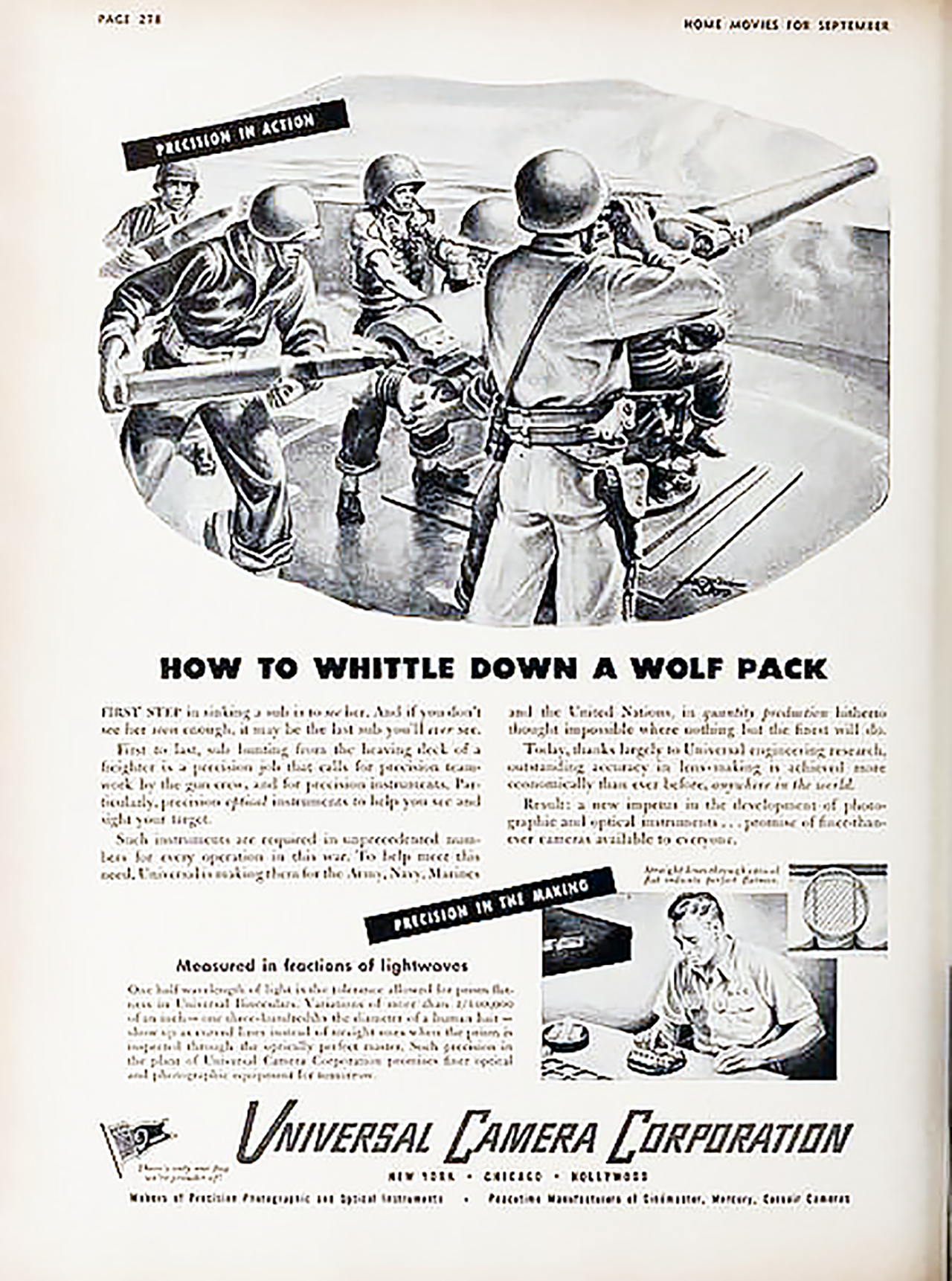
Wartime advertisement in the September 1943 issue of “Home Movies” magazine; This advertisement claims they made “precision optical instruments” for the Army, Navy, Marines, and the United Nations. The ad queries what the first step in whittling down a German U-boat wolf pack should be – seeing it first, of course, with Universal’s precision binoculars.
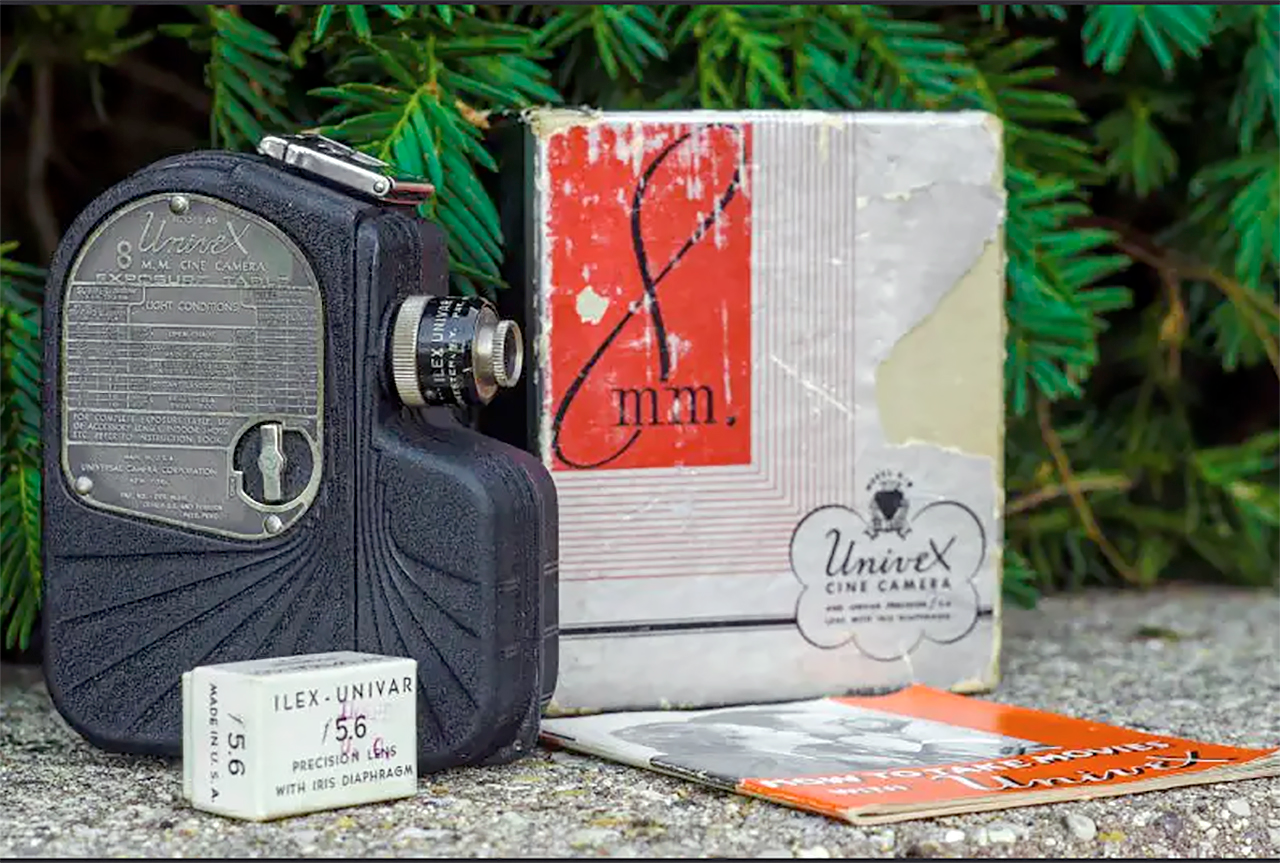
This is a Univex Cine “8” Model A8 made by the Universal Camera Corporation starting in 1936. The Univex Cine “8” represented an entire series of inexpensive 8mm cinema cameras that were sold starting in 1936 and lasted until the company’s demise in 1952. There were at least 8, possibly 9 models in the Cine “8” family all with names starting with the A8, lasting to the H8 with each model getting more advanced. The Cine “8” was a very successful camera and it’s $9.99 starting price helped it to bring motion picture photography to middle and lower class families who otherwise wouldn’t have been able to afford it.
In 1949 Universal experienced a downturn due to various sources including a crippling strike against local die-casting shops, which shut down a major supplier for Universal, a declining economy, the introduction of higher quality cheap cameras from Japan, the failure and costs of the Minute-16 and the emergence of Polaroid.
Universal’s final movie camera released in 1951 was the H-8 model, but few went into production. On April 15th, 1952 the company filed for bankruptcy in New York. It survived the bankruptcy for several years and ended operations in 1964.
This luckless time period also saw the downfall of two other major motion picture companies, Revere and Keystone. Regardless of their fate though, the Universal Camera Corporation opened up the field of amateur filmmaking to thousands of people who might never have had the chance.
Note that there were also cameras labeled Univex produced by the Spanish company Casa Univex. These seem to be unrelated to the ones of the Universal Camera Corp.
- Aristocrat ± 1935
- Buccaneer ± 1945
- Corsair I ± 1938
- Corsair II ± 1939
- Duovex ± 1934
- Girl Scout Univex ± 1935 – ± 1938
- Mercury Model CC ± 1938 – 1942
- Mercury Model CC 1500 ± 1938 – 1942
- Mercury II Model CX ± 1945
- Meteor ± 1949
- Minute 16 ± 1949
- Norton Univex ± 1935
- Roamer I ± 1948
- Roamer II ± 1948
- Roamer 63 ± 1948
- Stere’-All ± 1954
- The Hollywood Camera ± 1936 – 1940
- Troopers Club Convention 1936
- Twinflex ± 1939
- Uniflex I ± 1948
- Uniflex II ± 1948
- Univex A ± 1933
- Univex Iris ± 1938
- Univex Iris Deluxe ± 1938
- Univex Model AF ± 1935
- Univex Model AF2 ± 1936
- Univex Model AF3 ± 1936
- Univex Model AF4 ± 1938
- Univex Model AF5 ± 1938
- Univex Uniflash ± 1940
- Vitar ± 1951
- Zenith ± 1939
- Univex Mercury Rangefinder
- Univex Mercury Rapid Winder
FOUNDERS: Max Ponder and John C. Best
COMPANY NAMES:
1938: Originally founded under the name Ponder & Best, Inc.; 1979: Vivitar Corporation; 1985: Vivitar was purchased by the Australian Hanimex Group; 1990: Vivitar and Hanimex were sold to UK-Based Gestetner PLC; 1996: Plaza Create Co Ltd of Japan, acquired Vivitar Inc.; 2006: bought by Syntax-Brillian Corporation; 2008: Syntax-Brillian filed for bankruptcy – Sakar International acquired the Vivitar brand; 2008: Vivitar’s assets and product stock were liquidated in a massive online auction; The online auction ended Vivitar’s existence as a company after 70 years (1938-2008).
COMPANY ADDRESSES:
1938: Santa Monica, California; 1940-1946: 1015 S. Grand Ave., Los Angeles, CA 90015; 1949: 230 S. Grand Ave., Los Angeles, CA 90015; 1960s: 11201 West Pico Boulevard, Los Angeles, CA 90064; 1971: Pico Blvd, 1630 Stewart Street, Santa Monica, CA 90406; 1994: Thousand Oak, CA.
Vivitar Corporation was a manufacturer, distributor, and marketer of photographic and optical equipment originally based in Santa Monica, California. Since 2008, the Vivitar name serves as Sakar International’s house brand for digital imaging, optics, mobile accessories, and audio products. The company’s product line has included 35 mm SLR cameras, zoom lenses, flashes, film enlargers, binoculars, digital cameras, night vision products, point-and-shoot cameras, tripods, underwater cameras, smart home technology, health and wellness accessories, and other audio/video equipment. The shift to autofocus cameras and later to digital cameras created difficult transitions, leading to a series of mergers, ownership changes, and eventual bankruptcy in 2008. The company itself is gone now but the Vivitar brand was purchased and continues to be used for marketing photographic gear.
Originally founded as Ponder & Best, Inc., the company was established in Santa Monica, California in 1938 as a distributor of photographic products by the German immigrants Max Ponder and John C. Best. Ponder and Best fled to the United States from Germany after Hitler rose to power.
The pair started out selling photographic equipment from a 1936 Oldsmobile. Best wrote invoices from the back seat while Ponder acted as the salesman and retrieved merchandise from the trunk.
In the 1940s through at least 1946, Ponder & Best was located at 1015 S. Grand Ave., Los Angeles, CA 90015. Advertising from November 1949 indicates P&B moved or expanded to an adjacent location at 1230 S. Grand Ave. The buildings at these two location no longer exist, only a vacant lot remains as of 2012.
Initially, Ponder & Best pursued relationships with major camera equipment manufacturers including Mamiya, Olympus, Rollei, Voigtländer, Sawyers, Petri and others, becoming the United States distributor for companies in Japan and Germany.
But in 1964, after losing Rollei and Olympus distribution rights, Ponder & Best decided to come up with their own brand and rebadge the equipment they sold.
Introduction of the Vivitar brand name
 They chose Vivitar as their brand name. While the majority equipment bore the “Vivitar” name alone, several variants were also used over the years: the earliest lenses bear the label “P & B Vivitar”. A small number of lenses custom-developed for specific customers were labelled “Vivitar Professional”, occasionally special edition equipment bore labels such as “Vivitar RL Edition”, “Vivitar SMS”, or “Vivitar DL”.
They chose Vivitar as their brand name. While the majority equipment bore the “Vivitar” name alone, several variants were also used over the years: the earliest lenses bear the label “P & B Vivitar”. A small number of lenses custom-developed for specific customers were labelled “Vivitar Professional”, occasionally special edition equipment bore labels such as “Vivitar RL Edition”, “Vivitar SMS”, or “Vivitar DL”.
The most well known variant is “Vivitar Series 1” a badge created for the highest end equipment (though after the 2008 dissolution of the company, the “Vivitar Series 1” label began to be used interchangeably with the plain “Vivitar” badging). Ponder & Best filed for the Vivitar trademark on 21 September, 1965. The application states that the name Vivitar was first used in commerce in November of 1963.
In the 1960s, Ponder & Best was located at 11201 West Pico Boulevard, Los Angeles, CA 90064. The building at this location, built in 1947, is still standing and is zoned for retail use. In 1964, they also opened two branch offices, one in New York city and one in Chicago.
From the late 1960s through 1970s, Ponder & Best’s success was largely due to their strategy of providing high quality lenses for SLR cameras at prices lower than the major camera manufacturers. By selling lenses in higher volumes, P&B believed they could match the quality of the camera maker’s lenses at lower cost.
In addition to marketing their own Vivitar badged products, Ponder & Best continued to represent other manufacturers, eventually regaining their position as an Olympus distributor by 1968.
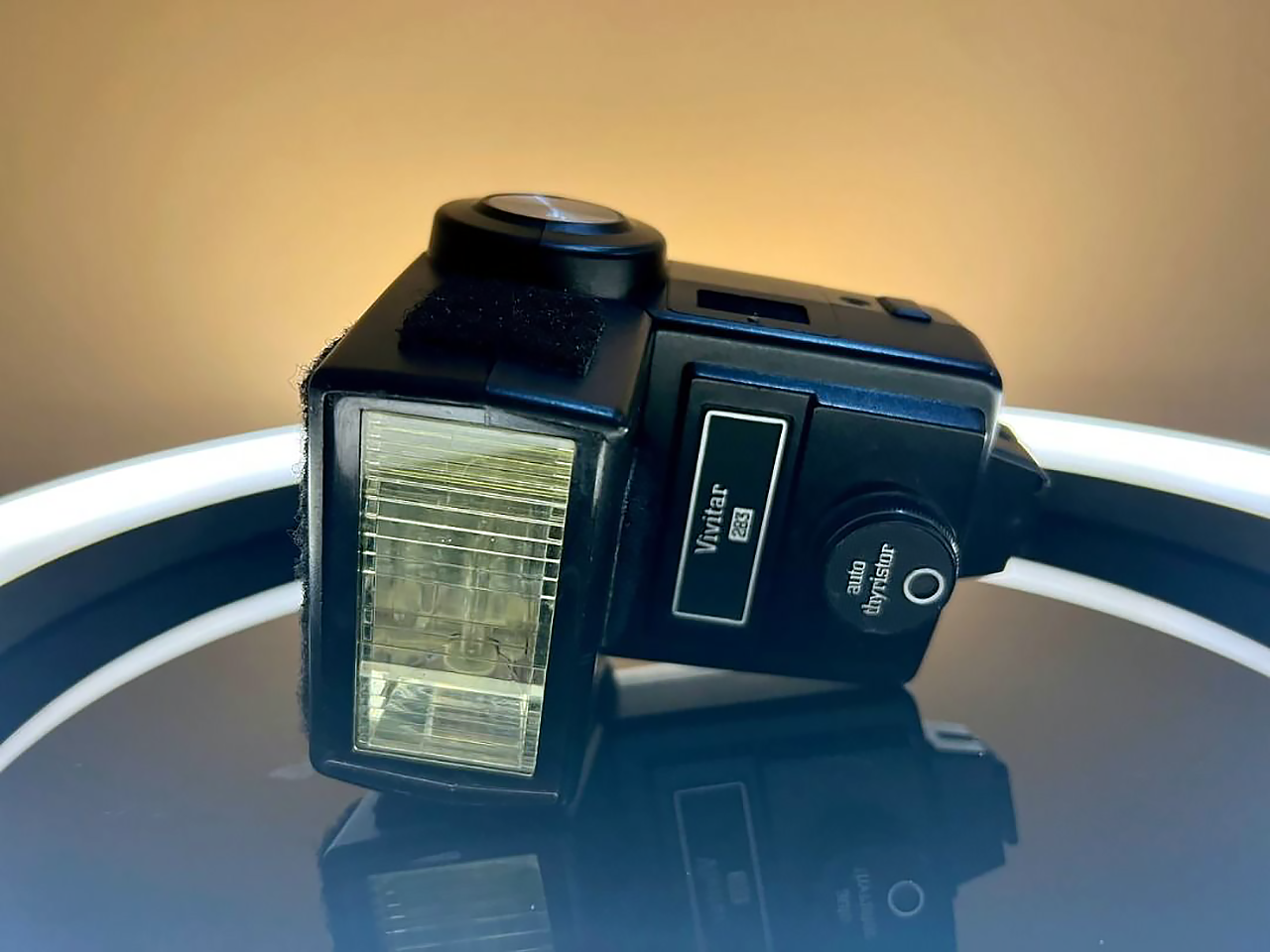
The Vivitar 283 is the world’s most classic of all flashes. It’s a fully automatic system flash for use with most cameras, digital, 35mm and medium format. It is not only the world’s most popular flash of all time, it is also extremely modular: all sorts of crazy and sane accessory filters, zoom filters, light modifiers, cables, sensors and battery packs and more are available.
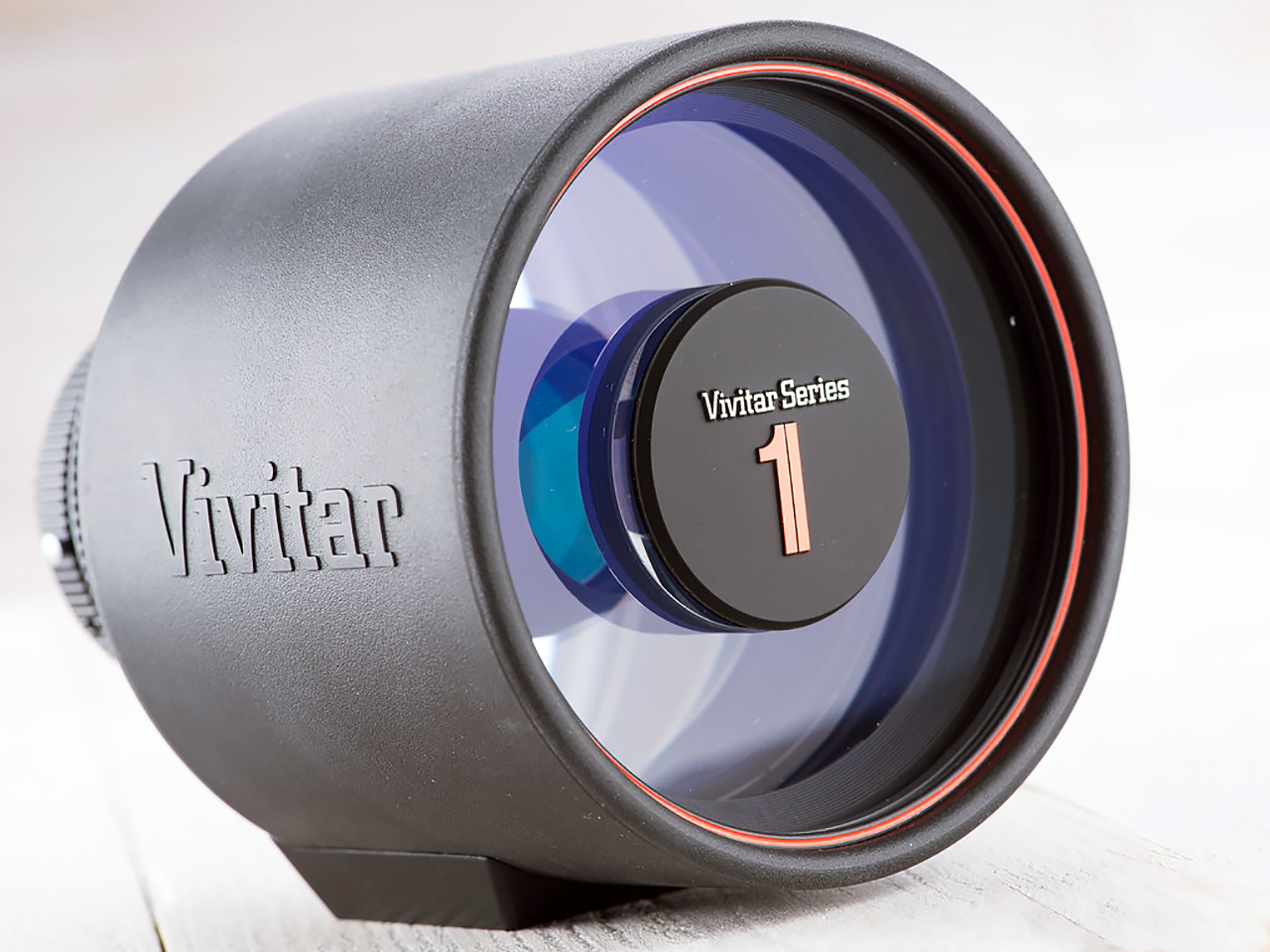
The Vivitar Solid Catadioptric lens is an outstanding, almost unknown lens. Once upon a time in the middle 1970’s to early 1980’s, Vivitar was a shaker and a mover in the world of 35mm photography, believe it or not. They were the first modern independent lens maker to assault the supremacy of SLR manufacturers with startlingly independent and innovative designs. The 450/4.5 Series One Mirror lens is among their very best. Introduced in 1983, f/4.5 is fast for any 450 lens. Yet the designers did not stop there. The front element is aspherical, and plastic!! This is one of the few uses of Aspherical lenses in mirror lenses. Apparently it was produced only a year, making it a very rare bird today.
Vivitar Flash gear
Vivitar also offered a new type of semi-professional flash unit from National/Panasonic called the Vivitar 260. The flash was acclaimed for its innovative design, but criticized for its use of expensive 9-volt batteries. Recognizing the problem, Max Ponder travelled to Japan to meet with the manufacturer, offering suggestions for improvements based on the feedback received from customers.
The improved flash was introduced in 1970 as the Vivitar 283, which quickly became the number one professional and enthusiast flash unit, outselling all its competitors combined and selling 3,000,000 units by 1973.
In production for over 30 years, it was twice returned to production in response to customer demand after having been discontinued. There was also the model 285, which featured a zoom head to cover different focal length lenses and a built-in variable power setting.
Earlier made-in-Japan Vivitar flashes have a trigger voltage of 250 V, which can damage the circuits of some digital cameras. Newer units made in China and Korea are low-voltage units producing 5 to 12 volts. The 283 and 285 have a removable sensor; an optional remote sensor cord makes off-camera automatic flash possible.
A new marketing strategy for lenses
In late 1971, Ponder & Best moved from the Pico Blvd location in LA to 1630 Stewart Street, Santa Monica, CA 90406. The building at this location is still standing and has since been renovated.
In the early 1970s, Ponder & Best decided on a new strategy for their Vivitar lenses. Up until now, they had selected lenses designed and built by other manufacturers and rebadged them as Vivitar lenses. Now they set out to create designs for high-quality lenses to their own specifications.
They would still outsource the manufacture of the lenses to other companies but the designs would be Vivitar’s. These new high-quality lenses were badged as Vivitar Series 1 lenses.
 This new strategy started with three Ponder & Best employees; researchers Gary Eisenberger and Murray Schwartz, and product manager Bill Swinyard. Eventually, Ponder & Best brought in American company OPCON Associates of Standford, CT for the initial Series 1 lens designs.
This new strategy started with three Ponder & Best employees; researchers Gary Eisenberger and Murray Schwartz, and product manager Bill Swinyard. Eventually, Ponder & Best brought in American company OPCON Associates of Standford, CT for the initial Series 1 lens designs.
Founder and chief designer at OPCON was Ellis Betensky, who had previously worked for Perkin-Elmer on projects such as the Sky Lab Zoom Telescope.
Due to Betensky’s associations with Perkin-Elmer, OPCON was able to access the latest computer technology for use in the Series 1 design work, leading to highly complex optical designs unlike any previous zoom lenses.
Betensky originated the idea of altering the air space between lens elements as the focus changed, resulting in close focusing capabilities that far exceed other lens designs of the era.
After the success of its aftermarket lens line, Vivitar later introduced its own line of 35mm film cameras manufactured by Japanese companies such as Cosina. These include the Cosina-made Vivitar SLR and the Vivitar 35ES/EE series of rangefinder camera.
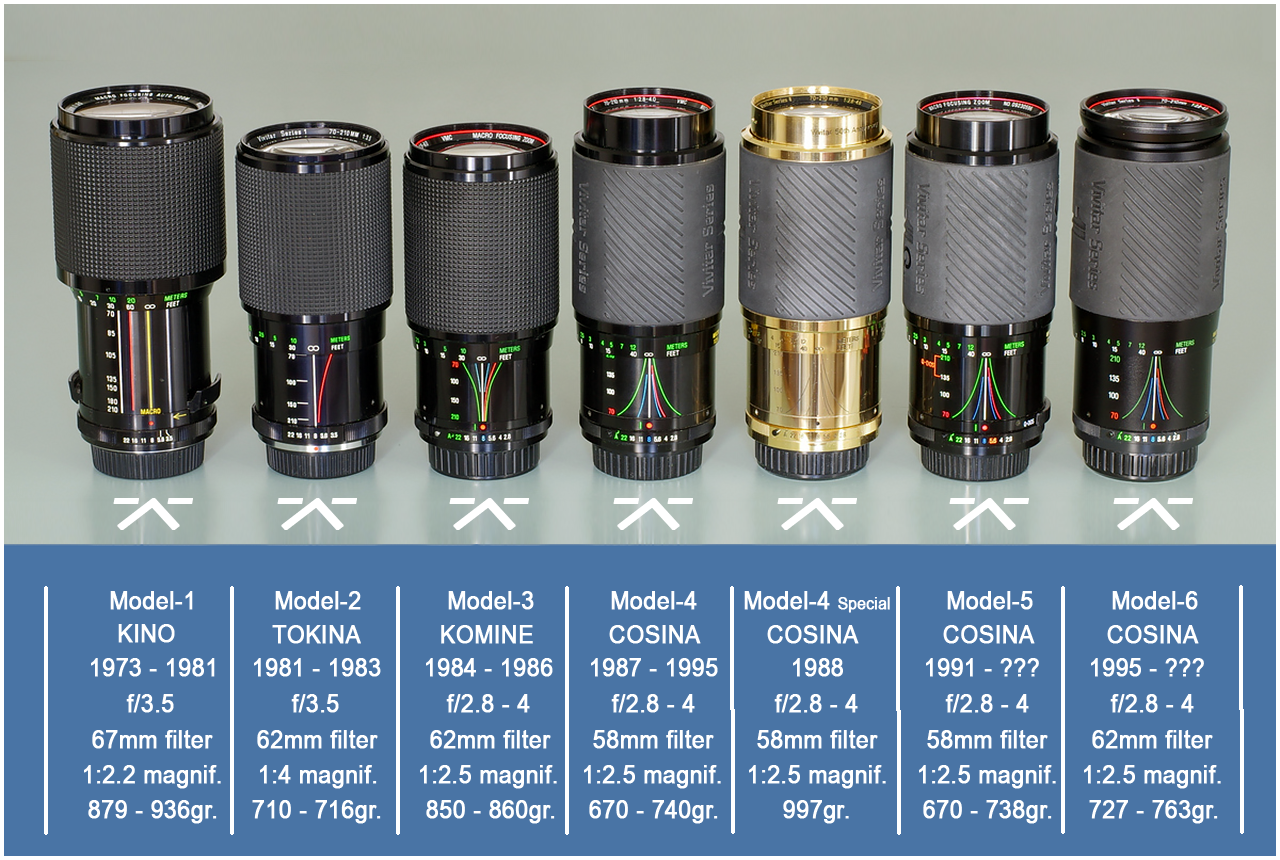
There are six versions of the manual focus Vivitar Series 1 (VS1) 70-210 zoom lenses, all of which can be distinguished apart from each other visually (and their manufacturers can be identified by using their serial numbers). Vivitar contracted with various lens makers to produce lenses to its own specifications, which it then marketed under the Vivitar brand (although the contractors would sometimes end up releasing similar lens designs under their own and/or other brands), and this always-a-lens-specifier-and-never-a-lens-maker characteristic is certainly true for all the VS1 70-210 zooms.

An overhead view of the Skylab Orbital Workshop in Earth orbit as photographed from the Skylab 4 Command and Service Modules (CSM) during the final fly-around by the CSM before returning home. The space station is contrasted against the pale blue Earth. The 100-ton laboratory complex Skylab space station is composed of the Command/Service Module (CSM), Orbital Workshop (OW), Apollo Telescope Mount (ATM), Multiple Docking Adapter (MDA), and Airlock Module (AM). Skylab Orbital Workshop fulfilled all its mission objects serving as home to additional crews before being deorbited in 1978.
Finally, the company name becomes Vivitar Corporation
The corporate name was changed to Vivitar Corp. in 1979 based on the success of its leading brand name. Over the years, Vivitar became a multinational manufacturing and marketing company with subsidiaries in Japan, West Germany, France, Canada, the United Kingdom, the Netherlands, Belgium, and Switzerland.
As an early adopter of outsource and branding techniques, Vivitar ran into early pitfalls. The biggest problem that plagued Vivitar was lack of control over their outsourced manufacturing. Vivitar provided overseas manufacturers with valuable specifications and equipment designs. Sometimes the manufacturers used the equipment designs in ways they were not authorized to including:
- 1) manufacturing additional units and selling them directly to competing importers as Vivitar badged equipment;
- 2) manufacturing rebadged or slightly modified versions for competing companies;
- 3) manufacturing additional units under the manufacturer’s own badging.
Disputes over these issues were responsible for some of Vivitar’s shifts from one manufacturer to another. In 1984 Vivitar brought suit against the United States in the Court of International Trade for declining to prevent “third parties” from importing unauthorized Vivitar branded equipment. The US argued that since Vivitar had instructed the manufacturers to put a Vivitar label on the products, they were by definition authorized, regardless of the contractual arrangements (or lack of them) between Vivitar and the manufacturer.
Vivitar prevailed in the case but the US appealed and won, meaning that US customs could continue to allow the import of unauthorized Vivitar badged equipment and it would be up to Vivitar to discover and pursue the individual US importers who received the unauthorized goods and file suit against them under other parts of the trademark law.
A variety of new owners pop up
 In 1985, Vivitar was purchased by Australian company, Hanimex Group, a subsidiary of Australian real estate developer, Chase Group. The year before Hanimex took over, Vivitar lost five million US dollars. The year after the takeover Vivitar experienced a four-million-dollar profit. By 1988 Vivitar has reached 100 million US dollars in annual sales.
In 1985, Vivitar was purchased by Australian company, Hanimex Group, a subsidiary of Australian real estate developer, Chase Group. The year before Hanimex took over, Vivitar lost five million US dollars. The year after the takeover Vivitar experienced a four-million-dollar profit. By 1988 Vivitar has reached 100 million US dollars in annual sales.
In the late 1980s Vivitar introduced self-contained, battery-powered auto-focus lenses. These were fixed mount lenses designed for conventional, non-autofocus SLRs. Mounts available included Canon FD, Pentax K, Nikon AI-S, and others. There were both Vivitar and Vivitar Series 1 branded auto-focus units. The concept was later abandoned, making these lenses relatively rare.
A real estate slump in the late 1980s forced Chase Group to sell several of its business. Vivitar and Hanimex were sold to UK-Based Gestetner PLC (itself owned by Ricoh) in early 1990. In March of 1990, John Bourne was named president of Vivitar. After Gestetner took over, Vivitar shifted it’s focus from high-end lenses and flashes, to hand-held, point-and-shoot cameras.
In 1993, Concord Camera Corp, a manufacturer of pocket cameras, attempted to buy Vivitar from Gestetner PLC but was unable to finalize the purchase when increasing financial losses prevented them from coming up with the required cash in time. Concord’s President, Victor M. Chernick, was president of Vivitar from 1986 through 1989. At this time Vivitar had 120 employees.
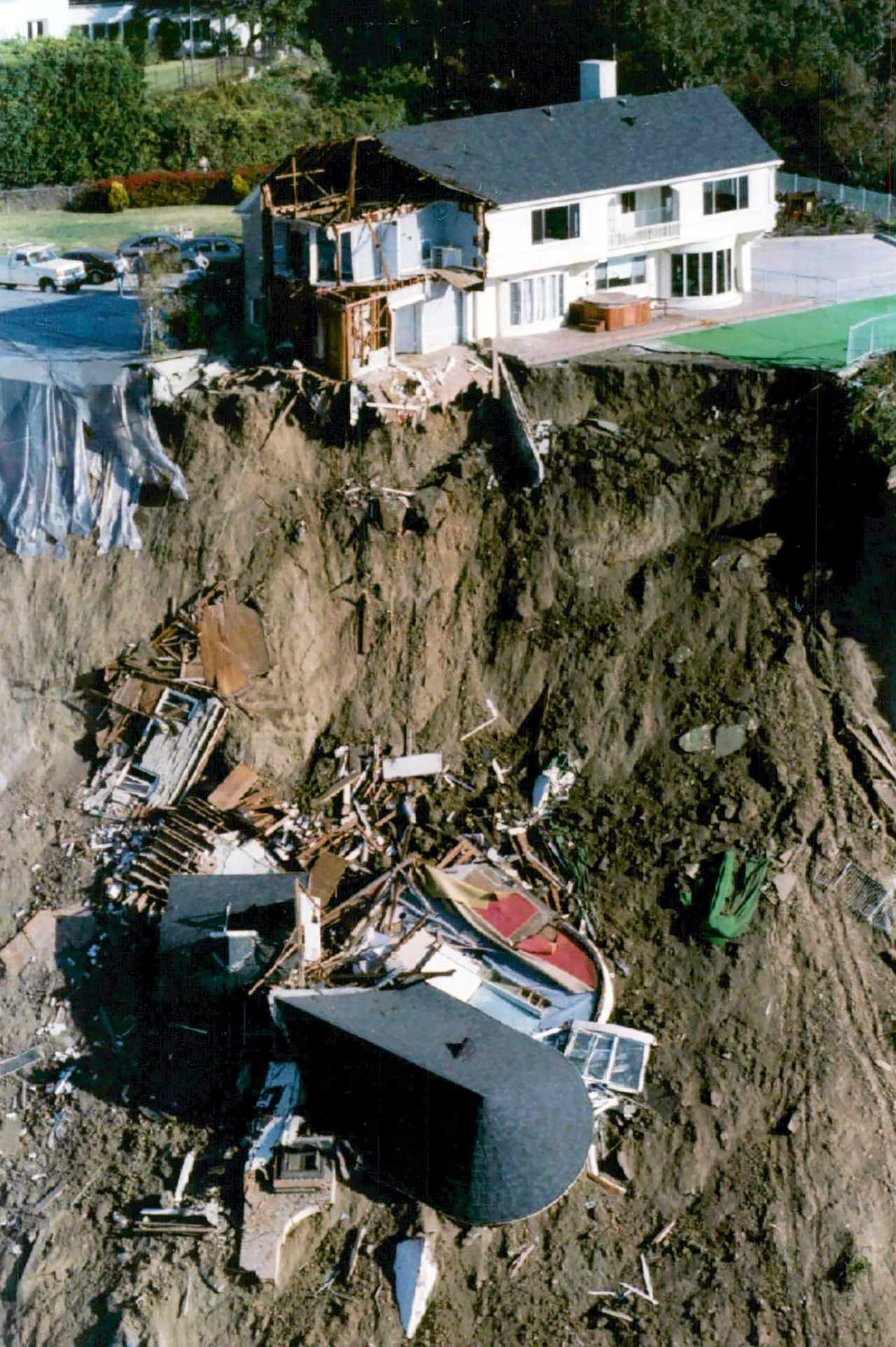
The Northridge earthquake of 1994, earthquake that struck the densely populated San Fernando Valley in southern California, U.S., on January 17, 1994. The third major earthquake to occur in the state in 23 years was the state’s most destructive one since the San Francisco earthquake of 1906 and the costliest one in U.S. history. The quake had a duration of approximately 10–20 seconds, and its peak ground acceleration of 1.82 g was the highest ever instrumentally recorded in an urban area in North America. Shaking was felt as far away as San Diego, Turlock, Las Vegas, Richfield, Phoenix, and Ensenada.
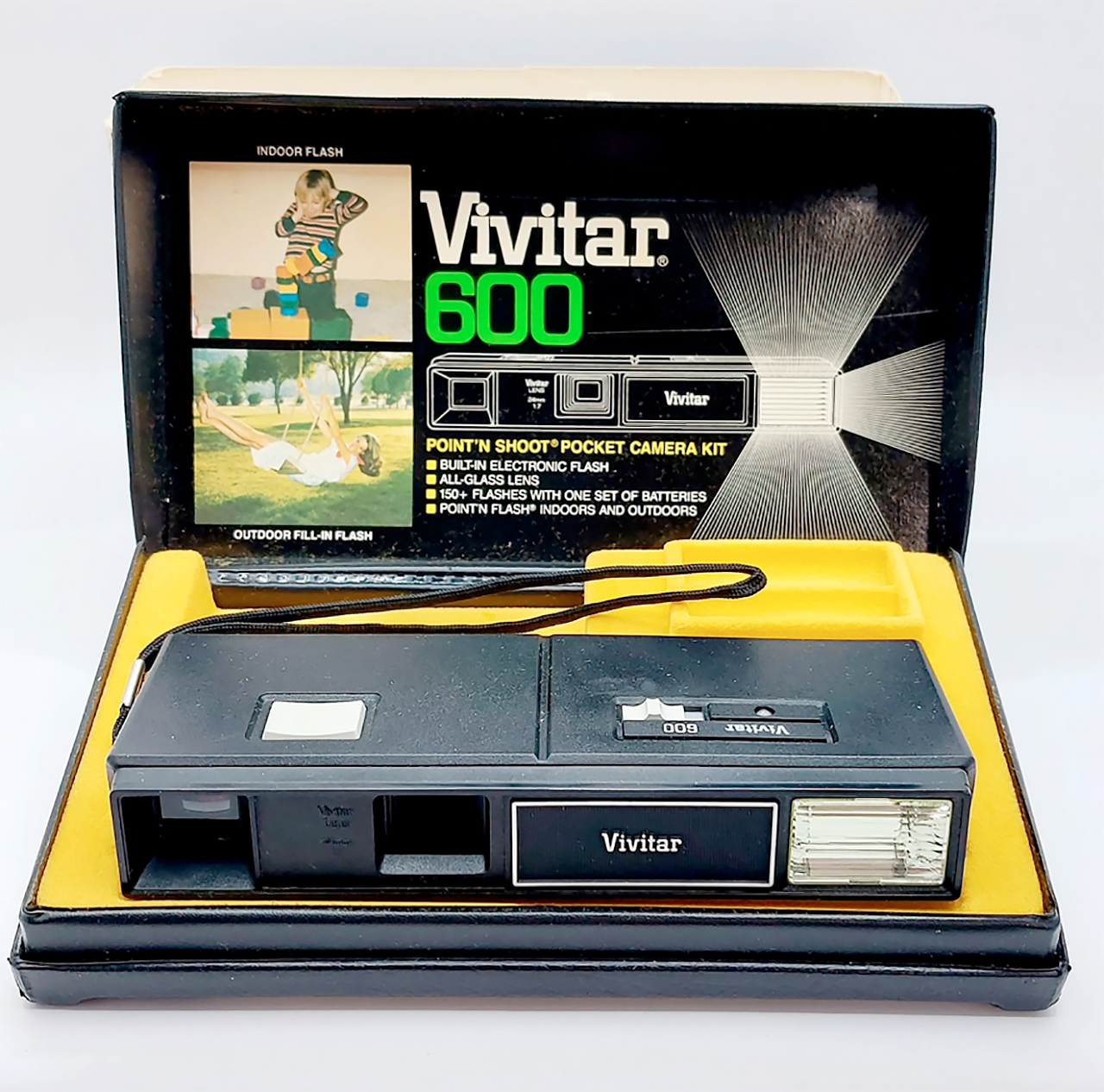
In the 1990s, Vivitar shifted it’s focus from high-end lenses and flashes, to hand-held, point-and-shoot cameras. The Vivitar 600 Pocket Point & Shoot 110 Film Camera is a plastic camera taking 17mm x 13mm images on 110 film, marketed from about 1986 by Vivitar. The camera is believed to have been manufactured in China. The Point ‘N Shoot 110 has fixed focus and exposure. The retail version was black. The slot in the top of the camera is for a Flip-Flash disposable strip of flashbulbs.
Victim of a natural disaster
The 1994 Northridge earthquake damaged Vivitar’s primary facilities in the San Fernando Valley and caused the loss of product stock. This is said by some to be responsible for the final demise of the Vivitar Series 1 lenses, which were already suffering a decline in sales due to Gestetner’s new focus on selling point-and-shoot cameras and Vivitar’s decision not to pursue auto-focus technology. Vivitar subsequently moved to Thousand Oak, CA.
On September 30, 1996, Plaza Create Co Ltd of Japan, acquired Vivitar Inc. from Gestetner PLC. In January 1997, President and CEO of Vivitar, Alex Wijnen, announced the company would be split into two divisions: the Photographic and Optics Division, and the Electronics and Digital Imaging Division. On February 24, 1998 Douglas E. Howe was named president of Vivitar.
The end of camera and lenses production
The company was bought on November 21, 2006 by Syntax-Brillian Corporation. Two years later on July 8, 2008, Syntax-Brillian filed for bankruptcy. Sakar International, based in Edison, New Jersey, acquired the Vivitar brand and intellectual property on August 21, 2008.
The deal did not include Vivitar’s equipment or facilities. After the sale, Vivitar’s assets and product stock were liquidated in a massive online auction that included more than 13,000 digital cameras, camcorders, and other photographic gear.
The online auction ended Vivitar’s existence as a company after 70 years (1938-2008). The brand name lives on, however, and continues to be used for marketing photographic equipment.
 In August 2008, Sakar announced plans to position Vivitar as a brand for its current mass retail digital cameras in the midprice range of $70–$300, along with certain camera accessories. New Vivitar-branded products such as digital photo frames are also planned, as well as potential licensing opportunities.
In August 2008, Sakar announced plans to position Vivitar as a brand for its current mass retail digital cameras in the midprice range of $70–$300, along with certain camera accessories. New Vivitar-branded products such as digital photo frames are also planned, as well as potential licensing opportunities.
In January 2009 Sakar introduced three new Vivitar-branded cameras and a digital SLR lens series. The products are Sakar’s first Vivitar-branded items since acquiring the brand. In addition to other electronics products, in 2013 they announced and then shipped the $150 XO Tablet, a 7-inch Android tablet designed for children, with a bilingual English/Spanish interface.
survey of vivitar cameras, lenses and Flash units

Listed in order of release date and ascending model number.
Lens mount type and manufacturer is listed if known.
APS Film Cameras
- CV24
- PZ31 40QD
- XB100 Big View
- XB200 Big View
- xm-1k
- XM130
- XM230
- XM300
- Z240
- Z350
- Z360ix
- Z385
110 Film Cameras
- 110 Point ‘N Shoot
- 110EF
- 110EF Pocket
- 110EF Tele
- 402
- 406
- 600 Point ‘N Shoot
- 602 Point ‘N Shoot
- Tele 603
- 604 Point ‘N Shoot
- 700 Point ‘N Shoot
- 702 Point ‘N Shoot
- Tele 703 Point ‘N Shoot
- 742 XL Point ‘N Shoot
- Tele 805 Point ‘N Shoot
- 810
- Tele 815 Point ‘N Shoot
- 820 Point ‘N Shoot
- 830AW Point ‘N Shoot
- Tele-835AW Point ‘N Shoot
- 840 Motor Point ‘N Shoot
- 845 Tele Motor
- A. Brites
- LF
- LF tele
- Micro 110
- Opus 10
- Opus 20
- Radio 110
35mm film cameras
Interchangeable Lens
- 220/SL – M42 screw, by Cosina
- 250/SL – M42 screw, by Cosina
- 400/SL – M42 universal screw, by Cosina
- 420/SL – M42 universal screw, by Cosina
- 450/SLD – M42 universal screw, by Cosina
- 650/SLX – M42 universal screw, by Cosina (only prototypes – shown at Photokina 1974
- XC-2 – M42 universal screw, by Cosina
- XC-3 – M42 universal screw, by Cosina
- XC-4 – M42 universal screw, by Cosina
- XV-1 – Pentax K, by Cosina
- XV-2 – Pentax K, by Cosina
- XV-3 – Pentax K, by Cosina
- XV-5 – Pentax K (Chinon CM-5?)
- XV-10 – Pentax K, by Cosina
- XV-11 – Pentax K (Chinon CM-4s?)
- XV-20 – Pentax K mount, by Cosina
- V335 – Pentax K, by Cosina
- V635 – Pentax K, by Cosina
- V50 – Minolta MD (likely made in China by Seagull)
- V60 — Pentax K, likely a rebadged Cosina C2
- V2000 – Pentax K, by Cosina
- V3000, V3000s – Pentax K, Chinese OEM
- V3000N – Pentax K, Chinese OEM
- V3200 – Pentax K, Chinese OEM
- V3300se – Pentax K, Chinese OEM
- V3600 – Pentax K, by Cosina
- V3800N – Pentax K, Chinese OEM
- V4000, V4000s – Pentax K, by Cosina
- VN5000 – Nikon F (AI-S), Chinese OEM
- V6000 – Pentax K, by Cosina
35mm film rangefinders
Auto Focus Lens
- 240Z
- 250PZ
- 270PZ
- 280PZ
- 300Z
- 320 Z
- 335 Z
- 335 PZ DB
- 357 PZ Quartz Date
- 457 PZ Quartz Date
- 530 PZ Date-A-Print
- 550PZ Data Back
- 2001Z
- AF255DB Date-A-
- AF450 (AF450DB)
- Vivitar Big View BV35
- BV35DB Big View
- BV65AF
- C35R Auto Focus / Motor / Red-Eye Reduction
- EZ250
- EZ3AF Data-A-Print
- Mega 200
- MV360
- PN919
- PS33BV
- PS60DB Date-A-Print
- PS77 Auto Focus / DX Motor
- PS88
- PS90 Data-A-Print
- PS650DB Date-A-Print
- PS:35
- PS:135
- PS:145
- PZ2370 DB
- PZ2800
- PZ3090 Date-A-Print
- PZ3110 Data Back
- PZ3115 Date-A-Print
- PZ3118
- PZ3125 Quartz Date
- PZ3140
- PZ3815 DB
- PZ3890 DB
- PZ3580 DB
- PZ7000 Quartz Date
- PZ8000
- R-400 Auto Flash Motorized DX
- R-600
- RL 4000
- Series 1 320Z
- Series 1 440PZ
- Series 1 450PZ
- Series 1 460PZ
- Series 1 470PZ Data Back
- Series 1 475PZ Quartz Date
- Series 1 480PZ
- Series 1 500PZ
- Series 1 650PZ DB
- Series 1 PZ3070 Date-A-Print
- Series 1 ZM80
- Series 1 ZM95DB
- ST165
- TEC 45
- TEC 155 with Series 1 Auto Focus Zoom Lens 35mm-79mm f/3.5-6.7
- TL70 Tele Wide
- TL 125 Auto Focus Tele/Wide
- TW 35
- V3500 Data Back
- VP2000
- VP4550
- VP5500 DB Panoramic
- VP5900DB Data Back, Big View/Auto Focus
- VP8000
- WZ28 Power Zoom
- XB200
- ZM5000 Power Zoom
35mm film rangefinders
Fixed Focus Lens
- 280 PZ Focus Free Power Zoom
- 35C1 Focus Free
- EF35
- 3Dcam Stereo camera (made by Loreo)
- A35 Splash Proof
- Amphibia underwater camera
- BF-5
- BV40 Focus Free/Motor
- BV50
- Champion 3
- Champion 35, 38mm lens (blue/black and red/black variants)
- Crayola Sport 35
- CV35
- CV40
- DL50
- DM750 Telemotor Focus Free
- ECO35
- ECO35H
- ECOSUN, 34mm lens
- EZ Motor Big View
- EZ Point ‘n Shoot Big View
- EZ200
- HC 2000 Focus Free
- IC 100
- IC 101 Panorama (panoramic)
- IC 111 Focus Free
- IC 400
- IC 1200
- J301
- LC600 Focus Free
- LC650 Focus Free
- LI-55
- LP45 Focus Free / Motor
- Opus 35, 34mm lens
- Opus 35 Motor
- PN2011 (panoramic)
- Point’N Shoot 400
- PS 1-2-3 Focus-Free/DX
- PS:5
- PS:10 Focus Free, 38mm lens
- PS12
- PS15, 35mm lens
- PS:20
- PS25
- PS:30
- PS33 Focus Free, 33mm lens
- PS40 Focus Free Data Back
- PS44 Focus Free/DX
- PS44s Focus Free
- PS45PDB Data Print (panoramic)
- PS45s, 28mm lens
- PS50DB Date-A-Print
- PS51P Panorama (panoramic)
- PS55s
- PS:120 Focus Free/DX
- PS:130 Focus Free/Auto Flash
- PS420 (panoramic)
- PZ3052 (panoramic)
- RL 2000 Focus Free/DX
- Spree Free Focus Free / Motor
- Spree Plus Focus Free
- T101 Focus Free, 28mm lens (silver/black and red/black variants)
- T150 Focus Free (panoramic)
- T200 (panoramic)
- T201 lx
- T301
- TL45 Clearcam, 27mm lens
- TL70 Tele Wide Focus Free
- Twin735 Focus Free / Tele-Wide / Motor
- Ultra Compact
- Ultra Wide & Slim
- Viewpoint, 28mm lens
- Vista Tele (panoramic), 35mm/70mm lens
- Vista Tele Motor (panoramic) 35/70mm lens
- VP1000 Focus Free / Auto Flash
- WZ28 Focus Free
35mm rangefinders
fixed Lens
- 35CA
- 35EE
- 35ES
35mm rangefinders
Zone focus Lens
- 35EF
- 35EM
Super 8mm Film
Cine Cameras
- TL3 (ca 1967)
- TL4 (ca 1967)
- TL6 (ca 1967)
- TL268 (ca 1968)
- TL368 (ca 1969)
- TL468 (ca 1968)
- TL398 (ca 1968)
- 83 Super 8mm (ca 1969)
- 84 Super 8mm (ca 1969)
- 84P Super 8mm (ca 1969)
- 85P Super 8mm (ca 1969)
- 88P Super 8mm (ca 1970)
- 94P Super 8mm (ca 1971)
- 94PM (macro) Super 8mm (ca 1971)
- 96P Super 8mm (ca 1971)
- 98P Super 8mm (ca 1971)
- 98PM (macro) Super 8mm (ca 1971)
- 100PM (macro) Super 8mm (ca 1971)
lenses
- Vivitar 35-70mm 1:3.5-4.8 Macro Focusing Zoom 52mm
- Vivitar 35-105mm f/3.5 Close Range zoom
- Vivitar 90-230mm f/4.5 Close Focus zoom
Series I lenses
Vivitar Series I lenses represent the top products in Vivitar history.
- 24-48mm f/3.8 zoom
- 28-90mm f/2.8 zoom
- 28-105mm f/2.8 zoom
- 35-85mm f/2.8 variable focus
- 70-210mm f/3.5 zoom
- 90-180mm f/4.5 Flat Field Macro Zoom
- 28mm f/1.9
- 90mm f/2.5 macro with 1:1 optical converter
- 105mm f/2.5 macro 1:1
- 135mm f/2.3
- 200mm f/3
- 400mm f/4.5 mirror lens
- 600mm f/8 Solid Cat mirror lens (Perkin-Elmer mfg.)
- 800mm f/11 Solid Cat mirror lens (Perkin-Elmer mfg.)
Manual Flash units
- Vivitar Model 91
Auto/Manual Flash units
- Vivitar Model 265 Auto Thyristor Flash
- Vivitar Model 272 Auto Thyristor Flash
- Vivitar Model 273 Auto Thyristor Flash
- Vivitar Model 283 Auto Thyristor Flash
- Vivitar Model 285 Auto Thyristor Flash
- Vivitar Model 365 Auto Thyristor Flash
- Vivitar Model 550fd Auto Thyristor Flash
- Vivitar 4600 Auto Thyristor Flash
- Vivitar 3700 Auto Thyristor Flash
- Vivitar 3600 Auto Thyristor Flash
- Vivitar 3500 Auto Thyristor Flash
- Vivitar 2800 Auto Thyristor Flash
- Vivitar 2500 Auto Thyristor Flash

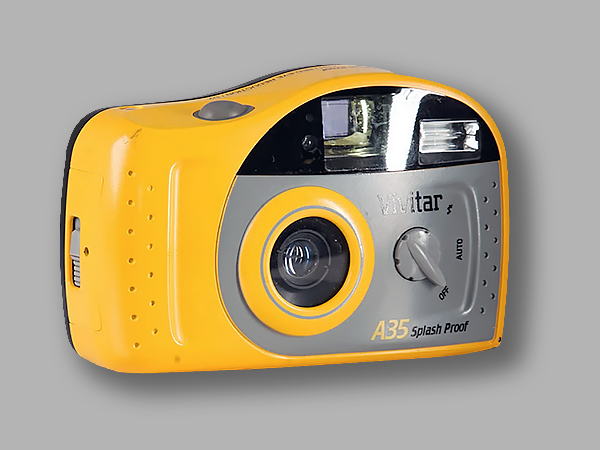
The A35 Splash Proof was manufactured in China around 1999 for Vivitar USA. It was part of the All Season Sports Kit which comprised an A35 Splash Proof camera and 8×21 compact binoculars, two AA batteries for the camera, and a 24-exposure roll of Kodak Gold Ultra 400 film. The 35mm fixed-focus camera is splash-proof by having o-ring seals for the film back and battery chamber. Film loading, advance, and rewind are all automatic. A built-in flash fires in low light.
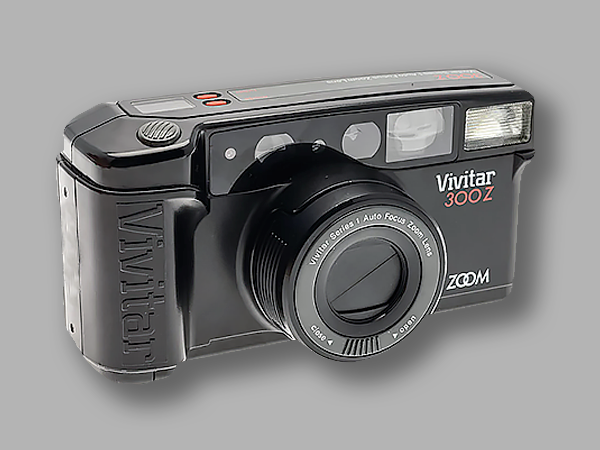
Here we have the Vivitar 300Z point-and-shoot 35mm film camera. This camera is a point and shoot camera with some easy features. It has a capable and sharp manual zoom lens for many types of photography. It features automatic motor-driven film advance film advance and rewind, automatic flash control, automatic exposure and a self-timer. It is super compact, lightweight, and works on a readily available camera battery and has an LCD film counter.
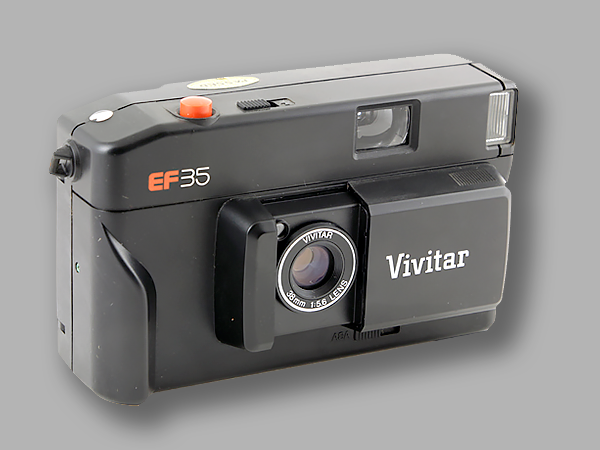
The Vivitar EF35 is yet another 35mm film camera by Vivitar. Dating from the 1980s, it should not be confused with the Vivitar 35EF, which is a completely different model.
The Vivitar EF35 has a built-in flash, a 38mm lens, and best of all, it has manual film advance and rewind (motor-drive film advances tend to fail on low-end cameras). It has a film speed setting (with options 100/200 and 400/1000).
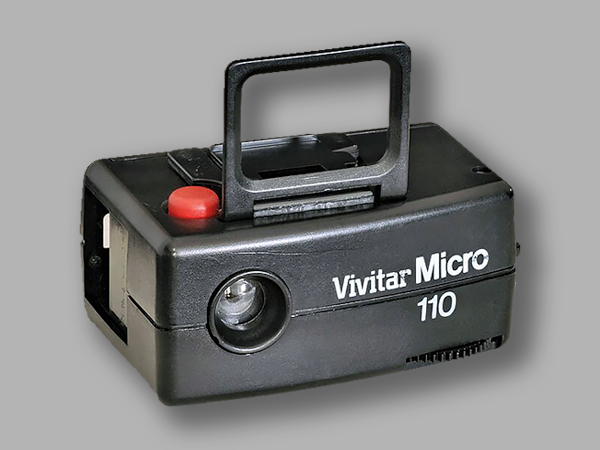
The Vivitar Micro 110 is a camera for 110 film. It is a keychain camera, a class of rather small cameras usually given away as promotional give-aways. It has a fixed-focus lens, no provision for flash, manual film advance, and a frame viewfinder. It could very easily be considered a toy camera. It is similar in concept to the Halina Micro 110, although they are not the same camera by any means.
COMPANY NAMES:
1849: Voigtländer & Sohn, Optical Institute; 1898: Voigtländer & Sohn AG; 1965: Voigtländer integrates in Carl Zeiss; 1972: Zeiss/Voigtländer stopped producing cameras; 1973: Zeiss sold Voigtländer to Rollei; 1982: On the collapse of Rollei, Plusfoto took over the name, selling it in 1997 to Ringfoto. From 1999 until the present time, Voigtländer-branded products have been manufactured and marketed by Cosina; for these, see Cosina Voigtländer.
COMPANY ADDRESSES:
1756: Vienna, Austria; 1862: Campe-Straße, Braunschweig (Brunswick), Germany.
Voigtländer was a significant long-established company within the optics and photographic industry, headquartered in Braunschweig, Germany, which name still exists today, but as a Japanese-owned company which makes a range of photographic products.
 Johann Christoph Voigtländer, the son of a carpenter, came to Prague in 1755, and to Vienna in the same year, and worked from 1757 to 1762 in the workshop of Meinicke, who produced mathematical instruments. Johann, had established a small business in Vienna in 1756, manufacturing microscopes, compasses and other optical instruments.
Johann Christoph Voigtländer, the son of a carpenter, came to Prague in 1755, and to Vienna in the same year, and worked from 1757 to 1762 in the workshop of Meinicke, who produced mathematical instruments. Johann, had established a small business in Vienna in 1756, manufacturing microscopes, compasses and other optical instruments.
Through Johann Voigtländer’s skilful achievements, the Minister of State of the Habsburg monarchy, Prince Wenzel von Kaunitz, drew attention to Voigtländer and Empress Maria Theresa of Austria granted Voigtländer in 1763 a so-called trade “Protection Decree” (German Schutzdekret / Schutzdecret): “on the making of mathematical instruments and on an unspecified number of workers”, upon which Voigtländer founded his own workshop and whereby he could sell his products relatively unrivalled.
In 1767, Voigtländer invented two important tools: a linear device for natural and tapered gauges, and a circular device for elevation, astrolabe, and cartography etc., including, a screw cutting machine, a metal lathe and finishing rollers for sheep wool and silk factories. Compasses, tweezers, levelling devices, dioptres and other fine mechanical products, supplemented the production program.
In recognition of his achievements and dexterity, Voigtländer received in 1797 in the year of his death a so-called “national commercial license with all advantages and privileges” (German Landesfabriksbefugnis); this license awarded Voigtländer under certain circumstances the prestige to display the imperial eagle of the Habsburg monarchy, but above all the right to establish branch sales offices in all major cities of the empire.
The next generations
 Johann had three sons and one daughter, the youngest of his sons, also named Johann, carried on the family business after his father’s death and began making lenses in about 1808. After he retired in 1837, the management of the family business was taken over by his son, Peter Wilhelm Friedrich, then aged just 25.
Johann had three sons and one daughter, the youngest of his sons, also named Johann, carried on the family business after his father’s death and began making lenses in about 1808. After he retired in 1837, the management of the family business was taken over by his son, Peter Wilhelm Friedrich, then aged just 25.
By this time the house of Voigtländer had already gained an enviable reputation as one of the very finest European optical instrument makers. Peter, although still comparatively young, already had a wealth of knowledge and experience. His early education and practical instruction came from his father. For his more advanced and theoretical education he later enrolled at the Vienna Polytechnic Institute.
Peter Voigtländer’s primary area of interest was optical theory. It was almost inevitable, therefore, that he soon befriended and began to collaborate with the brilliant mathematician Josef Max Petzval who in 1837, the same year that Peter took over the running of the family business from his father, had become professor of higher mathematics at the University of Vienna.
The Petzval Lens
 In 1840, Petzval, who had not designed a lens before, mathematically calculated the optimum arrangement for a lens intended specifically for photography. Up to this time, camera objectives were simple lenses that had been designed for other uses. The slowness of these lenses exacerbated the lack of sensitivity of the earliest photographic processes. Petzval entrusted the construction of his lens design to his friend, Peter Voigtländer.
In 1840, Petzval, who had not designed a lens before, mathematically calculated the optimum arrangement for a lens intended specifically for photography. Up to this time, camera objectives were simple lenses that had been designed for other uses. The slowness of these lenses exacerbated the lack of sensitivity of the earliest photographic processes. Petzval entrusted the construction of his lens design to his friend, Peter Voigtländer.
The Petzval lens had an aperture of about f/3.6. This made it sixteen times faster than the simple meniscus lenses that were currently in use and reduced exposure times from minutes to seconds, making portraiture a practical possibility for the first time. In 1841, Voigtländer fitted a Petzval lens into an all-metal Daguerreotype camera that he both designed and manufactured.
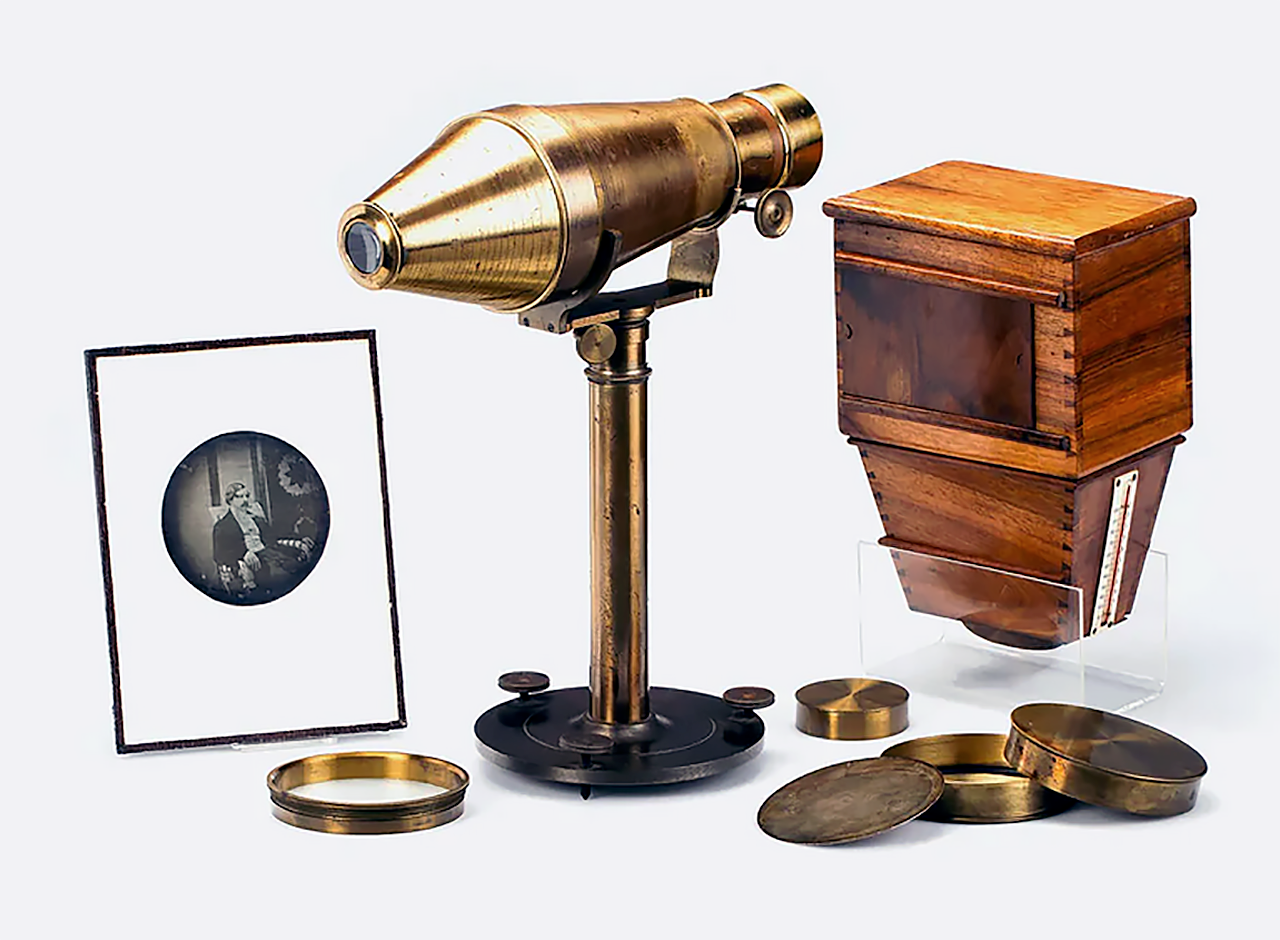
One of these rarities from the pioneering days of photography is now on permanent display in the collection of the Fotomuseum WestLicht. Not only the camera itself is exhibited in the showcase, but also the original “vaping device” device (of which only one other is known worldwide), accessories, instructions from 1841 and also daguerreotypes in the characteristic round format. One of these rare photographs shows a portrait of Maximilian von Bayern from 1841, the father of the later Empress Sisi.
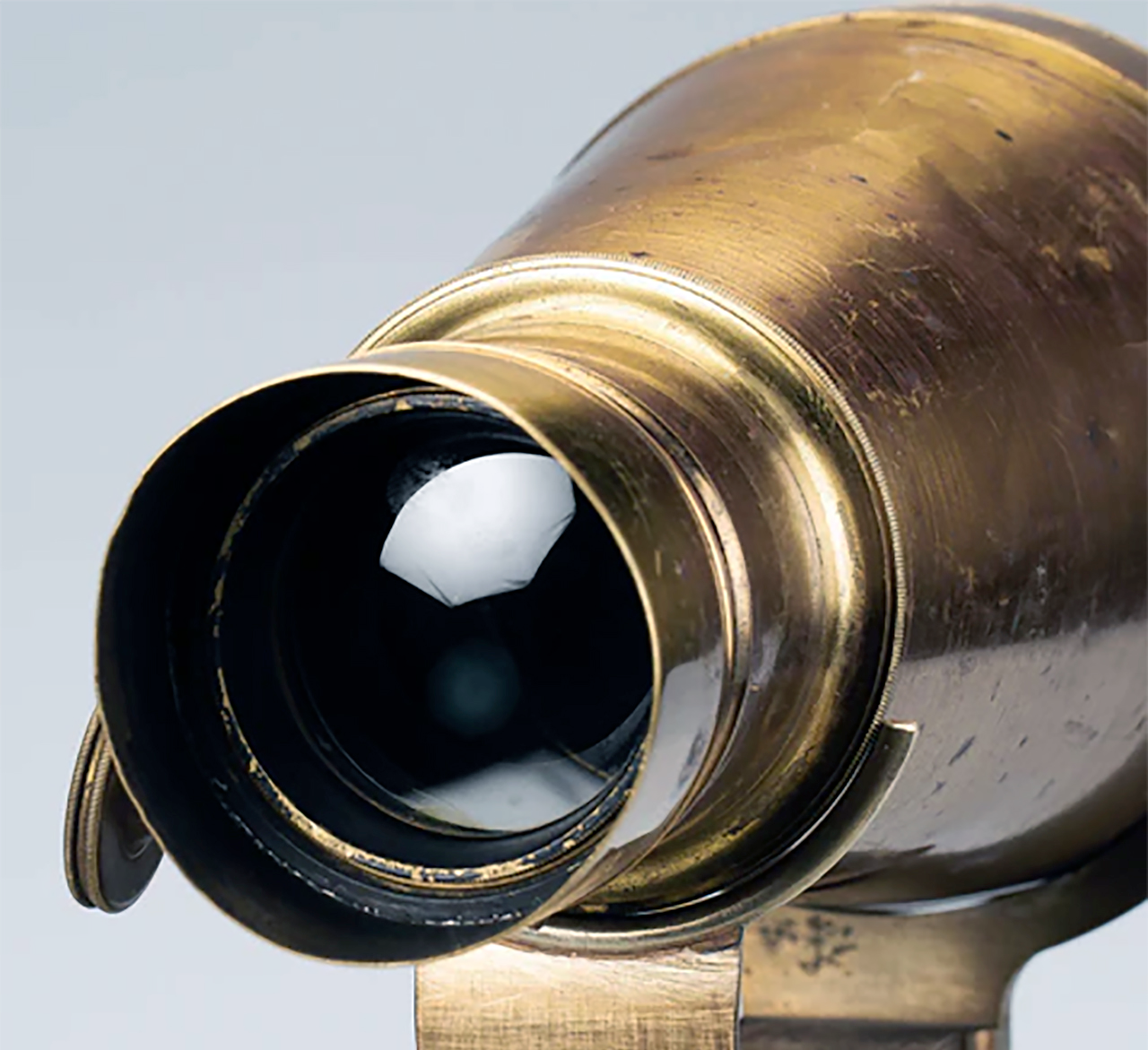
Detail of the famous Petzval lens with which Voigtländer made his name as a lens producer. This lens functioned for many decades as THE portrait lens for professional photography.
Voigtländer’s oddly shaped brass Daguerreotype camera
Resembling a cross between a thermos flask and a mortar bomb, Voigtländer’s camera was of all-metal construction. It consisted of a conical brass body with a Petzval lens at its apex. A shorter conical focusing attachment with a ground glass screen and a magnifying eyepiece could be screwed into the other end of the camera body.
In use, the camera rested in a cradle on top of a telescopic pillar. After focusing, using a rack and pinion mechanism, the camera was removed from the cradle and carried to a darkroom where the focusing attachment was removed and replaced by a plate holder containing a sensitized circular Daguerreotype plate.
The camera was then carefully repositioned on its stand and the exposure made by removing and replacing the lens cap. It is estimated that around 600 Voigtländer Daguerreotype cameras were sold, but only about a dozen examples of this iconic and seminal camera are known to have survived.
Over the years, however, the Voigtländer firm produced a number of replica versions of this, their very first camera. In 1939, 25 replicas were made to commemorate the centenary of the birth of photography.
In 1956, 200 were made to mark the 200th anniversary of the founding of the company and in 1978, a further 100 replicas were produced. These replicas are now also highly sought after by collectors and can be easily identified because they all carry the serial numbers 81 or 84.
Escape to Braunschweig
In 1845, Peter Voigtländer married the daughter of a respected Braunschweig lawyer, whom he met on one of his photographic sales journeys in Braunschweig.
Voigtländer had previously set up a branch sales office in Braunschweig, Duchy of Brunswick, at that time the central hub in the German rail network. Compared to Vienna, Braunschweig offered a location advantage regarding the distribution of Voigtländer objectives and Daguerreotype camera products due to the greater proximity to the German overseas ports.
During the rising social and political tensions in the Austrian Empire leading to the Revolutions of 1848, Peter Voigtländer had joined the political cause of the Democrats and also became adjutant to the commander of the Vienna national civil guard General Wenzel Messenhauser.
As the revolutions escalated during the Vienna Uprising of October 1848, the counter-revolution had strengthened with full force, and General Messenhauser of the revolting national civil guard, like many others were executed.
Voigtländer at that time had in perception of the power relations withdrawn from the Vienna national civil guard and with his family took refuge in a suburb of Vienna.
On the wishes of Peter Voigtländer’s wife and when the March revolutions of 1848 hindered the further development of the young photographic company, the family promptly re-located from Vienna to his wife’s hometown Braunschweig, where from 1849 Voigtländer established a subsidiary production site, granted on a provisional “Concession for the pursuit of a trade”, issued by the city directorate with a term of five years.
In September 1852, Peter Voigtländer was successfully awarded a so-called “land-cooperative” (German Markgenossenschaft) and issued the desired unrestricted “Concession for the pursuit of a trade” in the city Braunschweig.
In 1864, Peter Voigtländer was honoured by Emperor Franz Joseph I of Austria with the Knight’s Cross of the Order of Franz Joseph; becoming known as Peter Wilhelm Friedrich Ritter von Voigtländer. On the death of Voigtländer’s Vienna works manager, the Vienna business was closed in 1868.
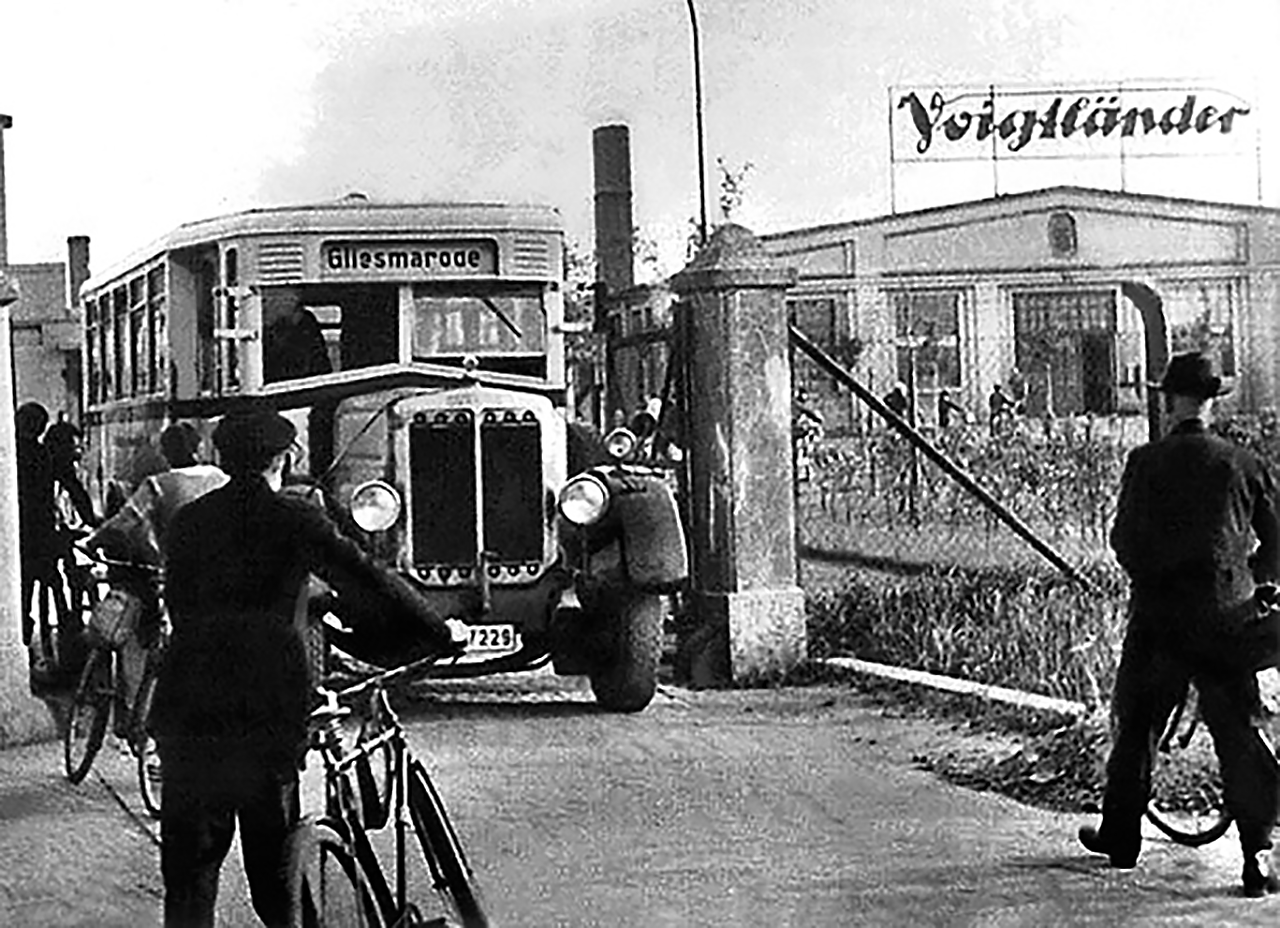
Main entrance to the Gliesmarode plant in Braunschweig. Beginning of work in 1938.
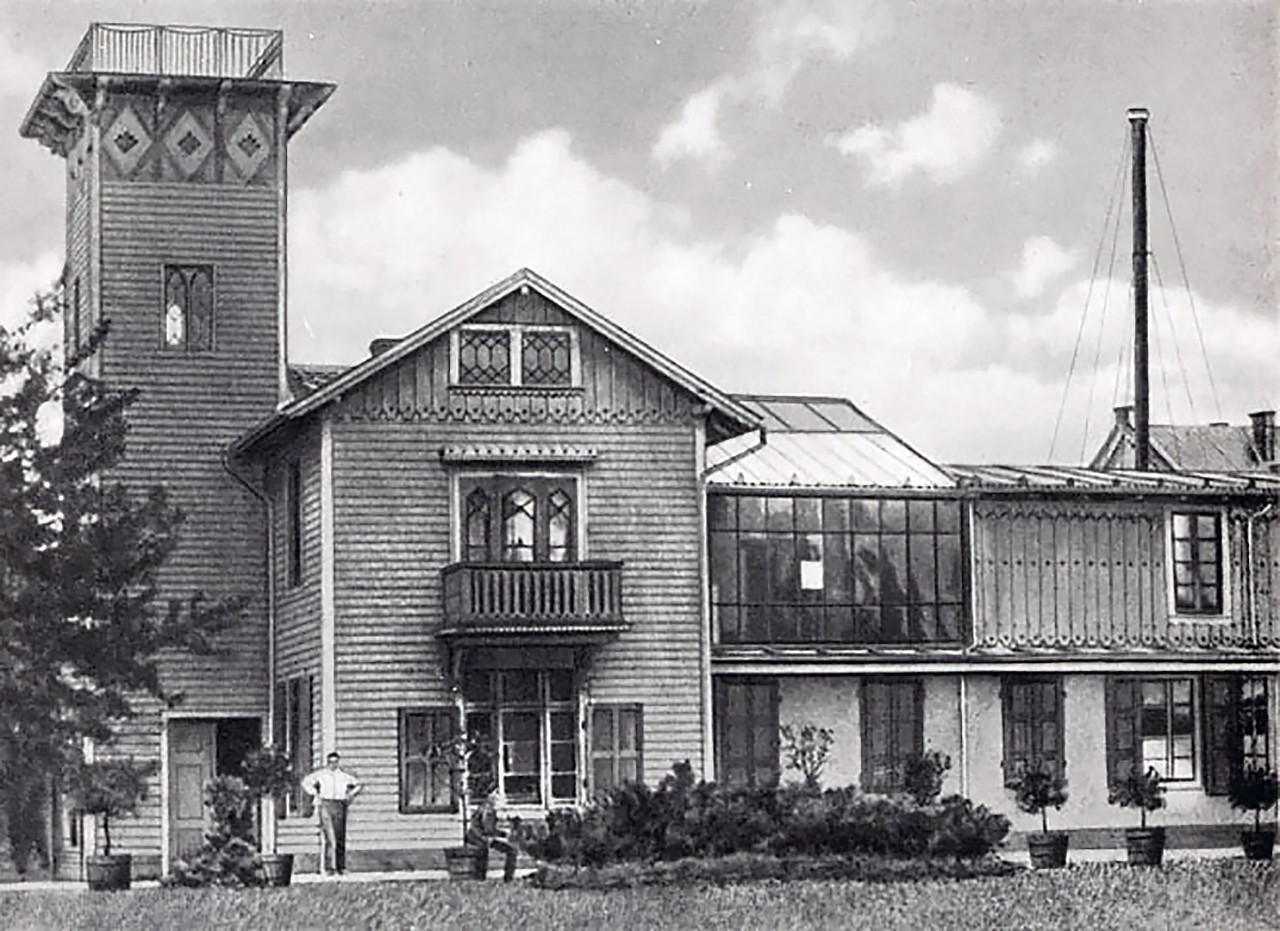
Plant Voigtländer & Sohn, location Campestraße 7 in Braunschweig from 1865. From the magazine “Tradition von 1962” or the former Voigtländer archive.
The Braunsweig period
In 1898 the company, until then family-owned, became a public company (i.e. sold shares on the stock market, becoming Voigtländer & Sohn AG). By 1915 the company had outgrown its buildings and moved to new premises in another part of Braunschweig. Unsurprisingly, the company made some military products during the First World War. Voigtländer remained independent after the War, when hard times caused some other firms to enter mergers. In 1920, Rudolf Heidecke and Paul Franke, employees of Voigtländer, left the firm to form Franke & Heidecke (their first camera, the Heidoscop, bears a striking similarity to Voigtländer’s Stereflektoskop.
In 1923 a majority of the shares (99.7%) were acquired by Schering AG’s photo division and large-scale production then took place in 1925. The company expanded its premises again in 1929. It was in the period of Schering’s ownership that many of the familiar Voigtländer cameras were made, including the first Bessa.
Voigtländer again made military equipment for Germany’s rearmament and the Second World War, but continued development of cameras at least up to shortly before the War itself. The Bessa 466 was designed around 1938! During this time parts of production were moved to the Wolfenbüttel district (still on the outskirts of Braunschweig), where prisoners of war were employed.
Schering sold its share of the company to the Carl Zeiss Foundation in 1956, and Zeiss-Ikon and Voigtländer-Vertriebsgesellschaft integrated in 1965. Due to falling sales, on 4 August 1971 Zeiss-Ikon/Voigtländer-Vertriebsgesellschaft ended producing cameras and closed the Voigtländer factory, which employed at the time 2,037 persons.
Subsequently, the company moved to the collective enterprise Optische Werke Voigtländer (Optical Works Voigtländer), in which Carl Zeiss AG, the state of Lower Saxony and the Braunschweig camera manufacturer Rollei each participated to one-third; Later Rollei took over all the shares. On the collapse of Rollei in 1982, Plusfoto took over the name, selling it in 1997 to Ringfoto. From 1999 until the present time, Voigtländer-branded products have been manufactured and marketed by the Japanese optics and camera company Cosina, under license from Ringfoto GmbH & Co. ALFO Marketing KG.
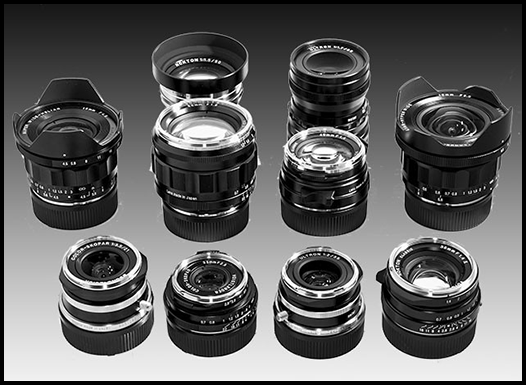
Voigtländer VM-Mount lenses for M-Mount Cameras
Despite the successful early metal camera designed by Voigtländer, lenses were the company’s main contribution to photography in the 19th century, and the success of Voigtländer’s camera lines of the 20th century was based on the quality of its lenses. At the turn of the 20th century, Voigtländer had a branch office in New York, Voigtlander & Son Optical Co. (with no umlaut), advertising Voigtländer lenses like the Dynar for use with the better Kodak cameras.
While still in Austria, Voigtländer introduced the Petzval lens, which became a standard lens for portrait photography. Voigtländer’s Petzval lenses were fitted to cameras of many makers. The lens has four elements, divided in two groups, the two front elements cemented, the two back elements just placed close to each other.
The lens has a characteristic vignetting and curvature of field, but it made images, which were very sharp in the centre. This and its wide aperture make it ideal for portraiture, though of little use for other photography; portrait photography was a big business, however.
In 1900 Carl August Hans Harting, working for Voigtländer produced another fast lens, the Heliar, a symmetric lens, improved by him as an asymmetric design in 1902. Other fine lens designs of that time were the Dynar and Kollinear (later Collinear) lenses. During the 20th century the Skopar and Colour Skopar lenses became the standard lenses for Voigtländer’s own cameras. Voigtländer also made the Zoomar, the world’s first interchangeable zoom lens, in 1959.
comprehensive Camera list
| Voigtländer cameras: | Years of manufacture: |
| Alpin | 1906-1927 |
| Alpin Rapid (prototype) | 1925 |
| Alpin Reflex | 1926 |
| Alpin Stereo-Panorama | 1911-1919 |
| Astro Stereflectoskop | 1949 |
| Avus | 1914-1935 |
| Beatrix | 1927-1930s |
| Bergheil 10×15 | 1914-1936 |
| Bergheil 4.5×6 (Baby) | 1919-1927 |
| Bergheil 4.5×6 (Baby) Deluxe | 1923-1927 |
| Bergheil 6.5×9 | 1923-1932 |
| Bergheil 6.5×9 green | 1932-1936 |
| Bergheil 9×12 | 1914-1932 |
| Bergheil 9×12 (oversized body) | c1925 |
| Bergheil 9×12 (w/focal plane shutter) | 1914-1932 |
| Bergheil 9×12 green | 1932-1936 |
| Bessa | 1929-1949 |
| Bessa 46 | 1938 |
| Bessa 466 | 1940 |
| Bessa 66 Baby Bessa | 1938 |
| Bessa I | 1950 |
| Bessa II | 1950-1951 |
| Bessa II ‘three crowns’ | 1953 |
| Bessa II Apo-Lanthar | 1950-1951 |
| Bessa II Ultragon | 1950-1951 |
| Bessa III 667 | 2009 |
| Bessa III 667 W | 2011 |
| Bessa L (black) | 1999-2003 |
| Bessa L (black) ‘100 Years Heliar’ | 2001 |
| Bessa L (chrome) | 1999-2003 |
| Bessa R | 2000-2002 |
| Bessa R2 | 2002-2004 |
| Bessa R2 A | 2004-2006 |
| Bessa R2 C | 2002-2005 |
| Bessa R2 M | 2004-2006 |
| Bessa R2 M (black) | 2004-2006 |
| Bessa R2 S | 2002-2005 |
| Bessa R2 S ‘NHS’ | 2006 |
| Bessa R3 A | 2004-2006 |
| Bessa R3 M | 2004-2006 |
| Bessa R4 A | 2006 |
| Bessa R4 M | 2006 |
| Bessa Rangefinder (RF, E-Messer) | 1936-1949 |
| Bessa T “101 years” (grey) | 2001-2004 |
| Bessa T ‘101 years’ (black) | 2001-2004 |
| Bessa T ‘101 years’ (blue) | 2001-2004 |
| Bessa T ‘101 years’ (olive) | 2001-2004 |
| Bessa T (black) | 2001-2004 |
| Bessa T (chrome) | 2001-2004 |
| Bessamatic | 1959-1962 |
| Bessamatic CS | 1967-1969 |
| Bessamatic Deluxe | 1962 |
| Bessamatic M | 1964 |
| Bessy | 1965 |
| Bessy AF | c1994 |
| Bessy AF Mini | c1994 |
| Bessy AF-P | c1994 |
| Bessy AF-P Date | c1994 |
| Bessy AK | 1965 |
| Bessy AS | 1966 |
| Bessy Automatic | 1970 |
| Bessy Electronic | 1970 |
| Bessy Electronic II | 1970-1971 |
| Bessy FF | c1994 |
| Bessy FF Mini | c1994 |
| Bessy K | 1965 |
| Bessy S | 1966 |
| Bijou Voigtlander | 1908 |
| Box Voigtlander | 1939 |
| Brillant (sheet metal) | 1932 |
| Brillant AF | c1994 |
| Voigtländer cameras: | Years of manufacture: |
| Brillant AF 1 | c1998 |
| Brillant AF 2 | c2001 |
| Brillant Bakelite | 1949 |
| Brillant V6 | 1937 |
| Brillant V6 (Heliar) | 1937 |
| Brillant with Focusing plate | 1938-1948 |
| Brunsviga | 1905 |
| CLS | 1982 |
| Comfort AF | c1998 |
| Daguerreotype (Metallcamera) | 1841 |
| Daguerreotype (Metallcamera, miniature display) | c1961 |
| Daguerreotype (Metallcamera, replica) | 1939-1978 |
| Dynamatic I | 1960-1962 |
| Dynamatic II | 1961-1962 |
| Dynamatic Mini AF | c1998 |
| Dynarkamera | 1905 |
| Film camera I | 1904 |
| Film camera II | 1904-1906 |
| Film camera III | 1904 |
| Flachkamera (Radiar) | c1911 |
| Flexomatic | 1960 |
| Heliar Reflex | 1906-1908 |
| Heliar camera I | 1903-1908 |
| Heliar camera II | 1908-1920s |
| Ifbaflex M 102 | c1970s |
| Inos I | 1931-1932 |
| Inos II | 1933-1935 |
| JubiIar | 1931 |
| Klappkamera-Stereo (Folding Camera) | 1903 |
| Metall-Flach-camera (slim) | 1911 |
| Metall-Klappkamera (Folding Camera) | 1905-1914 |
| Monorail | 1950-1954 |
| Nirvana | 1925 |
| Perkeo (3×4) | 1932 |
| Perkeo (3×4, Heliar) | 1932 |
| Perkeo E | 1955 |
| Perkeo I | 1950 |
| Perkeo I (prototype) | c1950 |
| Perkeo II | 1950 |
| Perkeo IIIe | 1955 |
| Petito | 1924-1927 |
| Phokina I | 1964 |
| Phokina II | 1964 |
| Phokina III | 1964 |
| Phokina IV | 1964 |
| Prominent | 1950-1957 |
| Prominent 6×9 | 1933 |
| Prominent 6×9 ‘Turbo-shutter’ | 1933 |
| Prominent II | 1958-1960 |
| Reisekamera (10×12) | c1910s |
| Reisekamera Model A (Field Camera) | 1904 |
| Reisekamera Model B (Field Camera) | 1904 |
| Reisekamera Model C (Field Camera) | 1904 |
| Report 1 | c1956 |
| RollFilm Camera | 1927-1930s |
| Saator Registrier-kamera (Sight Recorder) | 1940-1944 |
| Scheren-camera (scissors) | 1903 |
| Spiegelreflex camera (Mirror Reflex) | 1905-1925 |
| Spiegelreflex camera (Mirror Reflex, 1916) | 1916 |
| Spiegelreflex-Stereocamera (Mirror Reflex) | 1906 |
| Spreizenkamera (Expendable) | 1908 |
| Stereflektoskop 4.5×10.7 | 1914-1929 |
| Stereflektoskop 6×13 | 1925-1937 |
| Voigtländer cameras: | Years of manufacture: |
| Stereo Folding | 1905 |
| Stereopanorama Metal Camera | 1902-1914 |
| Stereophotoskop (1904) | 1904 |
| Stereophotoskop (1904, 45×107) | c1904-1908 |
| Stereophotoskop (1908) | 1908-1923 |
| Stereophotoskop (1923) | 1923-1926 |
| Stereoskop | 1902-1914 |
| Studiocamera | c1900s |
| Super Brillant AF | 1998 |
| Superb | 1933 |
| Superb Prototype | c1932 |
| Telestativ-camera | c1920 |
| Tourist | c1920 |
| Ultramatic | 1962 |
| Ultramatic AF-E | 1990-1993 |
| Ultramatic CS | 1965-1968 |
| Universal Salon-Apparat D | 1900-1923 |
| VAG | 1925-1934 |
| VF 101 (black) | 1975-1976 |
| VF 101 (chrome) | 1975-1976 |
| VF 102 | 1974-1978 |
| VF 135 | 1976-1980 |
| VF 35F | 1981 |
| VSL 1 (BM Singapore) | 1975-1979 |
| VSL 1 Gold | 1975 |
| VSL 1 TM | 1974 |
| VSL 1 TM (red) | 1974 |
| VSL 1 TM black Singapore | 1974-1976 |
| VSL 1 pre-series | 1974 |
| VSL 2 Automatic | 1976-1979 |
| VSL 2 CX Automatic | 1974 |
| VSL 3 (dummy prototype) | c1977 |
| VSL 3-E | 1977-1981 |
| Vida | 1910-1919 |
| Virtus | 1933 |
| Virtus APS | c1998 |
| Virtus Z2 | 1998 |
| Virtus Z3 | 1998 |
| Vitessa (Type 125) | 1950 |
| Vitessa (Type 125) Dummy | 1950 |
| Vitessa (Type 132) | 1952-1953 |
| Vitessa (Type 133) | 1954 |
| Vitessa (Type 134) (Vitessa N) | 1954 |
| Vitessa (Type 136) (Vitessa T) | 1956 |
| Vitessa (Type 140) (Vitessa L) | 1954 |
| Vitessa 1000 SR | 1968 |
| Vitessa 126 CS | 1968 |
| Vitessa 126 Electronic | 1968 |
| Vitessa 126 S | 1968 |
| Vitessa 126 S Electronic | 1968 |
| Vitessa 500 AE | 1968 |
| Vitessa 500 AE ‘Jacaranda-wood’ (Palisander) | 1968 |
| Vitessa 500 AE Electronic | 1968 |
| Vitessa 500 L | 1968 |
| Vitessa 500 S | 1967 |
| Vitessa 500 SE | 1968 |
| Vitessa 500 SE Electronic | 1968 |
| Vitessa 70 | 2000 |
| Vitessa AF | 1988 |
| Vitessa FM | 1988 |
| Vitessa FM II | 1988-1990 |
| Vito | 1940-1949 |
| Vito (post 1980) | 1983 |
| Vito 110 | 1998 |
| Vito 110 OD | 1998 |
| Vito 112 | 1998 |
| Vito 112 OD | 1998 |
| Vito 145 OD | 1998 |
| Vito 28-90 OD | 1998 |
| Vito 60 | 1999 |
| Vito 70 | 1984-1988 |
| Voigtländer cameras: | Years of manufacture: |
| Vito 70 C | 1998 |
| Vito 70 G OD | 1998 |
| Vito 70 OD | 1998 |
| Vito AF | 1984-1988 |
| Vito Automatic | 1961 |
| Vito Automatic I | 1963 |
| Vito Automatic II | 1962 |
| Vito Automatic R | 1963 |
| Vito B | 1954 |
| Vito B (II) | 1957 |
| Vito BL | 1956-1957 |
| Vito BL II | 1957 |
| Vito BR | 1958 |
| Vito C | 1960-1967 |
| Vito C (post 1980) | 1980 |
| Vito C-AF | 1984-1988 |
| Vito CD | 1960 |
| Vito CD Special | 1961 |
| Vito CE 35 (post 1980) | 1980 |
| Vito CL | 1962 |
| Vito CLR | 1962 |
| Vito CLR special | 1962 |
| Vito CS | 1967-1971 |
| Vito CS (post 1980) | 1983 |
| Vito CSR | 1967-1971 |
| Vito FM | 1984-1988 |
| Vito II | 1950-1954 |
| Vito II (prototype) | 1950 |
| Vito III | 1951 |
| Vito III Prototype | 1949 |
| Vito IIa | 1955 |
| Vito LS special | 1964 |
| Vito Prototype | c1951 |
| Vito TF | 1984-1988 |
| Vito special | 1964 |
| Vitoflex CA (prototype) | c1977 |
| Vitoflex E | 1977 |
| Vitolux 115 OD | 1998 |
| Vitolux Comfort AF | 1998 |
| Vitomatic 105 | 1994 |
| Vitomatic 140 | 1999 |
| Vitomatic AF Zoom | 1989 |
| Vitomatic I | 1957-1960 |
| Vitomatic I CS | 1967 |
| Vitomatic II | 1958 |
| Vitomatic II CS | 1967 |
| Vitomatic III CS | 1967-1969 |
| Vitomatic IIIa | c1964 |
| Vitomatic IIIb | 1964-1967 |
| Vitomatic IIa | 1960-1963 |
| Vitomatic IIa Ultron | 1960-1963 |
| Vitomatic IIb | 1964-1967 |
| Vitomatic Ia | 1960-1963 |
| Vitomatic Ib | 1964-1967 |
| Vitoret | 1962-1971 |
| Vitoret 110 | 1976-1978 |
| Vitoret 110 EL | 1978-1981 |
| Vitoret AF | 1990-1994 |
| Vitoret Colora F | 1965-1967 |
| Vitoret D | 1962-1971 |
| Vitoret D Rapid | 1965 |
| Vitoret DR | 1964-1971 |
| Vitoret F | 1963-1965 |
| Vitoret L | 1964-1966 |
| Vitoret LR | 1966-1971 |
| Vitoret M | 1987-1989 |
| Vitoret R | 1963-1965 |
| Vitoret S | 1970-1971 |
| Vitrona | 1964 |
| Vitrona AF | 1987-1989 |
| Voigtlander Studio | 1950-1955 |

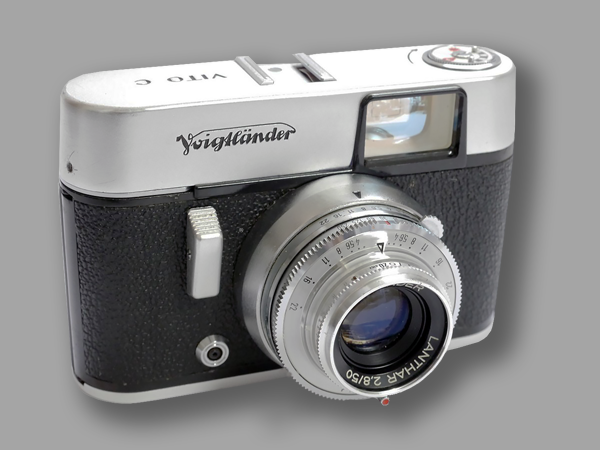
Voigtlander Vito C 35mm camera with 50mm f2.8 Lanthar lens in Pronto shutter.
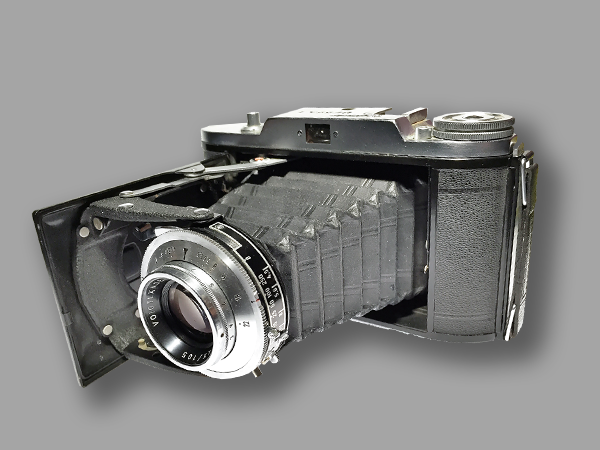
The Voigtlander Bessa I folding 6×9 medium format camera with lens extended.
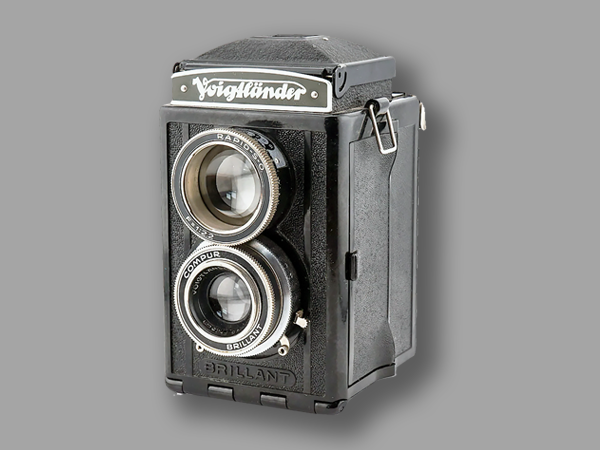
Voigtländer Brillant – Camera Compact & basic TLR, released in 1932.
FOUNDING DATE: 1945
FOUNDERS: Waldemar Krause and Eduard Moyzes
COMPANY NAMES:
1945: Fredeborch Stanzerei GmbH Nordenham; 1970: The company stopped camera production. 1986: the company went bankrupt.
COMPANY ADDRESS:
1945: Atenser Carl-Zeiss-Weg, Nordenham.
Vredeborch Vredeboxes: these Cameras built in Nordenham were easy-to-use and inexpensive. The company manufactured mostly box-type cameras under its own name as well as for other distributors.
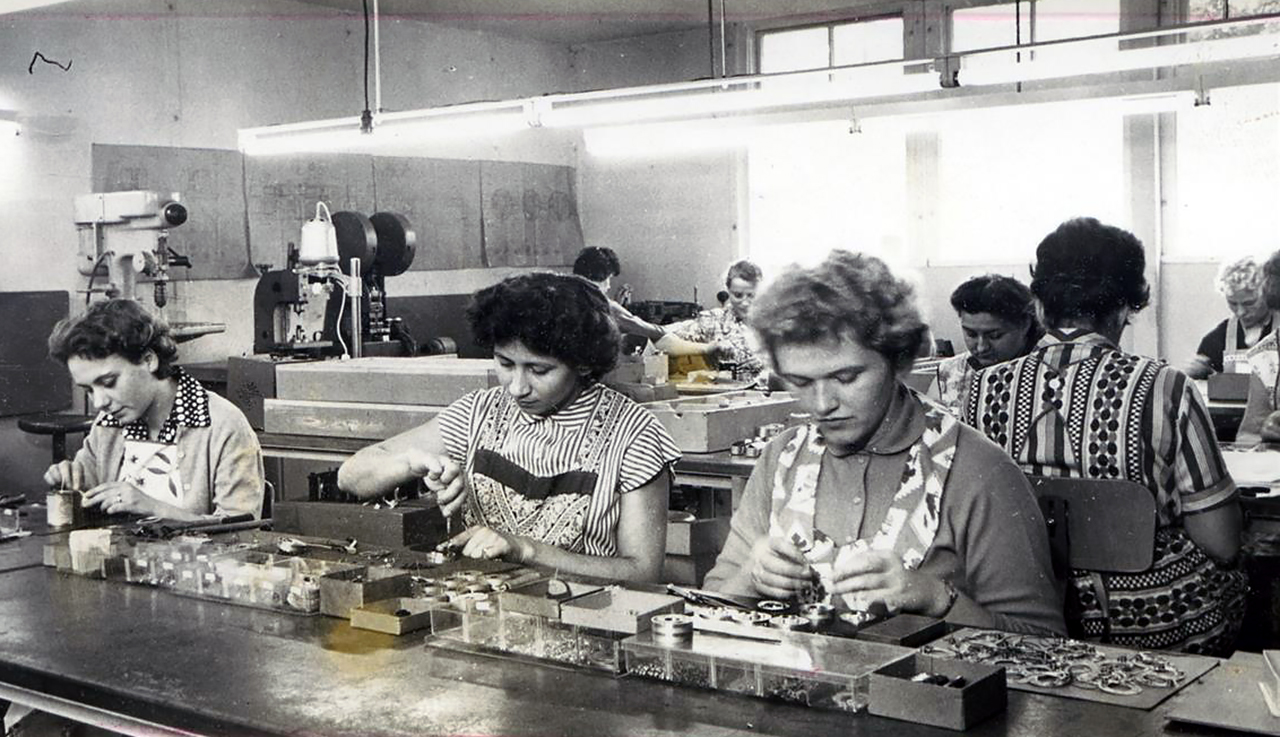
The work in sub-assembly at Vredeborch was mainly done by women. The picture was taken in 1960.
On November 10, 1945, Eduard Moyzes and Waldemar Krause registered the “Fredeborch Stanzerei GmbH Nordenham”. Production found place on the site of what was then the shooting range of the Germania Warriors’ Association south of Friedeburg Park. The name of the company comes from the Vredeborch castle (Friedeburg in standard German; Peace Castle in English) established at the beginning of the city’s history, 1404.
The office and workshop initially consisted of two railway wagons.In the beginning, supplier parts for agricultural machinery, key plates and much more were manufactured.Everything that was needed after the war.
In 1948, the company owners came up with the idea of building box cameras out of sheet metal. An American box camera gave the Vredeborch founders, Waldemar Krause and Eduard Moyzes, the impetus for camera production in Nordenham in 1948. They succeeded in replicating the original device made of wood and cardboard now in the metal. The beginning of a success story.
Large quantities of box cameras were manufactured, many for other distributors. From 1953, other types of mostly simple cameras were manufactured. At its peak, the Vredeborch factory employed up to 160 people. The company stopped camera production in 1970s. On May 9, 1986, the company was declared bankrupt.
survey of vredeborch cameras and brand-labelled items

Several of its cameras were sold under names given by other distributors.
vredeborch
Box Cameras
- Vrede Box – 1950
- Standard Menis – 1949
- Standard Menis 49 – 1949
- Standard Menis – 1950
- Standard-S Menis – 1949
- Paloma Menis – 1950
- Paloma-S Menis – 1950
- Synchrona – 1950 – 1953

City planner Tim Lorenz collects old cameras from the former Nordenham company Vredeborch. There are around 40 old cameras on the table in town planner Tim Lorenz’s living room. They are called Filmor, Alka, Reporter, Nordino or Baby Finazzy. All these cameras were produced in Nordenham between 1948 and 1970. The production facility was then in the building where Tim Lorenz lives today at the Carl-Zeiss-Weg. The Vredeborch camera factory used to be here.
names of Brand-
labelled box Cameras
- Adina – 1953
- Alfa – 1950s
- Alfor Box – 1953
- Alfor Synchro Box – 1950 – 1953
- Alka Box – 1953
- Baby Aleata – 1955
- Baby Finazzi – 1953
- Bungalow – 1953
- Ecla Box – 1950
- Edi Box – 1960
- Eldorado Box – c1950s
- Eldorado Box (green)- c1950s
- Eros – 1955
- Evans Box – 1950
- Evans Filter Flash Box – 1950
- Evede – 1955
- Fenix-Box – 1955
- Filmor – 1955
- Fodor-Box
- Fodor-Box Synchrona
- Fotolux 68 – 1969
- G M Box – 1953
- Haaga Synchrona – 1955
- Hanimex Box Standard
- Kruxo Favorit – 1950
- Kuoman – 1950
- Manex – 1950
names of Brand-
labelled box Cameras
- Monty Box – 1950
- N-Box – 1955
- Optomax- Syncrona
- Photopia Popular 120 Box – 1952
- Regia Box – 1950
- Slomexa – 1950
- Standard Union – 1949
- Synchrona 120 1950 – 1953
- Texar – 1950
- Trumpf – 1955
- Union – 1950
names of Brand-
labelled Viewfinder Cameras
- Bunny – 1960
- Eros – 1955
- Excella
Felinette/Felicette/
Felicetta series
- Felica – c1957
- Felica Duo – c1958
- Felinette – 1959
- Felicette – 1963
- Felicette L – 1963
- Felicetta – 1965 – 1972
- Felicetta BL 35 – 1965 – 1972
- Felicetta L – 1963
Felinette/Felicette/
Felicetta series
- Felita – 1955 – 1957
- Fotolux 68 – 1969
- Hanseatic Super – 1961
- Ideal – 1950
- Joy Box – 1953
- Junior – 1954
- Junior 35 – 1970
- Junior Super – 1965
- Kera Junior – 1961
- Kera Super – 1961
- Keva
- Klimax – 1950
- Necka-Junior – 1961
- Nordetta 3D (stereo camera) – 1951
- Nordina – 1952- 1953
- Nordina 28 C – 1966
- Nordina I / II / III – 1953
- Paloma
- Panorama 35 – 1965
- Panorama LR 35 – 1965
- Reporter Junior – 1950
- Reporter Junior II – 1950
- Reporter Sunchrona – 1959
- Stafetta – 1950
- Stafetta Duo – 1950
- Standard – 1949
- Super – 1960
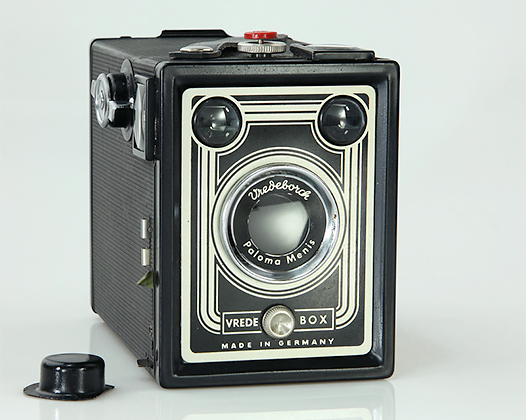
Vrede-Box Paloma Menis 1950
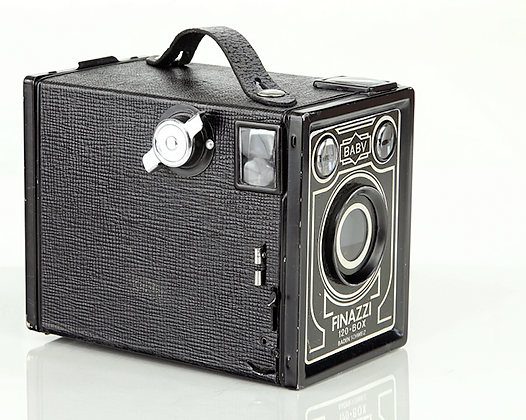
Vredeborch Baby Finazzi 120 Box ~1950
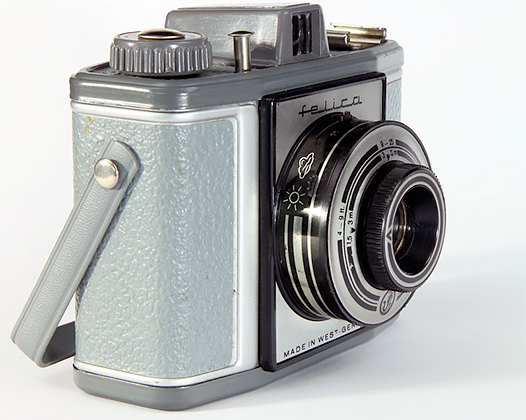
Vredeborch Felica 1958
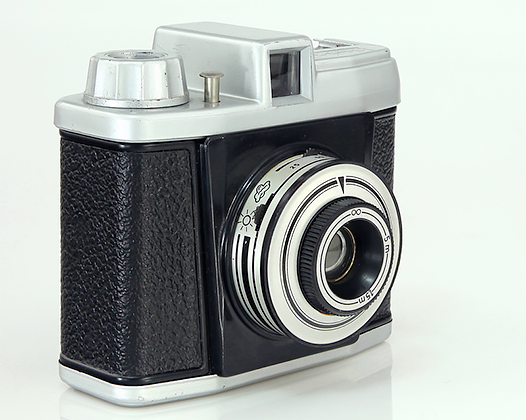
Vredeborch Super 1965


